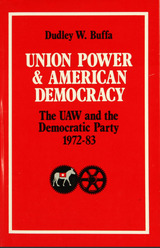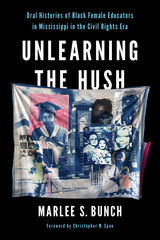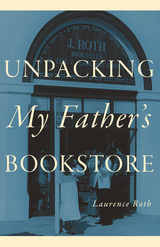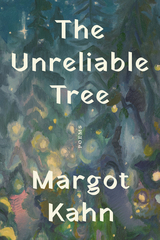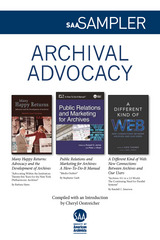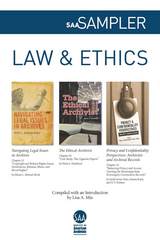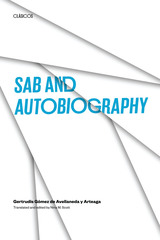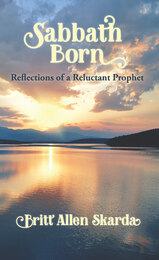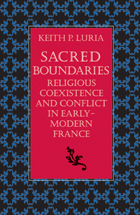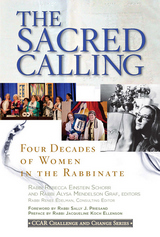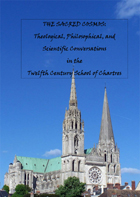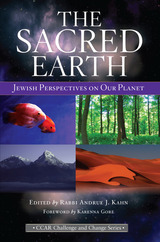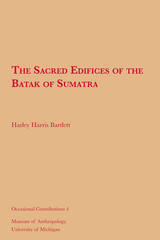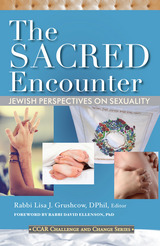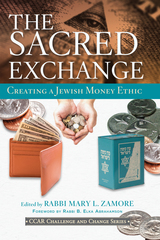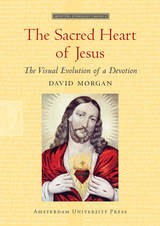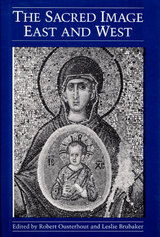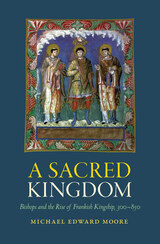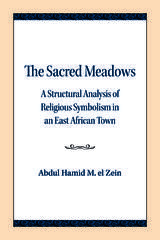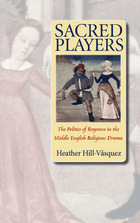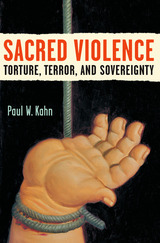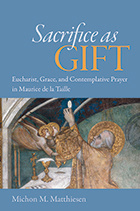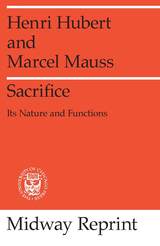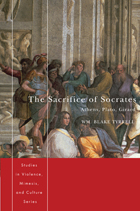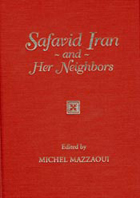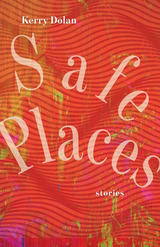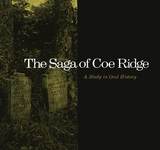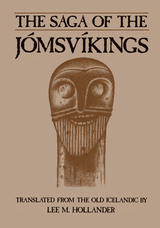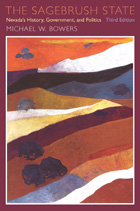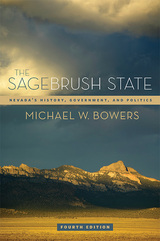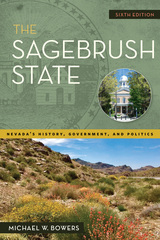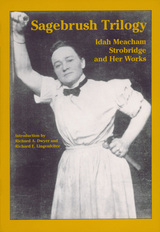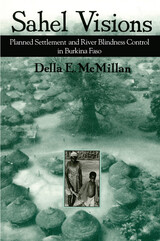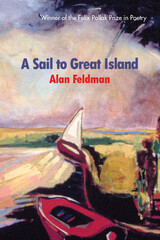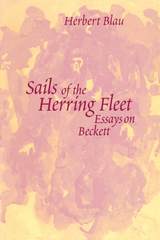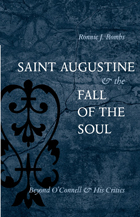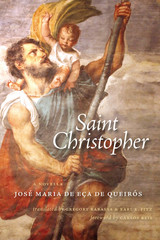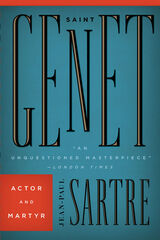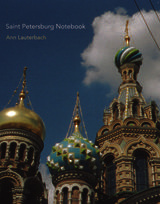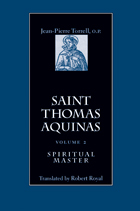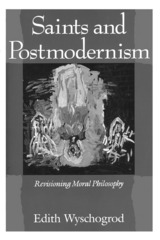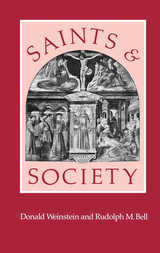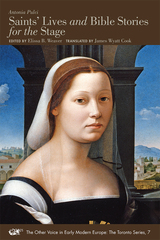 S. L. Frank: The Life And Work Of A Russian Philosopher, 1877-1950
Philip Boobbyer
Ohio University Press, 1995 “There are many reasons for writing a biography of Semyon Frank. Quite apart from his philosophy, he lived a remarkable life. Born in Moscow in 1877, he was exiled from Soviet Russia in 1922 and died in London in 1950. The son of a Jewish doctor, he became a revolutionary Social Democrat in his teens and finished his life as a Neoplatonist Christian. One of the Russian revisionist Marxists, he was then involved in the Kadet Party during the 1905 revolution before breaking with active political activity and turning to philosophy. He lived in Petrograd through the First World War until September 1917, after which he went to Saratov, where he experienced the chaos of the Russian Civil War. Living in Germany after his exile, he witnessed the rise of Hitler in Berlin, left for France in a hurry in 1937, and spent part of the war hiding from the Gestapo in the Grenoble mountains. It was a life that encompassed a lot of history. ”Yet along with this, Frank was arguably Russia’s greatest twentieth-century philosopher. Indeed, V.V. Zen‘kovskii, the historian of Russian philosophy, considered Frank ’in strength of philosophic vision … the most outstanding among Russian philosophers generally — not merely among those who share his ideas.‘ For its lucidity, conciseness, systematic character, and unity, Zen’kovskii considered Frank’s system ‘ the highest achievement … of Russian philosophy.’ Doubtless, Zen‘kovskii’s assessment is disputable, but his remarks emphasize Frank’s stature in the Russian tradition. In the style of German idealism, Frank constructed a comprehensive philosophical system, which he believed offered a coherent alternative to materialism. He was deeply worried by the implications of epistemological relativism and constructed a system of metaphysics designed to link epistemology and ontology, to bridge the gulf between thought and being. In addition, he attempted to express the idea of a personal God in philosophical language. His system also embraced social philosophy, anthropology, and ethics.“ — from the Introduction by the author
SAA Sampler: Archival Advocacy
Cheryl Oestreicher
Society of American Archivists, 2013 The SAA Sampler Series features collections of select chapters from authoritative books on archives published by the Society of American Archivists. Produced exclusively electronically, the samplers are designed to give readers an overview of a pertinent topic as well as a taste of the full publications.
In this volume you'll discover three outstanding pieces on archival advocacy drawn from books published by the Society of American Archivists: MANY HAPPY RETURNS: ADVOCACY AND THE DEVELOPMENT OF ARCHIVES; PUBLIC RELATIONS AND MARKETING FOR ARCHIVES; and A DIFFERENT KIND OF WEB: NEW CONNECTIONS BETWEEN ARCHIVES AND OUR USERS.
SAA Sampler: Law & Ethics
Lisa A. Mix
Society of American Archivists, 2013 The SAA Sampler Series features collections of select chapters from authoritative books on archives published by the Society of American Archivists. Produced exclusively electronically, the samplers are designed to give readers an overview of a pertinent topic as well as a taste of the full publications.
In this volume you'll discover three outstanding pieces on legal and ethical issues for archivists--one overview of copyright and two case studies dealing with privacy and access--drawn from three books published by the Society of American Archivists: NAVIGATING LEGAL ISSUES IN ARCHIVES, THE ETHICAL ARCHIVIST, and PRIVACY AND CONFIDENTIALITY PERSPECTIVES: ARCHIVISTS AND ARCHIVAL RECORDS.
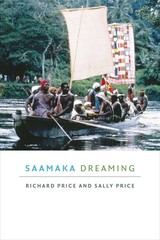 Saamaka Dreaming
Richard Price and Sally Price
Duke University Press, 2017 When Richard and Sally Price stepped out of the canoe to begin their fieldwork with the Saamaka Maroons of Suriname in 1966, they were met with a mixture of curiosity, suspicion, ambivalence, hostility, and fascination. With their gradual acceptance into the community they undertook the work that would shape their careers and influence the study of African American societies throughout the hemisphere for decades to come. In Saamaka Dreaming they look back on the experience, reflecting on a discipline and a society that are considerably different today. Drawing on thousands of pages of field notes, as well as recordings, file cards, photos, and sketches, the Prices retell and comment on the most intensive fieldwork of their careers, evoke the joys and hardships of building relationships and trust, and outline their personal adaptation to this unfamiliar universe. The book is at once a moving human story, a portrait of a remarkable society, and a thought-provoking revelation about the development of anthropology over the past half-century.
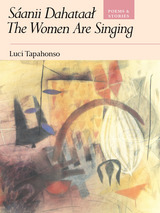 Sáanii Dahataal/The Women Are Singing: Poems and Stories
Luci Tapahonso
University of Arizona Press, 1993 In this cycle of poetry and stories, Navajo writer Luci Tapahonso shares memories of her home in Shiprock, New Mexico, and of the places and people there. Through these celebrations of birth, partings, and reunions, this gifted writer displays both her love of the Navajo world and her resonant use of language. Blending memoir and fiction in the storytelling style common to many Indian traditions, Tapahonso's writing shows that life and death are intertwined, and that the Navajo people live with the knowledge that identity is formed by knowing about the people to whom one belongs. The use of both English and Navajo in her work creates an interplay that may also give readers a new way of understanding their connectedness to their own inner lives and to other people.
Luci Tapahonso shows how the details of everyday life—whether the tragedy of losing a loved one or the joy of raising children, or simply drinking coffee with her uncle—bear evidence of cultural endurance and continuity. Through her work, readers may come to better appreciate the different perceptions that come from women's lives.
Sab and Autobiography
By Gertrudis Gómez de Avellaneda y Arteaga
University of Texas Press, 1993 Eleven years before Uncle Tom's Cabin fanned the fires of abolition in North America, an aristocratic Cuban woman told an impassioned story of the fatal love of a mulatto slave for his white owner's daughter. So controversial was Sab's theme of miscegenation and its parallel between the powerlessness and enslavement of blacks and the economic and matrimonial subservience of women that the book was not published in Cuba until 1914, seventy-three years after its original 1841 publication in Spain. Also included in the volume is Avellaneda's Autobiography (1839), whose portrait of an intelligent, flamboyant woman struggling against the restrictions of her era amplifies the novel's exploration of the patriarchal oppression of minorities and women.
Sabas, Leader of Palestinian Monasticism: A Comparative Study in Eastern Monasticism, Fourth to Seventh Centuries
Joseph Patrich
Harvard University Press The impact of the life of Sabas and his exceptional system of monastic life has endured from the fifth century to the present. The monastery of Mar Saba, suspended on cliff tops in a breathtaking location, is a monument attesting Sabas’s lasting influence. Sabas, Leader of Palestinian Monasticism is grounded in both literary sources from the fourth to seventh century, mainly in Greek, as well as in archaeological research conducted near the monastery. Joseph Patrich examines the historical framework and contributions Sabas made to Palestinian monasticism, from his role as founder and abbot to the theological struggles after his death.
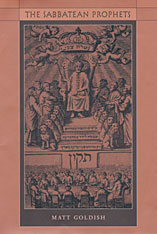 The Sabbatean Prophets
Matt Goldish
Harvard University Press, 2004 In the mid-seventeenth century, Shabbatai Zvi, a rabbi from Izmir, claimed to be the Jewish messiah, and convinced a great many Jews to believe him. The movement surrounding this messianic pretender was enormous, and Shabbatai's mission seemed to be affirmed by the numerous supporting prophecies of believers. The story of Shabbatai and his prophets has mainly been explored by specialists in Jewish mysticism. Only a few scholars have placed this large-scale movement in its social and historical context.
Matt Goldish shifts the focus of Sabbatean studies from the theology of Lurianic Kabbalah to the widespread seventeenth-century belief in latter-day prophecy. The intense expectations of the messiah in Christianity, Judaism, and Islam form the necessary backdrop for understanding the success of Sabbateanism. The seventeenth century was a time of deep intellectual and political ferment as Europe moved into the modern era. The strains of the Jewish mysticism, Christian millenarianism, scientific innovation, and political transformation all contributed to the development of the Sabbatean movement.
By placing Sabbateanism in this broad cultural context, Goldish integrates this Jewish messianic movement into the early modern world, making its story accessible to scholars and students alike.
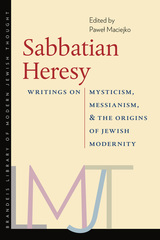 Sabbatian Heresy: Writings on Mysticism, Messianism, and the Origins of Jewish Modernity
Edited by Pawel Maciejko
Brandeis University Press, 2017 The pronouncements of Sabbatai Tsevi (1626–76) gave rise to Sabbatianism, a key messianic movement in Judaism that spread across Jewish communities in Europe, Asia, and North Africa. The movement, which featured a set of theological doctrines in which Jewish Kabbalistic tradition merged with Muslim and later Christian elements, suffered a setback with Tsevi’s conversion to Islam in 1666. Nonetheless, for another hundred and fifty years, Sabbatianism continued to exist as a heretical underground movement. It provoked intense opposition from rabbinic authorities for another century and had a significant impact on central developments of later Judaism, such as the Haskalah, the Reform movement, Hasidism, and the secularization of Jewish society. This volume provides a selection of the most original and influential texts composed by Sabbatai Tsevi and his followers, complemented by fragments of the works of their rabbinic opponents and contemporary observers and some literary works inspired by Sabbatianism. An introduction and annotations by Pawel Maciejko provide historical, political, and social context for the documents.
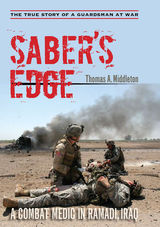 Saber’s Edge: A Combat Medic in Ramadi, Iraq
Thomas A. Middleton
University Press of New England, 2010 The National Guardsman, the citizen soldier called upon to fight for this nation in a time of war, is one of the least understood — and perhaps one of the most compelling — figures of the Iraq War. Saber’s Edge is the story of a middle-aged Vermont firefighter called upon to be a soldier in the worst place on earth — Ramadi, Iraq. In a few short weeks Thomas A. Middleton went from being a suburban dad to a combat medic traveling between platoons, filling in for other medics and engaging in some of the fiercest and most crucial fighting of the war. This is the war as experienced from the ground level: days of tedium interspersed with the adrenalin of combat; moments of lighthearted laughter broken by the sorrow of loss. This is also the story of the unique wartime perspective of our guardsmen. Unlike the raw, unformed young recruit, the mature guardsman often comes with the burdens of family, experience, and a developed sense of self. Accordingly, Sgt. Middleton’s story chronicles the inner conflict created by his long-time professional role as a healer and his newfound life as a warrior in the urban battlefields of Iraq. Thrust into a culture and theater of war that he is little equipped or trained for, the author tries to make sense of his actions. Coarsened by combat and increasingly disdainful of the local population, he receives solace and insight from his life-long faith and ultimately emerges as a man who understands his role in the world. Saber’s Edge is also the story of the Green Mountain Boys of Task Force Saber: a story of comradeship and communion amid fierce street fighting in a crucial theater of the Iraq War (the eventual site of the “Al Anbar Awakening”). Based on the author’s first-hand experiences and interviews with other soldiers, Saber’s Edge presents a riveting account of modern urban warfare and the inspiring story of one man reconciling his actions in warfare.
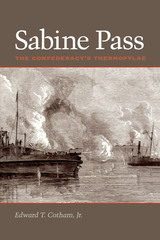 Sabine Pass: The Confederacy's Thermopylae
By Edward T. Cotham, Jr.
University of Texas Press, 2004 Winner, Dan and Marilyn Laney Prize, Austin Civil War Round Table, 2005 In an 1882 speech, former Confederate president Jefferson Davis made an exuberant claim: "That battle at Sabine Pass was more remarkable than the battle at Thermopylae." Indeed, Sabine Pass was the site of one of the most decisive Civil War battles fought in Texas. But unlike the Spartans, who succumbed to overwhelming Persian forces at Thermopylae more than two thousand years before, the Confederate underdogs triumphed in a battle that over time has become steeped in hyperbole. Providing a meticulously researched, scholarly account of this remarkable victory, Sabine Pass at last separates the legends from the evidence. In arresting prose, Edward T. Cotham, Jr., recounts the momentous hours of September 8, 1863, during which a handful of Texans—almost all of Irish descent—under the leadership of Houston saloonkeeper Richard W. Dowling, prevented a Union military force of more than 5,000 men, 22 transport vessels, and 4 gunboats from occupying Sabine Pass, the starting place for a large invasion that would soon have given the Union control of Texas. Sabine Pass sheds new light on previously overlooked details, such as the design and construction of the fort (Fort Griffin) that Dowling and his men defended, and includes the battle report prepared by Dowling himself. The result is a portrait of a mythic event that is even more provocative when stripped of embellishment.
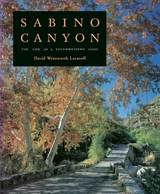 Sabino Canyon: The Life of a Southwestern Oasis
David Wentworth Lazaroff
University of Arizona Press, 1993 Nestled in the Santa Catalina Mountains near Tucson, Arizona, Sabino Canyon demonstrates the beauty and resiliency of life in what many would assume to be a most inhospitable place. For thousands of visitors each year, this oasis in the Sonoran Desert offers the opportunity to experience biodiversity in action.
David Lazaroff has called on years of studying, photographing, and educating people about Sabino Canyon to produce this clearly written and beautifully illustrated book. Focusing on the importance of Sabino Creek both to plants and animals and to human recreation, he tracks the ebb and flow of canyon life through the year and tells how people have sought to utilize the canyon through history. First-time visitors to Sabino Canyon will find their experience enriched through Lazaroff's insights into plants, animals, and geology, while those who regularly frequent Sabino's trails or pools can become better informed about its fragile desert and riparian habitats.
For anyone curious about life in a genuine Southwestern oasis, this book captures the beauty and uniqueness of a natural treasure-house located in a bustling city's back yard.
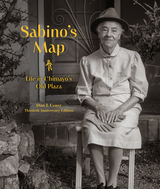 Sabino's Map: Life in Chimayó’s Old Plaza, Thirtieth Anniversary Edition
Don J. Usner
Museum of New Mexico Press, 2024 “Now, as I contemplate stepping into a role as [Chimayó] elder, I hope the sentiment of community endures and that this book inspires new generations of Chimayosos to continue building toward a bright future—while remaining rooted firmly in a remarkable history.”—Don J. Usner, from the Preface (2024)
“Brimming with voices, las voces de la gente…. the first-person narrator who returns again and again to the text like a knowing and trusted pariente inviting the reader to sit for a while in the Plaza del Cerro. —Jim Sagel
“Quite simply…the best history yet made of a northern New Mexico community. It is thorough, balanced, gracefully written, and blessed with an insider’s access and affection.”—William De Buys
Chimayó is renowned for its Hispano master weaving families, lowriders, and its storied church, El Santurio de Chimayó. The old Plaza del Cerro had once been the village’s center place, where locals gathered to pick up mail, socialize and celebrate religious and family events. Over the years after WWII, the plaza was neglected, but the memory of the once-vibrant place remained vivid in the stories of village elders.
The first edition of Sabino’s Map, published in 1995, documented oral histories of these elders. It would prove to be a critical turning point for many Chimayosos. At the Chimayó book launch, Usner recalls locals embraced the book, one cousin of his even declaring, “For the first time in my life I feel like I can be proud to be from Chimayó.” In the past thirty years since its publication, the community and its people have been revitalized with the help of the Chimayó Cultural Preservation Association and the establishment of a museum on the old plaza—in the home of Usner’s ancestors.
This landmark publication, read and passed on through generations, is considered a classic of New Mexico literature, alongside other treasured books including John Nichols’s Milagro Beanfield War, Rudolfo Anaya’s Bless Me Ultima, and Ruben Cobos’s Dictionary of New Mexico and Northern New Mexico Spanish.
 Sabra and Shatila: September 1982
Bayan Nuwayhed Al-Hout
Pluto Press, 2004 The book covers the history of the Sabra and Shatila massacre, which took place over three bloody days in the Lebanese capital Beirut. It was committed against Palestinian refugees by Lebanese militias, aided and supervised by the Israeli Army, which had encircled the district.
Now available for the first time in English, this classic book is the most comprehensive, authoritative account of what happened and who was responsible. The author, Bayan Nuwayhed al-Hout, was a Professor at the Lebanese University at the time. Driven by the horror of what occurred, she interviewed survivors and set up an oral history project immediately after the massacre to preserve testimonies. This book is the result.
Following a general introduction, the first part contains interviews mainly with victims' families. The second part analyses statistical data and attempts to determine the number of victims. The conclusion, 'Who Was Responsible?', sheds light on the various parties responsible.
Over five-hundred pages long, illustrated with photographs and maps, unrivalled in detail and scope, this book is a courageous attempt to make sense of what happened and an important political document in its own right.
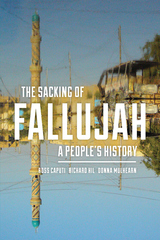 The Sacking of Fallujah: A People's History
Ross Caputi
University of Massachusetts Press, 2019 The Iraqi city of Fallujah has become an epicenter of geopolitical conflict, where foreign powers and non-state actors have repeatedly waged war in residential neighborhoods with staggering humanitarian consequences. The Sacking of Fallujah is the first comprehensive study of the three recent sieges of this city, including those by the United States in 2004 and the Iraqi-led operation to defeat ISIS in 2016.
Unlike dominant military accounts that focus on American soldiers and U.S. leaders and perpetuate the myth that the United States "liberated" the city, this book argues that Fallujah was destroyed by coalition forces, leaving public health crises, political destabilization, and mass civilian casualties in their wake. This meticulously researched account cuts through the propaganda to uncover the lived experiences of Fallujans under siege and occupation, and contextualizes these events within a broader history of U.S. policy in the Middle East. Relying on testimony from Iraqi civilians, the work of independent journalists, and documentation from human rights organizations, Ross Caputi, Richard Hil, and Donna Mulhearn place the experiences of Fallujah's residents at the center of this city's recent history.
 Sacralization of History in Times of Crises: Modern Eastern Europe
Liliya Berezhnaya
Central European University Press, 2026 This book explores the sacralization of history with a focus on modern Eastern Europe where the erasure of Soviet traditions has triggered a search for specific “usable pasts”. It discusses the importance of sacralization in memory and identity-building politics and the complex interplay between religion, history, and identity, particularly within the context of crises and conflict situations, by showing the historical roots of these processes.
The contributors seek to identify the political, societal and religious actors promoting the sacralization of history. They consider which networks promote sacralized visions of history and who is excluded from the sacralized community of national belonging. They also explore which historical topics seem best suited for the sacralization of history and question what happens to the rituals, objects, or spaces, formerly regarded as sacral: are they profaned, neglected, or re-inscribed by new national histories, and is there a religious language of national history? These are the major questions of this book.
 The Sacralization of Politics in Fascist Italy
Emilio Gentile
Harvard University Press, 1996 Fascism was the first and prime instance of a modern political religion. Rereading signs, symbols, cults, and myths, Italy's leading scholar of Fascism offers a new history of Italian nationalism as a civic religion, albeit in its extreme form, and of Italian Fascism as a vital catalyst for contemporary mass politics. Emilio Gentile decodes Italy culturally, going beyond political and social dimensions that explain Italy's Fascist past in terms of class, or the cynicism of its leaders, or modernizing and expansionist ambitions.
By looking back at the Risorgimento's civic and moral renewal of the Italians as a free people educated in the faith and worship of a "national religion," at the jarring countereffects of the secularized nation-state not trusting mass political mobilization, and at Fascism's retrieval of history from Rome, the French Revolution, and Romanticism, Gentile reconstructs the cultural configurations of a sacred politics. He shows how Mussolini used the concept of propaganda as a project in civic pedagogy, and how the Fascists thus cultivated a new consciousness that filled the void left by the decline of traditional religion. Fascism mobilized the masses through spectacle and public ceremony in an effort to conquer and shape the mentality and customs of a still emerging nation.
 Sacralizing Violence in Byzantium: Hymns, Empire, and the Narrowing of Christian Identity
George E. Demacopoulos
Harvard University Press, 2025 Christians had always been concerned, since the faith’s inception, about the relationship between violence and belief. In Byzantium, this tension was explored not only in abstract theological texts but in the songs people sang: hymns, a multivalent, fluid form of devotion that served as the meeting place between theological conviction and lived religious experience.
Sacralizing Violence in Byzantium is the first book to examine the complex and shifting perceptions of premodern Christians toward violence and war through the lens of hymnography. This book argues that the liturgical reflection on violence in Byzantium underwent a profound transformation—a sacralization of violence—at approximately the same time that Persian and then Arab armies conquered Jerusalem in the early seventh century, a turn that persisted into the tenth century.
By focusing on hymnography, George E. Demacopoulos provides both correction and nuance to historical assessments of Eastern Christian attitudes toward war and violence and reveals how Byzantine culture dramatized, authorized, and even celebrated violence.
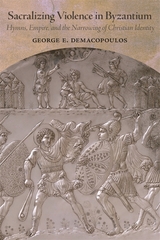 Sacralizing Violence in Byzantium: Hymns, Empire, and the Narrowing of Christian Identity
George E. Demacopoulos
Harvard University Press Christians had always been concerned, since the faith’s inception, about the relationship between violence and belief. In Byzantium, this tension was explored not only in abstract theological texts but in the songs people sang: hymns, a multivalent, fluid form of devotion that served as the meeting place between theological conviction and lived religious experience.
Sacralizing Violence in Byzantium is the first book to examine the complex and shifting perceptions of premodern Christians toward violence and war through the lens of hymnography. This book argues that the liturgical reflection on violence in Byzantium underwent a profound transformation—a sacralization of violence—at approximately the same time that Persian and then Arab armies conquered Jerusalem in the early seventh century, a turn that persisted into the tenth century.
By focusing on hymnography, George E. Demacopoulos provides both correction and nuance to historical assessments of Eastern Christian attitudes toward war and violence and reveals how Byzantine culture dramatized, authorized, and even celebrated violence.
 Sacramental Shopping: Louisa May Alcott, Edith Wharton, and the Spirit of Modern Consumerism
Sarah Way Sherman
University of New Hampshire Press, 2013 Written a generation apart and rarely treated together by scholars, Little Women (1868) and The House of Mirth (1905) share a deep concern with materialism, moral development, and self-construction. The heroines in both grapple with conspicuous consumption, an aspect of modernity that challenges older beliefs about ethical behavior and core identity.
Placing both novels at the historical intersection of modern consumer culture and older religious discourse on materialism and identity, Sarah Way Sherman analyzes how Alcott and Wharton rework traditional Protestant discourse to interpret their heroines’ struggle with modern consumerism. Her conclusion reveals how Little Women’s optimism, still buoyed by otherworldly justice, providential interventions, and the notion of essential identity, ultimately gives way to the much darker vision of modern materialistic culture in The House of Mirth.
Hardcover is un-jacketed.
 The Sacramental Theology of Marriage: One Flesh in One Spirit
Jose Granados
Catholic University of America Press, 2026 The Sacramental Theology of Marriage offers a comprehensive vision of the dogmatic theology of marriage. It takes into account biblical and patristic sources, the teaching of the Magisterium (with particular emphasis on the Councils of Trent and Vatican II), and the most important contemporary theological contributions. It begins with a vision of the sacrament of marriage as the sacrament that integrates the order of creation into the order of sacraments. This dual dimension of marriage justifies the division of the book into two parts: marriage as a sacrament of creation and marriage as a sacrament of redemption instituted by Christ. To describe the coordinates of marriage in creation, the book refers to St. Augustine (the goods of marriage), St. Thomas Aquinas (the ends of marriage), and modern personalism as reflected in the Second Vatican Council (the gifts of marriage). The book also draws on the theology of St. Bonaventure, who emphasized the institution of marriage by God in creation. The presentation of marriage as a sacrament of the new law is rooted in the way Christ lived the various meanings of the body. Marriage’s foundation in the body and in the experience of love sheds new light on the key milestones of its sacramentality: its matter and form, its signification, the grace it transmits, its liturgy and ministers, its indissolubility, its role in building up the Church, and the path of holiness it opens to the spouses. In all of this, marriage emerges as a pivotal sacrament for articulating Christianity’s relationship to the cosmos and to society. The Sacramental Theology of Marriage includes modern philosophical and theological explorations of the language of the body and the meaning of love (including the proposal of St. John Paul II). It also outlines the main principles for the pastoral care of marriage and family.
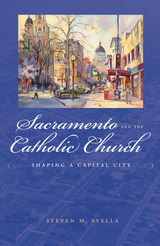 Sacramento and the Catholic Church: Shaping a Capital City
Steven Avella
University of Nevada Press, 2008 This work examines the interplay between the city of Sacramento and the Catholic Church since the 1850s. Avella uses Sacramento as a case study of the role of religious denominations in the development of the American West. In Sacramento, as in other western urban areas, churches brought civility and various cultural amenities, and they helped to create an atmosphere of stability so important to creating a viable urban community. At the same time, churches often had to shape themselves to the secularizing tendencies of western cities while trying to remain faithful to their core values and practices. Besides the numerous institutions that the Church sponsored, it brought together a wide spectrum of the city’s diverse ethnic populations and offered them several routes to assimilation. Catholic Sacramentans have always played an active role in government and in the city’s economy, and Catholic institutions provided a matrix for the creation of new communities as the city spread into neighboring suburbs. At the same time, the Church was forced to adapt itself to the needs and demands of its various ethnic constituents, particularly the flood of Spanish-speaking newcomers in the late twentieth century.
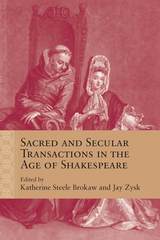 Sacred and Secular Transactions in the Age of Shakespeare
Edited by Katherine Steele Brokaw and Jay Zysk
Northwestern University Press, 2019 The term “secular” inspires thinking about disenchantment, periodization, modernity, and subjectivity. The essays in Sacred and Secular Transactions in the Age of Shakespeare argue that Shakespeare’s plays present “secularization” not only as a historical narrative of progress but also as a hermeneutic process that unleashes complex and often problematic transactions between sacred and secular. These transactions shape ideas about everything from pastoral government and performative language to wonder and the spatial imagination. Thinking about Shakespeare and secularization also involves thinking about how to interpret history and temporality in the contexts of Shakespeare’s medieval past, the religious reformations of the sixteenth century, and the critical dispositions that define Shakespeare studies today. These essays reject a necessary opposition between “sacred” and “secular” and instead analyze how such categories intersect. In fresh analyses of plays ranging from Hamlet and The Tempest to All’s Well that Ends Well and All Is True, secularization emerges as an interpretive act that explores the cultural protocols of representation within both Shakespeare’s plays and the critical domains in which they are studied and taught. The volume’s diverse disciplinary perspectives and theoretical approaches shift our focus from literal religion and doctrinal issues to such aspects of early modern culture as theatrical performance, geography, race, architecture, music, and the visual arts.
 The Sacred and the Sovereign: Religion and International Politics
John D. Carlson and Erik C. Owens, Editors
Georgetown University Press, 2003 Until September 11th, 2001, few in the West fully appreciated the significance of religion in international politics. The terrible events of that day refocused our attention on how thoroughly religion and politics intermingle, sometimes with horrific results. But must this intermingling always be so deadly? The Sacred and the Sovereign brings together leading voices to consider the roles that religion should—and should not—play in a post-Cold War age distinguished by humanitarian intervention, terrorism, globalization, and challenges to state sovereignty. But these challenges to state sovereignty have deep and abiding roots in religion that invite us to revisit just what values we hold sacred. Offsetting the commonly shared idea that religion is politics' perennial nemesis, this volume demonstrates that religious traditions, institutions, and ideas are essential elements of the political quest for human rights, peace, order, legitimacy, and justice. The Sacred and the Sovereign brings distinguished scholars of religious studies, theology, and politics together with ranking members of the military and government to reflect seriously about where—and if—safe boundaries can be drawn between religion and politics in the international arena.
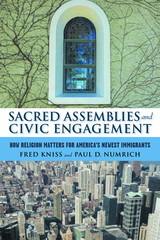 Sacred Assemblies and Civic Engagement: How Religion Matters for America's Newest Immigrants
Numrich, Paul D
Rutgers University Press, 2007 Immigration to the United States has been a major source of population growth and cultural change throughout much of America’s history. Currently, about 40 percent of the nation’s annual population growth comes from the influx of foreign-born individuals and their children. As these new voices enter America’s public conversations, they bring with them a new understanding of Buddhism, Hinduism, Islam, Judaism, and Christianity to a society that has been marked by religious variety.
Sacred Assemblies and Civic Engagement takes an in-depth look at one particular urban area—the Chicago metropolitan region—and examines how religion affects the civic engagement of the nation’s newest residents. Chapters focus on important religious factors, including sectarianism, moral authority, and moral projects; on several areas of social life, including economics, education, marriage, and language, where religion impacts civic engagement; and on how notions of citizenship and community are influenced by sacred assemblies.
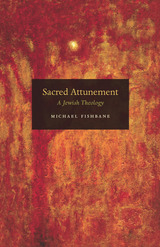 Sacred Attunement: A Jewish Theology
Michael Fishbane
University of Chicago Press, 2008 Contemporary theology, and Jewish theology in particular, Michael Fishbane asserts, now lies fallow, beset by strong critiques from within and without. For Jewish reality, a coherent and wide-ranging response in thoroughly modern terms is needed. Sacred Attunement is Fishbane’s attempt to renew Jewish theology for our time, in the larger context of modern and postmodern challenges to theology and theological thought in the broadest sense.
The first part of the book regrounds theology in this setting and opens up new pathways through nature, art, and the theological dimension as a whole. In the second section, Fishbane introduces his hermeneutical theology—one grounded in the interpretation of scripture as a distinctly Jewish practice. The third section focuses on modes of self-cultivation for awakening and sustaining a covenant theology. The final section takes up questions of scripture, authority, belief, despair, and obligation as theological topics in their own right.
The first full-scale Jewish theology in America since Abraham J. Heschel’s God in Search of Man and the first comprehensive Jewish philosophical theology since Franz Rosenzweig’s Star of Redemption, Sacred Attunement is a work of uncommon personal integrity and originality from one of the most distinguished scholars of Judaica in our time.
Sacred Boundaries: Religious Coexistence and Conflict in Early-Modern France
Keith P. Luria
Catholic University of America Press, 2005 Religious rivalry and persecution have bedeviled so many societies that confessional difference often seems an unavoidable source of conflict. Sacred Boundaries challenges this assumption by examining relations between the Catholic majority and Protestant minority in seventeenth-century France as a case study of two religious groups constructing confessional difference and coexistence
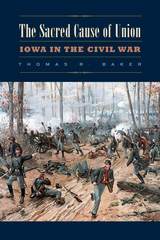 The Sacred Cause of Union: Iowa in the Civil War
Thomas R. Baker
University of Iowa Press, 2016 The Sacred Causeof Union highlights Iowans’ important role in reuniting the nation when the battle over slavery tore it asunder. In this first-ever survey of the state’s Civil War history, Thomas Baker interweaves economics, politics, army recruitment, battlefield performance, and government administration. Scattered across more than a dozen states and territories, Iowa’s fighting men marched long distances and won battles against larger rebel armies despite having little food or shelter and sometimes poor equipment. On their own initiative, the state’s women ventured south to the battlefields to tend to the sick and injured, and farm families produced mountains of food to feed hungry federal armies. In the absence of a coordinated military supply system, women’s volunteer organizations were instrumental in delivering food, clothing, medicines, and other supplies to those who needed them. All of these efforts contributed mightily to the Union victory and catapulted Iowa into the top circle of most influential states in the nation.
To shed light on how individual Iowans experienced the war, the book profiles six state residents. Three were well-known. Annie Wittenmyer, a divorced woman with roots in Virginia, led the state’s efforts to ship clothing and food to the soldiers. Alexander Clark, a Muscatine businessman and the son of former slaves, eloquently championed the rights of African Americans. Cyrus Carpenter, a Pennsylvania-born land surveyor anxious to make his fortune, served in the army and then headed the state’s Radical Republican faction after the war, ultimately being elected governor.
Three never became famous. Ben Stevens, a young, unemployed carpenter, fought in an Iowa regiment at Shiloh, and then transferred to a Louisiana African American regiment so that he could lead the former slaves into battle. Farm boy Abner Dunham defended the Sunken Road at the Battle of Shiloh, before spending seven grim months in Confederate prison camps. The young Charles Musser faced pressure from his neighbors to enlist and from his parents to remain at home to work on the farm. Soon after he signed on to serve the Union, he discovered that his older brother had joined the Confederate Army. Through the letters and lives of these six Iowans, Thomas Baker shows how the Civil War transformed the state at the same time that Iowans transformed the nation.
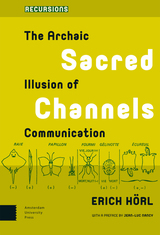 Sacred Channels: The Archaic Illusion of Communication
Erich Hörl
Amsterdam University Press, 2018 Erich Hörl's Sacred Channels is an original take on the history of communication theory and the cultural imaginary of communication understood through the notions of the sacred and the primitive. Hörl offers insight into the shared ground of anthropology and media theory in the nineteenth and twentieth centuries and presents an archeology of the philosophy of technology that underpins contemporary culture. This singular and unique project focuses on the ethnological disciplines and their phantasmatic imaginations of a prealphabetical realm of the sacred and the primitive but reads them in the context of media cultural questions as epistemic unconscious and as projections of the emerging postalphabetical condition. Drawing inspiration from work by the likes of Friedrich Kittler, Hörl's understanding of cybernetics in the post-World War II interdisciplinary field informs a rich analysis that is of interest to media scholars and to anyone seeking to understand the historical and theoretical underpinnings of the humanities in the age of technical media.
The Sacred Complex: On the Psychogenesis of Paradise Lost
William Kerrigan
Harvard University Press, 1983 This reading of Milton juxtaposes the poet's theology and Freud's account of the Oedipus complex in ways that yield both new understanding of Milton and a model for psychoanalytic interpretation of literature.
The book ranges widely through the art and life of Milton, including extensive discussions of his theological irregularities and the significance, medical and symbolic, he assigned to his blindness. Kerrigan analyzes the oedipal aspect of Milton's religion; examines the nature of the Miltonic godhead; studies Milton's analogies linking human, angelic, and cosmic bodies; and explores Milton's symbolism of home. In a commanding demonstration, Kerrigan delineates how the great epic and the psyche of its author bestow meaning on each other.
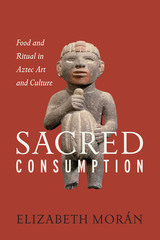 Sacred Consumption: Food and Ritual in Aztec Art and Culture
By Elizabeth Morán
University of Texas Press, 2016 Making a foundational contribution to Mesoamerican studies, this book explores Aztec painted manuscripts and sculptures, as well as indigenous and colonial Spanish texts, to offer the first integrated study of food and ritual in Aztec art. Aztec painted manuscripts and sculptural works, as well as indigenous and Spanish sixteenth-century texts, were filled with images of foodstuffs and food processing and consumption. Both gods and humans were depicted feasting, and food and eating clearly played a pervasive, integral role in Aztec rituals. Basic foods were transformed into sacred elements within particular rituals, while food in turn gave meaning to the ritual performance. This pioneering book offers the first integrated study of food and ritual in Aztec art. Elizabeth Morán asserts that while feasting and consumption are often seen as a secondary aspect of ritual performance, a close examination of images of food rites in Aztec ceremonies demonstrates that the presence—or, in some cases, the absence—of food in the rituals gave them significance. She traces the ritual use of food from the beginning of Aztec mythic history through contact with Europeans, demonstrating how food and ritual activity, the everyday and the sacred, blended in ceremonies that ranged from observances of births, marriages, and deaths to sacrificial offerings of human hearts and blood to feed the gods and maintain the cosmic order. Morán also briefly considers continuities in the use of pre-Hispanic foods in the daily life and ritual practices of contemporary Mexico. Bringing together two domains that have previously been studied in isolation, Sacred Consumption promises to be a foundational work in Mesoamerican studies.
The Sacred Cosmos: Theological, Philosophical, and Scientific Conversations in the Twelfth Century School of Chartres
Peter Ellard
University of Scranton Press, 2007 The School of Chartres was a bold intellectual movement of the twelfth century that introduced the World Soul and the Chartrian cosmology to Christendom. In his controversial book, The Sacred Cosmos, theologian Peter Ellard analyzes the most radical aspects of Chartrian thought and traces their relation to classical and late-antique philosophers such as Boethius and Plato. In addition, Ellard investigates the Cathedral of Chartres as an important proof and example of Chartrian theology in this essential volume for anyone interested in the intersection of spirituality and philosophy.
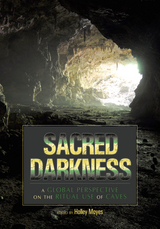 Sacred Darkness: A Global Perspective on the Ritual Use of Caves
Holley Moyes
University Press of Colorado, 2014 Caves have been used in various ways across human society, but despite the persistence within popular culture of the iconic caveman, deep caves were never used primarily as habitation sites for early humans. Rather, in both ancient and contemporary contexts, caves have served primarily as ritual spaces. In Sacred Darkness, contributors use archaeological evidence as well as ethnographic studies of modern ritual practices to envision the cave as place of spiritual and ideological power that emerges as a potent venue for ritual practice. Covering the ritual use of caves in Europe, Asia, Australia, Africa, Mesoamerica, and the US Southwest and Eastern woodlands, this book brings together case studies by prominent scholars whose research spans from the Paleolithic period to the present day. These contributions demonstrate that cave sites are as fruitful as surface contexts in promoting the understanding of both ancient and modern religious beliefs and practices. This state-of-the-art survey of ritual cave use will be one of the most valuable resources for understanding the role of caves in studies of religion, sacred landscape, or cosmology and a must-read for any archaeologist interested in caves.
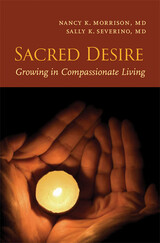 Sacred Desire: Growing in Compassionate Living
Nancy K. Morrison
Templeton Press, 2009 Is the call to spirituality embedded in human biology? Authors Nancy K. Morrison and Sally K. Severino draw on cutting-edge research, including the recent discovery of brain "mirror neurons" and the elucidation of the physiology of social affiliation and attachment, to make a bold case that we are, in fact, biologically wired to seek oneness with the divine. They have termed this innate urge "sacred Desire." In their new book on the subject, ,em>Sacred Desire: Growing in Compassionate Living, Morrison and Severino, both highly esteemed academic psychiatrists, draw on neurophysiology, relationship studies, research on spiritual development, and psychotherapy to show how spirituality is intimately connected with our physical being. The authors offer several clinical examples of how recognizing sacred Desire can advance a person's healing and they provide an action plan for using Desire to move from fear to love of self, others, and all creation. In addition to psychiatrists and neurophysiologists, who will undoubtedly welcome this significant contribution to their fields of study, Sacred Desire is sure to appeal as well to the much wider audience of spiritual seekers looking for intellectually and scientifically credible ways to understand spirituality in today's world.
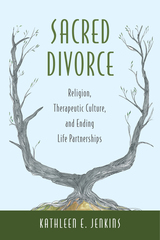 Sacred Divorce: Religion, Therapeutic Culture, and Ending Life Partnerships
Jenkins, Kathleen E
Rutgers University Press, 2014 Even in our world of redefined life partnerships and living arrangements, most marriages begin through sacred ritual connected to a religious tradition. But if marriage rituals affirm deeply held religious and secular values in the presence of clergy, family, and community, where does divorce, which severs so many of these sacred bonds, fit in? Sociologist Kathleen Jenkins takes up this question in a work that offers both a broad, analytical perspective and a uniquely intimate view of the role of religion in ending marriages.
For more than five years, Jenkins observed religious support groups and workshops for the divorced and interviewed religious practitioners in the midst of divorces, along with clergy members who advised them. Her findings appear here in the form of eloquent and revealing stories about individuals managing emotions in ways that make divorce a meaningful, even sacred process. Clergy from mainline Protestant denominations to Baptist churches, Jewish congregations, Unitarian fellowships, and Catholic parishes talk about the concealed nature of divorce in their congregations. Sacred Divorce describes their cautious attempts to overcome such barriers, and to assemble meaningful symbols and practices for members by becoming compassionate listeners, delivering careful sermons, refitting existing practices like Catholic annulments and Jewish divorce documents (gets), and constructing new rituals.
With attention to religious, ethnic, and class variations, covering age groups from early thirties to mid-sixties and separations of only a few months to up to twenty years, Sacred Divorce offers remarkable insight into individual and cultural responses to divorce and the social emotions and spiritual strategies that the clergy and the faithful employ to find meaning in the breach. At once a sociological document, an ethnographic analysis, and testament of personal experience, Sacred Divorce provides guidance, strategies and answers to readers looking for answers and those looking to heal.
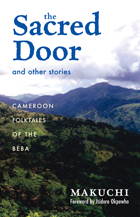 The Sacred Door and Other Stories: Cameroon Folktales of the Beba
Makuchi
Ohio University Press, 2007 The Sacred Door and Other Stories: Cameroon Folktales of the Beba offers readers a selection of folktales infused with riddles, proverbs, songs, myths, and legends, using various narrative techniques that capture the vibrancy of Beba oral traditions. Makuchi retells the stories that she heard at home when she was growing up in her native Cameroon. The collection of thirty-four folktales of the Beba showcases a wide variety of stories that capture the richness and complexities of an agrarian society’s oral literature and traditions. Revenge, greed, and deception are among the themes that frame the story lines in both new and familiar ways. In the title story, a poor man finds himself elevated to king. The condition for his continued success is that he not open the sacred door. This tale of temptation, similar to the story of Pandora’s box, concludes with the question, “What would you have done?” Makuchi relates the stories her mother told her so that readers can make connections between African and North American oral narrative traditions. These tales reinforce the commonalities of our human experiences without discounting our differences.
 Sacred Dread: Raïssa Maritain, the Allure of Suffering, and the French Catholic Revival (1905-1944)
Brenna Moore
University of Notre Dame Press, 2013
In early twentieth-century France, a vast network of artists, writers, and religious seekers were drawn to Roman Catholicism’s elaborate panoply of symbols centered on suffering. A preoccupation with affliction dominated the movement now known as the French Catholic revival, or the renouveau catholique—considered a watershed in the history of the modern Catholic Church and the “golden age” of French Catholicism. In Sacred Dread, Brenna Moore examines the life and writings of Raïssa Maritain (1883-1960), one of the few women to contribute to this intellectual movement. Moore explores the reasons why Maritain, a nonpracticing Jew, was attracted to this suffering-centered theological imagination and how she and other advocates transformed it in the wake of the Holocaust. Sacred Dread offers readers a new understanding of a radical Catholic piety that was embraced by a wide range of pre-war intellectuals.
By combining late-modern French intellectual and cultural history, Catholic theology, biography, and an analysis of Maritain’s published and unpublished writings, Moore also identifies two major factors in this Catholic revival—gender and Judaism—that have not received adequate attention. Discourses of femininity and Judaism were central to the French Catholic articulation and idealization of suffering. Moore argues that Maritain, as a Jewish convert and one of the few women in this intellectual community, embodied symbolic associations of suffering, holiness, women, and Jews; indeed, for her husband, godfather, confessors, friends, and godchildren, Raïssa Maritain was herself the articulation of this abject ideal. Caught as she was in a web of meaning, Raïssa Maritain was an intellectual whose legacy deepens but also subverts the centrality of femininity and Judaism in French Catholic elaborations of suffering.
"Brenna Moore brings together in this beautifully written book deep theological learning with a fine historical sensibility to give us a stunning portrait of one of the most interesting women of the 20th century. Sacred Dread is at the same time an inner history of twentieth-century Catholicism. Brilliantly illuminating Maritain's intellectual milieu, Moore shows how courageously Maritain faced the horrors of her times and at what cost, offering a theology of suffering for a deeply wounded age. In Brenna Moore this great thinker has found her perfect reader at last." —Robert Orsi, Northwestern University
"Sacred Dread is a fine study of the other Maritain, Raissa, and her rich involvements in the intellectual and spiritual life of twentieth-century France. Moore makes excellent use of primary and secondary sources and performs sensitive readings of Raissa’s own essays, poetry, and philosophic writings, to give us a convincing re-reading of the doctrine of vicarious suffering that fascinated a circle of Jewish, Christian, and secular colleagues during the surprising Catholic revival in France and across four decades of tremendous cultural crisis and ferment in western Europe." —Paula Kane, University of Pittsburgh
"Brenna Moore's Sacred Dread: Raïssa Maritain, the Allure of Suffering, and the French Catholic Revival (1905-1944) is a genuine contribution to scholarship on a major figure in the Catholic Revival. Moore's treatment of Maritain in the context in which she lived and wrote is nuanced, thoughtful, and carefully researched. Additionally, she adds significantly to conversations about gender and religion by revisiting the function of female suffering in French Catholicism between 1870 and 1970." —Marian Ronan, Research Professor of Catholic Studies, The Center for World Christianity, New York Theological Seminary
The Sacred Earth: Jewish Perspectives on Our Planet
Rabbi Andrue J. Kahn
Central Conference of American Rabbis, 2023 The Torah begins by setting forth the heavens and the Earth as God’s creation, impelling humanity to steward our planet for its own sake and for its ability to nurture our lives. Yet the human-Divine-environment relationship seems to be in perpetual crisis. The Sacred Earth is a contemporary Jewish response to the looming threat of climate change, the widespread desire for experiential spirituality rooted in nature, and the continually changing relationship between humanity, nature, technology, and the Divine. The leading thinkers in this collection reflect on human vulnerability in the face of forces of nature, examine conceptions of our place in cosmology, and grapple with environmental destruction. Ultimately, with hope, they creatively explore ways to redeem this sacred Earth.
The Sacred Edifices of the Batak of Sumatra
Harley Harris Bartlett
University of Michigan Press, 1934 The fourth book in the Museum’s Occasional Contributions series is Harley Harris Bartlett’s work on sacred structures in the Batak region of Sumatra. Contains 31 black and white photographs of structures, sculptures, altars, and other holy places from the early 1900s.
 The Sacred Era: A Novel
Aramaki Yoshio
University of Minnesota Press, 2017 The magnum opus of a Japanese master of speculative fiction, and a book that established Yoshio Aramaki as a leading representative of the genre, The Sacred Era is part post-apocalyptic world, part faux-religious tract, and part dream narrative. In a distant future ruled by a new Papal Court serving the Holy Empire of Igitur, a young student known only as K arrives at the capital to take The Sacred Examination, a text that will qualify him for metaphysical research service with the court. His performance earns him an assignment in the secret Planet Bosch Research Department; this in turn puts him on the trail of a heretic executed many years earlier, whose headless ghost is still said to haunt the Papal Court, which carries him on an interplanetary pilgrimage across the Space Taklamakan Desert to the Planet Loulan, where time stands still, and finally to the mysterious, supposedly mythical Planet Bosch, a giant, floating plant-world that once orbited Earth but has somehow wandered 1,000 light years away. K’s journey to this strange world, seemingly sprung from Hieronymus Bosch’s Garden of Earthly Delights, is a journey into inner and outer space, as the novel traffics in mystic and metaphysical questions only to transform them into technical and astrophysical problems, translating the substance of religious and mythic texts into the language of science fiction.
Sacred Gardens and Landscapes: Ritual and Agency
Michel Conan
Harvard University Press, 2007 Studies of rituals in sacred gardens and landscapes offer tantalizing insights into the significance of gardens and landscapes in the societies of India, ancient Greece, Pre-Columbian Mexico, medieval Japan, post-Renaissance Europe, and America. Sacred gardens and landscapes engaged their visitors into three specific modes of agency: as anterooms spurring encounters with the netherworld; as journeys through mystical lands; and as a means of establishing a sense of locality, metaphorically rooting the dweller’s own identity in a well-defined part of the material world. Each section of this book is devoted to one of these forms of agency. Together the essays reveal a profound cultural significance of gardens previously overlooked by studies of garden styles.
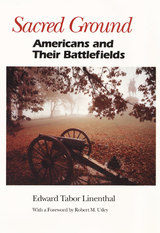 Sacred Ground: AMERICANS AND THEIR BATTLEFIELDS
Edward Tabor Linenthal
University of Illinois Press, 1991 Americans have persistently expressed fascination with the nation's most
famous battlefields through patriotic rhetoric, monument building, physical
preservation, and battle reenactment. But each site is also a place where
different groups of Americans come to compete for ownership of cherished
national stories and to argue about the meaning of war, the importance
of martial sacrifice, and the significance of preserving the nation's
patriotic landscape.
From the anniversary speeches at Lexington and Concord that shaped the
image of the minuteman to Alamo Day speeches invoking the Texas "freedom
fighters" of 1836 in support of the contras in Nicaragua; from passionate
arguments over the placement of Confederate monuments at Gettysburg to
confrontations between militant American Indian Movement and "Custer
loyalists" during the Little Bighorn centennial in 1976; from the
treatment of the USS Arizona at Pearl Harbor to continuing attempts
to maintain the purity of these places in the face of commercialization---Sacred
Ground details the ongoing struggles to define, control, and subvert
patriotic faith as expressed at these ceremonial sites.
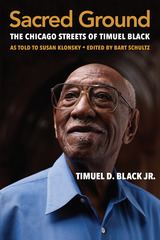 Sacred Ground: The Chicago Streets of Timuel Black
Timuel D. Black Jr., as told to Susan Klonsky, edited by Bart Schultz
Northwestern University Press, 2019 Timuel Black is an acclaimed historian, activist, and storyteller. Sacred Ground: The Chicago Streets of Timuel Black chronicles the life and times of this Chicago legend.
Sacred Ground opens in 1919, during the summer of the Chicago race riot, when infant Black and his family arrive in Chicago from Birmingham, Alabama, as part of the first Great Migration. He recounts in vivid detail his childhood and education in the Black Metropolis of Bronzeville and South Side neighborhoods that make up his "sacred ground."
Revealing a priceless trove of experiences, memories, ideas, and opinions, Black describes how it felt to belong to this place, even when stationed in Europe during World War II. He relates how African American soldiers experienced challenges and conflicts during the war, illuminating how these struggles foreshadowed the civil rights movement. A labor organizer, educator, and activist, Black captures fascinating anecdotes and vignettes of meeting with famous figures of the times, such as Duke Ellington and Martin Luther King Jr., but also with unheralded people whose lives convey lessons about striving, uplift, and personal integrity.
Rounding out this memoir, Black reflects on the legacy of his friend and mentee, Barack Obama, as well as on his public works and enduring relationships with students, community workers, and some very influential figures in Chicago and the world.
The Sacred Heart of Jesus: The Visual Evolution of a Devotion
David Morgan
Amsterdam University Press, 2008
From its origins in the mid-seventeenth century visions of the French nun Margaret Mary Alacoque (1647–90) to its continuing employment in worship today, the Devotion to the Sacred Heart of Jesus has been controversial. Vigorously promoted by Jesuit spiritual directors, embroiled in the controversies of Jansenist writers, closely associated with Royalist political causes in France, and taken around the world by Sister Sophie Barat in the nineteenth century, the Devotion’s practices took on the shape of its evolving visual culture and iconography. This volume traces the unfolding visual biography of the sacred heart and shows how imagery documents the Devotion’s remarkable evolution.
The Sacred Image East and West
Edited by Robert Ousterhout and Leslie Brubaker
University of Illinois Press, 1995 A new generation of American medieval art historians explores how sacred images were perceived during the Middle Ages in Byzantium and Europe. The essays cover a full range of images, including panel paintings, altarpieces, manuscripts, and wall paintings, and a rich variety of socioreligious settings, private, monastic, and imperial. Also examined are the differences between images produced for a single viewer and those produced for communities; images produced for private contemplation or devotion and those functioned within a liturgical setting; and the varying ways in which sacred images affected women and men, religious and secular communities, rulers and ruled.
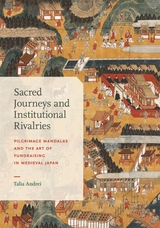 Sacred Journeys and Institutional Rivalries: Pilgrimage Mandalas and the Art of Fundraising in Medieval Japan
Talia Andrei
Harvard University Press Sacred Journeys and Institutional Rivalries is a detailed and richly illustrated exploration of pilgrimage mandalas (sankei mandara). These large-scale, brightly colored landscape paintings, which appeared in late-medieval Japan, present aerial views of sacred sites, the roads leading to them, and the rites performed there. Carried by itinerant monks and nuns throughout the country, pilgrimage mandalas were used in lively narrative performances called etoki. These paintings displayed a new kind of artistic language by mixing depictions of otherworldly miracles with everyday pleasures accessible to all would-be visitors.
After exploring the origins of this art, Talia Andrei engages in a series of detective-like analyses, unraveling the subtle hints of institutional networks and power struggles concealed within the figural and architectural motifs of the paintings. This approach shows how visual sources, when read with and against textual records, can fundamentally change, shift, or enhance what we know about a given time and place in history. Studied in this way, a pilgrimage mandala not only reveals hidden clues to historical uncertainties left murky in the textual archive but also serves as a visual testament to the cultural and institutional forces that shaped its creation.
A Sacred Kingdom: Bishops and the Rise of Frankish Kingship, 300-850
Michael Edward Moore
Catholic University of America Press, 2011 Drawing on the records of nearly 100 bishops' councils spanning the centuries, alongside royal law, edicts, and capitularies of the same period, this study details how royal law and the very character of kingship among the Franks were profoundly affected by episcopal traditions of law and social order.
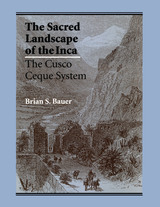 The Sacred Landscape of the Inca: The Cusco Ceque System
By Brian S. Bauer
University of Texas Press, 1998 The ceque system of Cusco, the ancient capital of the Inca empire, was perhaps the most complex indigenous ritual system in the pre-Columbian Americas. From a center known as the Coricancha (Golden Enclosure) or the Temple of the Sun, a system of 328 huacas (shrines) arranged along 42 ceques (lines) radiated out toward the mountains surrounding the city. This elaborate network, maintained by ayllus (kin groups) that made offerings to the shrines in their area, organized the city both temporally and spiritually. From 1990 to 1995, Brian Bauer directed a major project to document the ceque system of Cusco. In this book, he synthesizes extensive archaeological survey work with archival research into the Inca social groups of the Cusco region, their land holdings, and the positions of the shrines to offer a comprehensive, empirical description of the ceque system. Moving well beyond previous interpretations, Bauer constructs a convincing model of the system's physical form and its relation to the social, political, and territorial organization of Cusco.
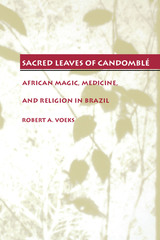 Sacred Leaves of Candomblé: African Magic, Medicine, and Religion in Brazil
By Robert A. Voeks
University of Texas Press, 1997 Winner, Hubert Herring Book Award, Pacific Coast Council on Latin American Studies Candomblé, an African religious and healing tradition that spread to Brazil during the slave trade, relies heavily on the use of plants in its spiritual and medicinal practices. When its African adherents were forcibly transplanted to the New World, they faced the challenge not only of maintaining their culture and beliefs in the face of European domination but also of finding plants with similar properties to the ones they had used in Africa. This book traces the origin, diffusion, medicinal use, and meaning of Candomblé's healing pharmacopoeia—the sacred leaves. Robert Voeks examines such topics as the biogeography of Africa and Brazil, the transference—and transformation—of Candomblé as its adherents encountered both native South American belief systems and European Christianity, and the African system of medicinal plant classification that allowed Candomblé to survive and even thrive in the New World. This research casts new light on topics ranging from the creation of African American cultures to tropical rain forest healing floras.
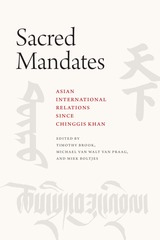 Sacred Mandates: Asian International Relations since Chinggis Khan
Edited by Timothy Brook, Michael van Walt van Praag, Miek Boltjes
University of Chicago Press, 2018 Contemporary discussions of international relations in Asia tend to be tethered in the present, unmoored from the historical contexts that give them meaning. Sacred Mandates, edited by Timothy Brook, Michael van Walt van Praag, and Miek Boltjes, redresses this oversight by examining the complex history of inter-polity relations in Inner and East Asia from the thirteenth century to the twentieth, in order to help us understand and develop policies to address challenges in the region today.
This book argues that understanding the diversity of past legal orders helps explain the forms of contemporary conflict, as well as the conflicting historical narratives that animate tensions. Rather than proceed sequentially by way of dynasties, the editors identify three “worlds”—Chingssid Mongol, Tibetan Buddhist, and Confucian Sinic—that represent different forms of civilization authority and legal order. This novel framework enables us to escape the modern tendency to view the international system solely as the interaction of independent states, and instead detect the effects of the complicated history at play between and within regions. Contributors from a wide range of disciplines cover a host of topics: the development of international law, sovereignty, state formation, ruler legitimacy, and imperial expansion, as well as the role of spiritual authority on state behavior, the impact of modernization, and the challenges for peace processes. The culmination of five years of collaborative research, Sacred Mandates will be the definitive historical guide to international and intrastate relations in Asia, of interest to policymakers and scholars alike, for years to come.
 Sacred Matter: Animacy and Authority in the Americas
Steve Kosiba
Harvard University Press Sacred Matter: Animacy and Authority in the Americas examines animism in Pre-Columbian America, focusing on the central roles objects and places played in practices that expressed and sanctified political authority in the Andes, Amazon, and Mesoamerica.
Pre-Columbian peoples staked claims to their authority when they animated matter by giving life to grandiose buildings, speaking with deified boulders, and killing valued objects. Likewise things and places often animated people by demanding labor, care, and nourishment. In these practices of animation, things were cast as active subjects, agents of political change, and representatives of communities. People were positioned according to specific social roles and stations: workers, worshippers, revolutionaries, tribute payers, or authorities. Such practices manifested political visions of social order by defining relationships between people, things, and the environment.
Contributors to this volume present a range of perspectives (archaeological, art historical, ethnohistorical, and linguistic) to shed light on how Pre-Columbian social authority was claimed and sanctified in practices of transformation and transubstantiation—that is, practices that birthed, converted, or destroyed certain objects and places, as well as the social and natural order from which these things were said to emerge.
The Sacred Meadows: A Structural Analysis of Religious Symbolism in an East African Town
Abdul Hamid M. el Zein
Northwestern University Press, 1974 The Sacred Meadows is an anthropological study of the religion of Lamu, the oldest inhabited town in Kenya, originally settled in 1370, and situated on an island off the Kenyan coast. Abdul Hamid El-Zein discusses the religious impact of Islam and its place in Lamu society. He explores the structure of the town’s religious system and its relation to social stratification and everyday life. Through his analysis of the religious symbolism used by the people of Lamu, he shows that myth, ritual and magic are integral parts of a whole symbolic system.
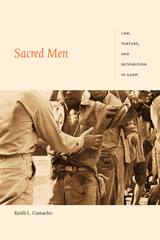 Sacred Men: Law, Torture, and Retribution in Guam
Keith L. Camacho
Duke University Press, 2019 Between 1944 and 1949 the United States Navy held a war crimes tribunal that tried Japanese nationals and members of Guam's indigenous Chamorro population who had worked for Japan's military government. In Sacred Men Keith L. Camacho traces the tribunal's legacy and its role in shaping contemporary domestic and international laws regarding combatants, jurisdiction, and property. Drawing on Giorgio Agamben's notions of bare life and Chamorro concepts of retribution, Camacho demonstrates how the U.S. tribunal used and justified the imprisonment, torture, murder, and exiling of accused Japanese and Chamorro war criminals in order to institute a new American political order. This U.S. disciplinary logic in Guam, Camacho argues, continues to directly inform the ideology used to justify the Guantánamo Bay detention center, the torture and enhanced interrogation of enemy combatants, and the American carceral state.
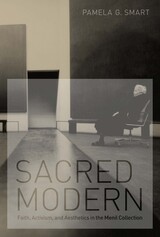 Sacred Modern: Faith, Activism, and Aesthetics in the Menil Collection
By Pamela G. Smart
University of Texas Press, 2010 Renowned as one of the most significant museums built by private collectors, the Menil Collection in Houston, Texas, seeks to engage viewers in an acutely aesthetic, rather than pedagogical, experience of works of art. The Menil's emphasis on being moved by art, rather than being taught art history, comes from its founders' conviction that art offers a way to reintegrate the sacred and the secular worlds. Inspired by the French Catholic revivalism of the interwar years that recast Catholic tradition as the avant-garde, Dominique and John de Menil shared with other Catholic intellectuals a desire to reorder a world in crisis by imbuing modern cultural forms with religious faith, binding the sacred with the modern. Sacred Modern explores how the Menil Collection gives expression to the religious and political convictions of its founders and how "the Menil way" is being both perpetuated and contested as the Museum makes the transition from operating under the personal direction of Dominique de Menil to the stewardship of career professionals. Taking an ethnographic approach, Pamela G. Smart analyzes the character of the Menil aesthetic, the processes by which it is produced, and the sensibilities that it is meant to generate in those who engage with the collection. She also offers insight into the extraordinary impact Dominique and John de Menil had on the emergence of Houston as a major cultural center.
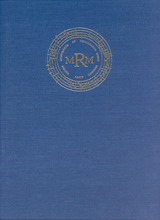 Sacred Music from the Cathedral at Trent: Trent, Museo Provinciale d'Arte, Codex 1375 (olim 88)
Edited by Rebecca L. Gerber
University of Chicago Press, 2007 Often called the musical equivalent of the Dead Sea Scrolls, the Trent codices have dramatically broadened our understanding of Renaissance music. Much has been written about this collection of fifteenth-century music manuscripts, most of which were discovered in the Cathedral at Trent, but none of the seven codices--generally called Trent 87 through Trent 93--has ever been published in its entirety. Thus Rebecca Gerber’s edition of Trent 88, which took more than a decade to prepare, will be the first to appear. As such, this volume is a landmark in the publication of early music.
Trent 88 comprises an extensive anthology of 145 compositions tailored to the ceremonial and daily religious services of the period. The international scope of the collection is both impressive and significant: early English, French, German, and Spanish mass cycles appear alongside simple hymns and Magnificats. Music by renowned composers—including Guillaume Du Fay, Johannes Ockeghem, Johannes Cornago, and John Bedingham—is joined here by an even larger repertory of anonymous compositions with great aesthetic and historical value. Edited to accommodate both scholars and performers, and augmented with Gerber’s expert introduction, this volume will significantly deepen existing knowledge of a crucial period in the history of music.
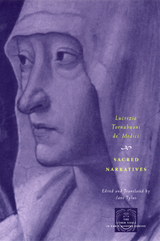 Sacred Narratives
Lucrezia Tornabuoni de' Medici
University of Chicago Press, 2001 The most prominent woman in Renaissance Florence, Lucrezia Tornabuoni de' Medici (1425-1482) lived during her city's golden age. Wife of Piero de' Medici and mother of Lorenzo the Magnificent, Tornabuoni exerted considerable influence on Florence's political and social affairs. She was also, as this volume illustrates, a gifted and prolific poet.
This is the first major collection in any language of her extensive body of religious poems. Ranging from gentle lyrics on the Nativity to moving dialogues between a crucified Christ and the weeping sinner who kneels before him, the nine laudi (poems of praise) included here are among the few such poems known to have been written by a woman. Tornabuoni's five storie sacre, narrative poems based on the lives of biblical figures-three of whom, Judith, Susanna, and Esther, are Old Testament heroines-are virtually unique in their range and expressiveness. Together with Jane Tylus's substantial introduction, these poems offer us both a fascinating portrait of a highly educated and creative woman and a lively sense of cultural and social life in Renaissance Florence.
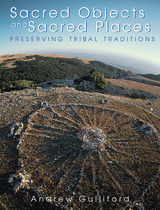 Sacred Objects and Sacred Places: Preserving Tribal Traditions
Andrew Gulliford
University Press of Colorado, 2000 Sacred Objects, Sacred Places combines native oral histories, photographs, drawings, and case studies to present current issues of cultural preservation vital to American Indians, Alaska Natives, and Native Hawaiians. Complete with commentaries by native peoples, non-native curators, and archaeologists, this book discusses the repatriation of human remains, the curation and exhibition of sacred masks and medicine bundles, and key cultural compromises for preservation successes in protecting sacred places on private, state, and federal lands. The author traveled thousands of miles over a ten-year period to meet and interview tribal elders, visit sacred places, and discuss the power of sacred objects in order to present the essential debates surrounding tribal historic preservation. Without revealing the exact locations of sacred places (unless tribes have gone public with their cultural concerns), Gulliford discusses the cultural significance of tribal sacred sites and the ways in which they are being preserved. Some of the case studies included are the Wyoming Medicine Wheel, Devil's Tower National Monument, Mount Shasta in California, Mount Graham in Arizona, and the Sweet Grass Hills in Montana. Federal laws are reviewed in the context of tribal preservation programs, and tribal elders discuss specific cases of repatriation. Though the book describes numerous tribal tragedies and offers examples of cultural theft, Sacred Objects and Sacred Places affirms living traditions. It reveals how the resolution of these controversies in favor of native people will ensure their cultural continuity in a changing and increasingly complex world. The issues of returning human remains, curating sacred objects, and preserving tribal traditions are addressed to provide the reader with a full picture of Native Americans' struggles to keep their heritage alive.
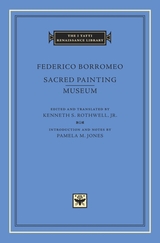 Sacred Painting. Museum
Edited and translated by Kenneth S. Rothwell, Jr.Introduction and Notes by Pamela N. Jones
Harvard University Press, 2010 Federico Borromeo, Cardinal-Archbishop of Milan (1564–1631), is well known as a leading Catholic reformer and as the founder of the Ambrosiana library, art collection, and academy in that city. Less known is the fact that the institution's art museum was the culmination of many decades of reflection on the aesthetic qualities and religious roles of art. Borromeo recorded his reflections in two treatises.
De pictura sacra (Sacred Painting, 1624) laid out the rules that artists should follow when creating religious art. Borromeo touched on dozens of iconographical issues and in so doing drew on his deep knowledge not only of church fathers, councils, and scripture but also of classical art and literature. In Musaeum (1625) Borromeo showed a less doctrinaire and more personal side by walking the reader through the Ambrosiana and commenting on specific works in his collection. He offered some of the earliest and most important critiques to survive on works by artists such as Leonardo, Titian, and Jan Brueghel the Elder.
This volume offers, for the first time, translations of the treatises directly into English as well as freshly edited Latin texts, an introduction, extensive notes, and an appendix on the Academy of Design that was established in conjunction with the museum. These treatises will be of great interest to students of the history of art, museums, and religion.
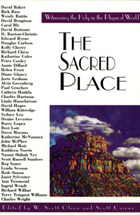 Sacred Place
W Scott Olsen
University of Utah Press, 1996
Some of today's most significant writers and poets explore the relation between what we call the sacred and what we witness in the apparent world.
This unprecedented anthology brings together a provocative mix of new and well known writers whose poetry and prose broaches the possibility of something "bigger" going on, something more significant at stake. Is some powerful agency at work in what we see or are we just wishing (or fearing) that there were? Who can say? Who would dare? What’s most intriguing about the selections in this volume is that the authors do dare. What’s most attractive about them is that they resist answering that dare with reductions. They prefer the swoon of multiple possibilities over the relative comfort of conclusions. Various as they are, the works collected in The Sacred Place share a common reverence for the word itself, and perhaps best of all—they share a common understanding that no one of them comprehends fully what that means. They seem to desire instead a sense that the humble stuff surrounding us affords a likely enough habitation for the sacred, even now.
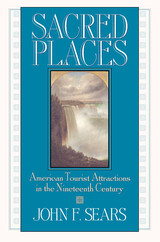 Sacred Places: American Tourist Attractions in the Nineteenth Century
John F. Sears
University of Massachusetts Press, 1999 Tourism emerged as an important cultural activity in the United States in the 1820s as steamboats and canals allowed for greater mobility and the nation's writers and artists focused their attention on American scenery. From the 1820s until well after the Civil War, American artists, like Thomas Cole and Frederic Church, depicted American tourist attractions in their work, and often made their reputations on those paintings. Writers like Irving, Cooper, Hawthorne, and James described their visits to the same attractions or incorporated them into their fiction. The work of these artists and writers conferred value on the scenes represented and helped shape the vision of the tourists who visited them. This interest in scenery permeated the work of both serious and popular writers and artists, and they produced thousands of images and descriptions of America's tourist attractions for the numerous guidebooks, magazines, and other publications devoted to travel in the United States during the period.
Drawing on this fascinating body of material, Sacred Places examines the vital role which tourism played in fulfilling the cultural needs of nineteenth-century Americans. America was a new country in search of a national identity. Educated Americans desperately wished to meet European standards of culture and, at the same time, to develop a distinctly American literature and art. Tourism offered a means of defining America as a place and taking pride in the special features of its landscape. The country's magnificent natural wonders were a substitute for the cathedrals and monuments, the sense of history that Europe had built over the centuries. Moreover, Sears argues, tourist attractions like Mammoth Cave, Mount Auburn Cemetery, Yosemite, and Yellowstone functioned as sacred places for a nation with a diversity of religious sects and without ancient religious and national shrines. For nineteenth-century Americans, whose vision was shaped by the aesthetics of the sublime and the picturesque and by the popular nineteenth-century Romantic view of nature as temple, such places fulfilled their urgent need for cultural monuments and for places to visit which transcended ordinary reality.
But these nineteenth-century tourist attractions were also arenas of consumption. Niagara Falls was the most sublime of God's creations, a sacred place, which, like Mount Auburn Cemetery, was supposed to have a profound moral effect on the spectator. But it was also an emporium of culture where the tourist shopped for Niagara's wonders and for little replicas of the Falls in the form of souvenirs. In Sacred Places, Sears describes how this strange, sometimes amusing, juxtaposition of the mythic and the trivial, the sacred and the profane, the spiritual and the commercial remained a significant feature of American tourist attractions even after efforts were made at Yosemite, Yellowstone, and Niagara Falls to curb commercial and industrial intrusions.
Sears also explores how the nineteenth-century idealization of home stimulated the tourists' response to such places as the Willey House in the White Mountains, the rural cemeteries, and even the newly established asylums for the deaf, dumb, blind, and insane. And, in an intriguing account of Mauch Chunk, Pennsylvania, he examines the reasons why an important nineteenth-century anthracite transportation center was also a major tourist attraction.
Most of the attractions discussed in this book are still visited by millions of Americans. By illuminating their cultural meaning, Sacred Places prompts us to reflect on our own motivations and responses as tourists and reveals why tourism was and still is such an important part of American life.
Sacred Players: The Politics of Response in the Middle English Religious Drama
Heather Hill-Vásquez
Catholic University of America Press, 2007 Offering a unique historical perspective to the study of medieval English drama, Heather Hill-Vásquez in Sacred Players argues that different treatments of audience and performance in the early drama indicate that the performance life of the drama may have continued well beyond its traditional placement in medieval history and into the Reformation and Renaissance eras.
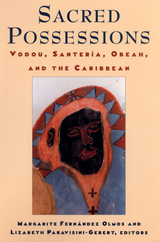 Sacred Possessions: Vodou, Santería, Obeah, and the Caribbean
Olmos, Margarite Fernândez
Rutgers University Press, 1997 Sacred Possessions is an unprecedented collection of thirteen comparative and interdisciplinary essays exploring the cross-cultural dynamics of African-based religious systems in the Caribbean. The contributors analyze the nature and liturgies of Vodou, Santeria, Obeah, Quimbois, and Gaga as they form one central cultural matrix in the region. They ask how these belief systems were affected by differing colonial histories and landscapes, and how they affected other cultural expressions (from the oral tradition to popular art and literature), and how they have been perceived and (mis)represented by the West. The book is a unique contribution to the study of the Caribbean as a site of multiculturalism, demonstrating the linkages between anthropology, religion, literature, and popular culture. Also included are a stunning photoessay on Cuban Santeria, a glossary of terms, and an insightful introduction by the editors.
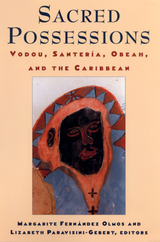 Sacred Possessions: Vodou, Santería, Obeah, and the Caribbean
Olmos, Margarite Fernândez
Rutgers University Press, 1997 Sacred Possessions is an unprecedented collection of thirteen comparative and interdisciplinary essays exploring the cross-cultural dynamics of African-based religious systems in the Caribbean. The contributors analyze the nature and liturgies of Vodou, Santeria, Obeah, Quimbois, and Gaga as they form one central cultural matrix in the region. They ask how these belief systems were affected by differing colonial histories and landscapes, and how they affected other cultural expressions (from the oral tradition to popular art and literature), and how they have been perceived and (mis)represented by the West. The book is a unique contribution to the study of the Caribbean as a site of multiculturalism, demonstrating the linkages between anthropology, religion, literature, and popular culture. Also included are a stunning photoessay on Cuban Santeria, a glossary of terms, and an insightful introduction by the editors.
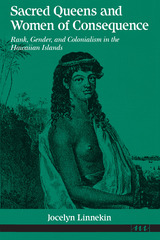 Sacred Queens and Women of Consequence: Rank, Gender, and Colonialism in the Hawaiian Islands
Jocelyn Linnekin
University of Michigan Press, 1990 Sacred Queens and Women of Consequence is a pathbreaking examination of the contact encounter in Hawaii from the perspective of Hawaiian women. Jocelyn Linnekin offers a reconstruction of Hawaiian women's authority and status before contact with the West and examines changes in their cultural valuation and social position during the first century of Western contact. Through a detailed analysis of women's roles in exchange, production, kinship, and politics during the political and economic transformations of the nineteenth century, Linnekin challenges the view that Polynesian women were doomed to a peripheral status by the ritual logic of pollution. She demonstrates how Hawaiian women maintained their position as points of access to land and power, while frequently resisting the constraints of the tabu system as well as later Western-influenced attempts to abridge their authority. This book is a unique and important contribution to the scholarship on Hawaiian history as well as to the growing literature on women and colonialism and women and social stratification. It will appeal to scholars and students who work in the areas of gender studies, social stratification, cultural change, Oceania, and historical anthropology.
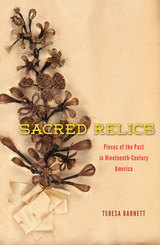 Sacred Relics: Pieces of the Past in Nineteenth-Century America
Teresa Barnett
University of Chicago Press, 2013 A piece of Plymouth Rock. A lock of George Washington’s hair. Wood from the cabin where Abraham Lincoln was born. Various bits and pieces of the past—often called “association items”—may appear to be eccentric odds and ends, but they are valued because of their connections to prominent people and events in American history. Kept in museum collections large and small across the United States, such objects are the touchstones of our popular engagement with history.
In Sacred Relics, Teresa Barnett explores the history of private collections of items like these, illuminating how Americans view the past. She traces the relic-collecting tradition back to eighteenth-century England, then on to articles belonging to the founding fathers and through the mass collecting of artifacts that followed the Civil War. Ultimately, Barnett shows how we can trace our own historical collecting from the nineteenth century’s assemblages of the material possessions of great men and women.
 The Sacred Remains: Myth, History, and Polity in Belau
Richard J. Parmentier
University of Chicago Press, 1987 Based on two years of fieldwork in Belau, an Austronesian culture in western Micronesia, The Sacred Remains is an outstanding example of the new approach to ethnographic writing that challenges Western views of the history of non-Western societies.
Richard J. Parmentier employs semiotic methods to analyze both linguistic and nonlinguistic signs representing Belauan history, showing that these signs also organize social and political structures. He identifies four pervasive semiotic patterns that appear rhetorically in myths, chants, and historical narratives and graphically in the arrangement of certain classes of stones, including village boundary markers, burial platforms, exchange valuables, and monoliths found at abandoned sites in the islands.
While not neglecting historical evidence from Western sources, Parmentier contends that the history of Belau cannot be understood without taking into full account indigenous categories of space, time, and transformation and without recognizing the importance of Belauan social actions that construct, interpret, and transmit historical knowledge. Supporting his analysis of Belauan history with concrete ethnographic demonstration, Parmentier presents a work of central importance for Austronesianists, anthropologists, and historians.
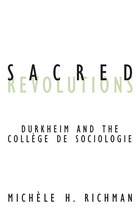 Sacred Revolutions: Durkheim And The College De Sociologie
Michele H. Richman
University of Minnesota Press, 2002 Explores the role of the sacred in the response of French intellectuals to the rise of fascism during the 1930s How is it that the most radical cultural iconoclasts of the interwar years—Georges Bataille, Roger Caillois, and Michel Leiris—could have responded to the rise of fascism by taking refuge in a "sacred sociology"? This is the question that Michèle H. Richman poses in a work that examines this seemingly paradoxical development. Her book traces the overall implications for French social thought of the "ethnographic detour" that began with Durkheim’s interest in Australian aboriginal religion—implications that reach back to the Revolution of 1789 and forward to the student protests of May 1968. Richman argues that by revising a phenomenon at once as familiar and as exotic as the sacred, these intellectuals forged a point of view relevant to politics, art, and eroticism in the modern period. Assimilating sociology to this revised notion of the sacred, they revitalized a critical discourse based on anthropological thinking dating back to Montaigne and culminating in Rousseau. Her work thus supplies an important chapter in the history of the human sciences while demonstrating the formation of an innovative critical discourse that straddles literary theory, social thought, and religious and cultural studies.
 Sacred River: A Novel
Syl Cheney-Coker
Ohio University Press, 2015 The reincarnation of a legendary nineteenth-century Caribbean emperor as a contemporary African leader is at the heart of this novel. Sacred River deals with the extraordinary lives, hopes, powerful myths, stories, and tragedies of the people of a modern West African nation. It is also the compelling love story of an idealistic philosophy professor and an ex-courtesan of incomparable beauty. Two hundred years after his death, the great Haitian emperor Henri Christophe miraculously appears in a dream to Tankor Satani, president of the fictional West African country of Kissi, with instructions for Tankor to continue Henri Christophe’s rule, which had been interrupted by “that damned Napoleon.” Ambitious in scope, Sacred River is a diaspora-inspired novel, in which Cheney-Coker has tackled the major themes of politics, social strife, crime and punishment, and human frailty and redemption in Malagueta, the fictional, magical town and its surroundings first created by the author in The Last Harmattan of Alusine Dunbar, for which he was awarded the coveted Commonwealth Writers’ Prize. Sacred River is equally about love and politics, and marks the return to fiction of one of Africa’s major writers.
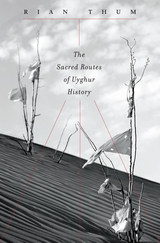 The Sacred Routes of Uyghur History
Rian Thum
Harvard University Press, 2014 For 250 years, the Turkic Muslims of Altishahr—the vast desert region to the northwest of Tibet—have led an uneasy existence under Chinese rule. Today they call themselves Uyghurs, and they have cultivated a sense of history and identity that challenges Beijing’s official national narrative. Rian Thum argues that the roots of this history run deeper than recent conflicts, to a time when manuscripts and pilgrimage dominated understandings of the past. Beyond broadening our knowledge of tensions between the Uyghurs and the Chinese government, this meditation on the very concept of history probes the limits of human interaction with the past.
Uyghur historical practice emerged from the circulation of books and people during the Qing Dynasty, when crowds of pilgrims listened to history readings at the tombs of Islamic saints. Over time, amid long journeys and moving rituals, at oasis markets and desert shrines, ordinary readers adapted community-authored manuscripts to their own needs. In the process they created a window into a forgotten Islam, shaped by the veneration of local saints.
Partly insulated from the rest of the Islamic world, the Uyghurs constructed a local history that is at once unique and assimilates elements of Semitic, Iranic, Turkic, and Indic traditions—the cultural imports of Silk Road travelers. Through both ethnographic and historical analysis, The Sacred Routes of Uyghur History offers a new understanding of Uyghur historical practices, detailing the remarkable means by which this people reckons with its past and confronts its nationalist aspirations in the present day.
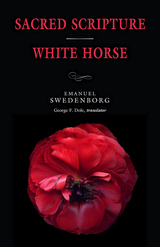 Sacred Scripture / White Horse
Emanuel Swedenborg
Swedenborg Foundation Publishers, 2015 Throughout his theological writings, Emanuel Swedenborg devotes more pages to discussing the inner, spiritual meaning of the Bible than to any other topic. In the two short works Sacred Scripture and White Horse, he provides the spiritual theory behind the verse-by-verse analysis found in his multivolume works Secrets of Heaven and Revelation Unveiled.
In Sacred Scripture, Swedenborg explains how the inner meaning of the Bible relates to its outer (literal) meaning, and he cites numerous biblical passages to show how similar themes emerge again and again. He describes two distinct layers of inner meaning—the heavenly and the spiritual—and shows how an understanding of that inner meaning strengthens a person’s connection with Deity and with heaven.
White Horse begins with a short summary of the spiritual meaning of the white horse described in Revelation 19:11. In form, what then follows is a series of statements about the inner meaning of the Bible with references to explanatory passages in Secrets of Heaven. However, when read in sequence, those statements are also a concise summary of Swedenborg’s theology of biblical interpretation.
The perspective provided by these two short works allows the reader to see through the Bible’s clouds of baffling, obscure, and seemingly inconsistent details to the power and unity of divine love and wisdom within the text. Students or seekers interested in Swedenborg’s teachings about the interrelationship between the spiritual world and the physical one will find this volume a helpful guide. Sacred Scripture / White Horse is part of the New Century Edition of the Works of Emanuel Swedenborg (NCE), an ongoing translation series. The NCE series incorporates the latest scholarship and translation standards for a more accurate and accessible rendering of Swedenborg’s works.
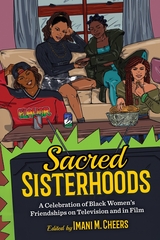 Sacred Sisterhoods: A Celebration of Black Women's Friendships on Television and in Film
Edited by Imani M. Cheers
Ohio State University Press, 2025 The dramatic expansion of Black women into creative positions in television and film production since the 1990s has introduced a previously invisible range of themes in Black women’s lives to wide audiences. In Imani M. Cheers’s richly interdisciplinary Sacred Sisterhoods, contributors offer an overdue analysis and elevation of Black women’s creative authority in popular culture: its history, successes, influence, and future possibilities. Focusing on the theme of Black women’s friendship, star voices from across academia, journalism, the arts, and activism offer critical-cultural commentary and personal reflections on the evolution of Black women directors, writers, producers, and showrunners from the 1930s through 2023.
Creative visionaries from Debbie Allen to Quinta Brunson, along with shows and films from Living Single to Hidden Figures—and many others—receive their due in these rigorous, lively, and accessible essays. Spotlighting the nuances and normalcy of Black women’s sacred sisterhoods, contributors reveal the indelible mark modern Black consciousness and creative control leave on our popular culture every day in an anthology that will be essential to scholars and students of contemporary media, race, and gender, as well as to general readers.
Contributors:
Imani M. Cheers, Monique A. Gamble, Marquita Gammage, Kandace Harris, Crystal L. Holmes, Makeba Lavan, Rondrea Danielle Mathis, Miriam J. Petty-Adams, De Anna Reese, Randi Richardson, Beretta E. Smith-Shomade, Andrene M. Taylor, Kristen Warner, and Shauntae Brown White
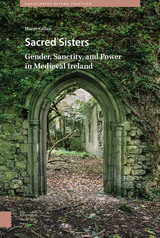 Sacred Sisters: Gender, Sanctity, and Power in Medieval Ireland
Maeve Callan
Amsterdam University Press, 2020 Sacred Sisters focuses on five saints: the four female Irish saints who have extant medieval biographies (Darerca, Brigid, Íte, and Samthann), and Patrick, whose writings -- fifth-century Ireland’s sole surviving texts -- attest to the centrality of women in Irish Christianity’s development. Women served as leaders and teachers, perhaps even as bishops and priests, and men and women worked together in a variety of arrangements as well as independently. Previous studies of gender in medieval Ireland have emphasized sexism and sex-segregated celibacy, dismissing abundant evidence of alternative approaches throughout the sources, including in the Lives of Ireland’s female saints. Sacred Sisters places these generally marginalized texts at its center, exploring their portraits of empowered, authoritative, compassionate women who exemplified an accepting and affirming ethics of gender and sexuality that would be unusual in many mainstream Christian movements in the present day, let alone in the Middle Ages.
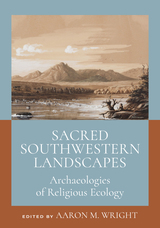 Sacred Southwestern Landscapes: Archaeologies of Religious Ecology
Edited by Aaron M. Wright
University of Utah Press, 2024 In this volume, two dozen archaeologists and allied researchers explore the intersection of religion and landscape in the North American Southwest from ancient to recent times. Although these topics continue to gain currency in contemporary inquiry, Sacred Southwestern Landscapes is the first to study them on equal footing. The essays explore how people enmesh ecological conditions and threads of environmental information into religion, weaving strands of belief and spirituality through a topographic fabric that gives meaning to the material world.
Hailing from various academic and cultural backgrounds, contributors invoke a range of theoretical currents and methodological practices to examine how these relationships developed and evolved. Nearly all the places, people, and paradigms at play in contemporary southwestern scholarship find room among these pages, from the Sonoran and Chihuahuan Deserts to the Colorado Plateau; from diverse cultures, including Ancestral Pueblo, Mogollon, Hohokam, Pataya, Trincheras, Navajo (Diné), and Nuevomexicano; and from theoretical frameworks drawing upon phenomenology, materiality, bundling, and semiotics. This collective engagement showcases how religious ecologies can be studied from multiple perspectives and through sundry lines of evidence, leaving readers with appreciation and reverence for the rich and robust sacredness in southwestern landscapes.
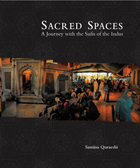 Sacred Spaces: A Journey with the Sufis of the Indus
Samina Quraeshi
Harvard University Press, 2010 Sufism, the mystical path of Islam, is a key feature of the complex Islamic culture of South Asia today. Influenced by philosophies and traditions from other Muslim lands and by pre-Islamic rites and practices, Sufism offers a corrective to the image of Islam as monolithic and uniform.
In Sacred Spaces, Pakistani artist and educator Samina Quraeshi provides a locally inflected vision of Islam in South Asia that is enriched by art and by a female perspective on the diversity of Islamic expressions of faith. A unique account of a journey through the author’s childhood homeland in search of the wisdom of the Sufis, the book reveals the deeply spiritual nature of major centers of Sufism in the central and northwestern heartlands of South Asia. Illuminating essays by Ali S. Asani, Carl W. Ernst, and Kamil Khan Mumtaz provide context to the journey, discussing aspects of Sufi music and dance, the role of Sufism in current South Asian culture and politics, and the spiritual geometry of Sufi architecture.
Quraeshi relies on memory, storytelling, and image making to create an imaginative personal history using a rich body of photographs and works of art to reflect the seeking heart of the Sufi way and to demonstrate the diversity of this global religion. Her vision builds on the centuries-old Sufi tradition of mystical messages of love, freedom, and tolerance that continue to offer the promise of building cultural and spiritual bridges between peoples of different faiths.
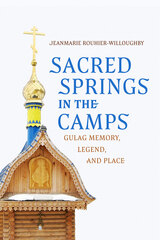 Sacred Springs in the Camps: Gulag Memory, Legend, and Place
Jeanmarie Rouhier-Willoughby
University of Wisconsin Press, 2026 Former Gulag sites—operating theaters of terror during the Stalinist period—are scattered across western Siberia, where memories of the purges run deep. The camps represent some of the most horrific events of the Soviet past, and yet their current role is complicated. Focusing on three former prison camps, folklorist Jeanmarie Rouhier-Willoughby untangles a surprising nexus of memory, legend, and vernacular religious practice afforded by the sacred springs located at each of these sites.
Grounded by detailed ethnography, Sacred Springs in the Camps explores how legend creates, negotiates, and challenges collective memory; how lived religious practices intersect with the current revival of the Russian Orthodox Church; how politics intertwine with belief; and how the social construction of sacred places affects folk narratives, faith, and local identity. These unlikely holy waters thus reflect important facets of contemporary Russian religion, politics, and society, refracting and reframing memories of the socialist past even as they offer important lessons for the present moment.
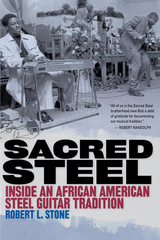 Sacred Steel: Inside an African American Steel Guitar Tradition
Robert Stone
University of Illinois Press, 2010 In this book, Robert L. Stone follows the sound of steel guitar into the music-driven Pentecostal worship of two related churches: the House of God and the Church of the Living God. A rare outsider who has gained the trust of members and musicians inside the church, Stone uses nearly two decades of research, interviews, and fieldwork to tell the story of a vibrant musical tradition that straddles sacred and secular contexts. Most often identified with country and western bands, steel guitar is almost unheard of in African American churches--except for the House of God and the Church of the Living God, where it has been part of worship since the 1930s. Sacred Steel traces the tradition through four generations of musicians and in some two hundred churches extending across the country from Florida to California, Michigan to Alabama. Presenting detailed portraits of musical pioneers such as brothers Troman and Willie Eason and contemporary masters such as Chuck Campbell, Glenn Lee, and Robert Randolph, Stone expertly outlines the fundamental tensions between sacred steel musicians and church hierarchy. In this thorough analysis of the tradition, Stone explores the function of the music in church meetings and its effect on the congregations. He also examines recent developments such as the growing number of female performers, the commercial appeal of the music, and younger musicians' controversial move of the music from the church to secular contexts.
The Sacred Struggle: Jewish Responses to Trauma
Rabbi Lindsey Danziger and Rabbi Benjamin David
Central Conference of American Rabbis, 2025 A powerful anthology of personal stories and Jewish lessons on dealing with trauma, including chapters on loss, illness, antisemitism, natural disasters, and
much more.
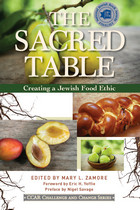 The Sacred Table: Creating a Jewish Food Ethic
Rabbi Mary L. Zamore
Central Conference of American Rabbis, 2011 The Sacred Table: Creating a Jewish Food Ethic is an anthology of diverse essays on Jewish dietary practices. This volume presents the challenge of navigating through choices about eating, while seeking to create a rich dialogue about the intersection of Judaism and food. The definition of Kashrut, the historic Jewish approach to eating, is explored, broadened and in some cases, argued with, in these essays. Kashrut is viewed not only as a ritual practice, but also as a multifaceted Jewish relationship with food and its production, integrating values such as ethics, community, and spirituality into our dietary practice. The questions considered in The Sacred Table are broad reaching. Does Kashrut represent a facade of religiosity, hiding immorality and abuse, or is it, in its purest form, a summons to raise the ethical standards of food production? How does Kashrut enrich spiritual practice by teaching intentionality and gratitude? Can paying attention to our own eating practices raise our awareness of the hungry? Can Kashrut inspire us to eat healthfully? Can these laws draw us around the same table, thus creating community? In exploring the complexities of these questions, this book includes topics such as agricultural workers’ rights, animal rights, food production, the environment, personal health, the spirituality of eating and fasting, and the challenges of eating together. The Sacred Table celebrates the ideology of educated choice. The essays present a diverse range of voices, opinions, and options, highlighting the Jewish values that shape our food ethics. Whether for the individual, family, or community, this book supplies the basic how-tos of creating a meaningful Jewish food ethic and incorporating these choices into our personal and communal religious practices. These resources will be helpful if we are new to these ideas or if we are teaching or counseling others. Picture a beautiful buffet of choices from which you can shape your personal Kashrut. Read, educate yourself, build on those practices that you already follow, and eat well.
Sacred Theatre
Edited by Ralph Yarrow
Intellect Books, 2007 The notion of the sacred has long informed the work of British dramatists like Harold Pinter and Tom Stoppard. Ralph Yarrow’s Sacred Theatre is the first book to examine the role of the sacred in the practice, process, and performance of drama. While leaving enough room for the personal and experiential, Yarrow draws on concepts from sociology, anthropology, and critical theory as well as analytical readings of plays and performance events to examine how theater interacts with the otherworldly. This volume is essential reading for anyone intrigued by the intersection of drama and consciousness. “This book takes on the enormous task of identifying not only the sacred in theatre but also questions ideas of sacred across the spectrum. It offers a great deal of material for discussion within performance and theatre theory courses.”—Jade Rosina McCutcheon, Department of Theatre and Dance, University of California, Davis
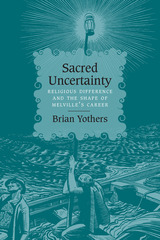 Sacred Uncertainty: Religious Difference and the Shape of Melville's Career
Brian Yothers
Northwestern University Press, 2015 Yothers’ Sacred Uncertainty examines Melville’s engagement with religious difference, both within American culture and around the world. It is impossible to understand Melville’s wider engagement with religious and cultural questions, however, without understanding the fundamental tension between self and society, self and others that underlies his work, and that is manifested in particular in the way in which he interacts with other writers. There is almost certainly no more concrete or reliable way to get at Melville’s affirmations of and arguments with these interlocutors than in the markings and annotations that appear in his copies of many of their works, so Yothers examines Melville’s marginalia for clues to Melville’s thinking about self, other, and difference. Sacred Uncertainty provides a much needed exploration of Melville’s encounter with and reflection upon religious difference.
Sacred Violence: Torture, Terror, and Sovereignty
Paul W. Kahn
University of Michigan Press, 2008 In Sacred Violence, the distinguished political and legal theorist Paul W. Kahn investigates the reasons for the resort to violence characteristic of premodern states. In a startling argument, he contends that law will never offer an adequate account of political violence. Instead, we must turn to political theology, which reveals that torture and terror are, essentially, forms of sacrifice. Kahn forces us to acknowledge what we don't want to see: that we remain deeply committed to a violent politics beyond law. Paul W. Kahn is Robert W. Winner Professor of Law and the Humanities at Yale Law School and Director of the Orville H. Schell, Jr. Center for International Human Rights. Cover Illustration: "Abu Ghraib 67, 2005" by Fernando Botero. Courtesy of the artist and the American University Museum.
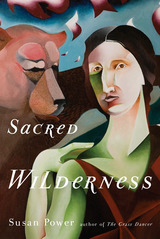 Sacred Wilderness
Susan Power
Michigan State University Press, 2014 A Clan Mother story for the twenty-first century, Sacred Wilderness explores the lives of four women of different eras and backgrounds who come together to restore foundation to a mixed-up, mixed-blood woman—a woman who had been living the American dream, and found it a great maw of emptiness. These Clan Mothers may be wisdom-keepers, but they are anything but stern and aloof—they are women of joy and grief, risking their hearts and sometimes their lives for those they love. The novel swirls through time, from present-day Minnesota to the Mohawk territory of the 1620s, to the ancient biblical world, brought to life by an indigenous woman who would come to be known as the Virgin Mary. The Clan Mothers reveal secrets, the insights of prophecy, and stories that are by turns comic, so painful they can break your heart, and perhaps even powerful enough to save the world. In lyrical, lushly imagined prose, Sacred Wilderness is a novel of unprecedented necessity.
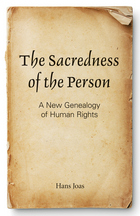 The Sacredness of the Person: A New Genealogy of Human Rights
Hans Joas
Georgetown University Press, 2015 What are the origins of the idea of human rights and universal human dignity? How can we most fully understand—and realize—these rights going into the future? In The Sacredness of the Person, internationally renowned sociologist and social theorist Hans Joas tells a story that differs from conventional narratives by tracing the concept of human rights back to the Judeo-Christian tradition or, alternately, to the secular French Enlightenment. While drawing on sociologists such as Émile Durkheim, Max Weber, and Ernst Troeltsch, Joas sets out a new path, proposing an affirmative genealogy in which human rights are the result of a process of “sacralization” of every human being. According to Joas, every single human being has increasingly been viewed as sacred. He discusses the abolition of torture and slavery, once common practice in the pre-18th century west, as two milestones in modern human history. The author concludes by portraying the emergence of the UN Declaration of Human Rights of 1948 as a successful process of value generalization. Joas demonstrates that the history of human rights cannot adequately be described as a history of ideas or as legal history, but as a complex transformation in which diverse cultural traditions had to be articulated, legally codified, and assimilated into practices of everyday life. The sacralization of the person and universal human rights will only be secure in the future, warns Joas, through continued support by institutions and society, vigorous discourse in their defense, and their incarnation in everyday life and practice.
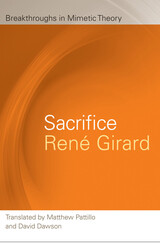 Sacrifice
René Girard
Michigan State University Press, 2011 In Sacrifice, René Girard interrogates the Brahmanas of Vedic India, exploring coincidences with mimetic theory that are too numerous and striking to be accidental. Even that which appears to be dissimilar fails to contradict mimetic theory, but instead corresponds to the minimum of illusion without which sacrifice becomes impossible.
The Bible reveals collective violence, similar to that which generates sacrifice everywhere, but instead of making victims guilty, the Bible and the Gospels reveal the persecutors of a single victim. Instead of elaborating myths, they tell the truth absolutely contrary to the archaic sense. Once exposed, the single victim mechanism can no longer function as the model for would-be sacrificers.
Recognizing that the Vedic tradition also converges on a revelation that discredits sacrifice, mimetic theory locates within sacrifice itself a paradoxical power of quiet reflection that leads, in the long run, to the eclipse of this institution which is violent but nevertheless fundamental to the development of human culture. Far from unduly privileging the Western tradition and awarding it a monopoly on the knowledge and repudiation of blood sacrifice, mimetic analysis recognizes comparable, but never truly identical, traits in the Vedic tradition.
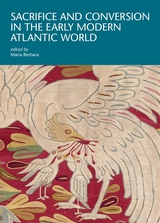 Sacrifice and Conversion in the Early Modern Atlantic World
Maria Berbara
Harvard University Press When Europeans came to the American continent in the fifteenth and sixteenth centuries, they were confronted with what they perceived as sacrificial practices. Representations of Tupinamba cannibals, Aztecs slicing human hearts out, and idolatrous Incas flooded the early modern European imagination. But there was no less horror within European borders; during the early modern period no region was left untouched by the disasters of war.
Sacrifice and Conversion in the Early Modern Atlantic World illuminates a particular aspect of the mutual influences between the European invasions of the American continent and the crisis of Christianity during the Reform and its aftermaths: the conceptualization and representation of sacrifice. Because of its centrality in religious practices and systems, sacrifice becomes a crucial way to understand not only cultural exchange, but also the power struggles between American and European societies in colonial times. How do cultures interpret sacrificial practices other than their own? What is the role of these interpretations in conversion? From the central perspective of sacrifice, these essays examine the encounter between European and American sacrificial conceptions—expressed in texts, music, rituals, and images—and their intellectual, cultural, religious, ideological, and artistic derivations.
 Sacrifice and Delight in the Mystical Theologies of Anna Maria van Schurman and Madame Jeanne Guyon
Bo Karen Lee
University of Notre Dame Press, 2014 In this compelling study of two seventeenth-century female mystics, Bo Karen Lee examines the writings of Anna Maria van Schurman and Madame Jeanne Guyon, who, despite different religious formations, came to similar conclusions about the experience of God in contemplative prayer. Van Schurman was born into a Dutch Calvinist family and became a superb scriptural commentator before undergoing a dramatic religious conversion and joining the Labadist community, a Pietistic movement. Guyon was a French layperson whose thought would be identified with Quietism—a spiritual path that was looked upon with suspicion both by the French Catholic Church and by Rome.
Lee analyzes and compares the themes of self-denial and self-annihilation in the writings of these two mystics. In van Schurman's case, the focus is on the distinction between scholastic knowledge of God and the intima notitia Dei accessible only by radical self-denial. In Guyon's case, it is on the union with God that is accessible only through a painful self-annihilation. For both authors, Lee demonstrates that the desire for enjoyment of God plays an important role as the engine of the soul's progress away from self-centeredness. The appendices offer facing Latin and English translations of two letters by van Schurman and a selection from her Eukleria.
"In this fascinating study of two influential seventeenth-century mystics, Bo Karen Lee explores the intricate and often paradoxical connections between sacrifice of self and delight in God. Lee’s careful exposition of primary texts by Anna Maria van Schurman and Madame Jeanne Guyon reveals a theological profundity that continues to challenge, provoke, and inspire. The daring spiritualities of these two women (one Protestant, one Catholic) offer an intriguing comparative case study in early modern Christian thought." —Arthur Holder, John Dillenberger Professor of Christian Spirituality, Graduate Theological Union
"Bo Karen Lee's subtle study of Madame Guyon and Anna Maria van Schurman explores how these writers found a source of power, leadership, and creativity in self-denial. It is an important contribution to the history and literature of Christian spirituality—including Protestant spirituality, which remains underinvestigated—and to discussions around contested questions at the intersection of feminism and religion." —Stephanie Paulsell, Houghton Professor of the Practice of Ministry Studies, Harvard Divinity School
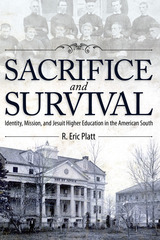 Sacrifice and Survival: Identity, Mission, and Jesuit Higher Education in the American South
R. Eric Platt
University of Alabama Press, 2014 Recounts the history and development of Jesuit higher education in the American South
R. Eric Platt examines in Sacrifice and Survival the history and evolution of Jesuit higher education in the American South and hypothesizes that the identity and mission of southern Jesuit colleges and universities may have functioned as catalytic concepts that affected the “town and gown” relationships between the institutions and their host communities in ways that influenced whether they failed or adapted to survive.
The Catholic religious order known as the Society of Jesus (Jesuits) manages a global network of colleges and universities with a distinct Catholic identity and mission. Despite this immense educational system, several Jesuit institutions have closed throughout the course of the order’s existence. Societal pressures, external perceptions or misperceptions, unbalanced curricular structures rooted in liberal arts, and administrators’ slow acceptance of courses related to practical job seeking may all influence religious-affiliated educational institutions. The religious identity and mission of these colleges and universities are fundamentals that influence their interaction with external environs and contribute to their survival or failure.
Platt traces the roots of Jesuit education from the rise of Ignatius Loyola in the mid-sixteenth century through the European development of the Society of Jesus, Jesuit educational identity and mission, the migration of Jesuits to colonial New Orleans, the expulsion of Jesuits by Papal mandate, the reorganization of Jesuit education, their attempt to establish a network of educational institutions across the South, and the final closure of all but two southern Jesuit colleges and a set of high schools.
Sacrifice and Survival explores the implications of the Galveston Hurricane of 1900, yellow fever, Georgia floods, devastating fires, the Civil War, the expansion of New Orleans due to the 1884 Cotton Centennial Exposition, and ties between town and gown, as well as anti-Catholic/anti-Jesuit sentiment as the Society of Jesus pushed forward to create a system of southern institutions. Ultimately, institutional identity and mission critically impacted the survival of Jesuit education in the American South.
Sacrifice As Gift
Michon M. Matthiesen
Catholic University of America Press, 2012 Sacrifice as Gift is a timely presentation of a forgotten vision of eucharistic sacrifice, one that reconfigures the current philosophical and theological divide between sacrifice and gift.
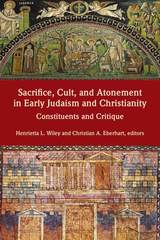 Sacrifice, Cult, and Atonement in Early Judaism and Christianity: Constituents and Critique
Henrietta L. Wiley
SBL Press, 2016 Critical and creative studies that offer fresh perspectives on ancient ideas and practices
The contributions to this volume deal in various ways with the cult at the Jerusalem Temple that epitomized the religious, cultural, and socio-political identity of Judaism for many centuries. Some essays examine ancient constitutive practices and concepts, such as purification rituals, sacrifices, atonement, or sacred authorities at the temple, with the goal of interpreting their meanings for modern readers. Other essays explore alternatives to ancient cultic meaning and practice. Essays critique established traditions, attempt to renegotiate them, or use metaphor and spiritualization to expand the potential of these phenomena to serve as terminological and ideological resources. Thus they examine and affirm the continuing relevance of ancient Jewish cultic notions long after the destruction of the Second Temple in 70 CE.
- An international group of scholars representing different fields and diverse religious backgrounds
- A thorough examination of traditions as through the lens of contemporaneous interpretive traditions such as Jewish prophecy, the Dead Sea Scrolls, and Early Christian literature
- Examination of topics such as purification, sacrifice, and atonement, and the depiction and development of sacred authority throughout the Bible
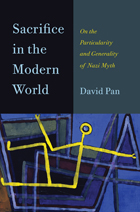 Sacrifice in the Modern World: On the Particularity and Generality of Nazi Myth
David Pan
Northwestern University Press, 2012 A landmark book, David Pan’s Sacrifice in the Modern World seeks to explain the continuing emphasis, in modern times, on sacrifice. Pan specifically turns to the culture of sacrifice—ritualized and sanctified death—in Nazi Germany, showing how that regime co-opted an existing discussion of sacrifice and infused it with its own mythology. Pan suggests that sacrifice is a key value in every society but that there is a preponderance of association of sacrifice with Nazi culture and therefore a largely pejorative treatment of sacrifice. Surveying the arguments of philosopher Alfred Baeumler and other symptomatic Nazi texts, Pan shows how the Nazis’ reactionary intellectual culture unraveled much of the Enlightenment project. In so doing, he is able to offer a compelling new perspective on basic theoretical concepts in the work of Kant, Nietzsche, Adorno, Bataille, Girard, and others. He posits that it is only by clearing our way through the Nazis’ misuse of sacrifice that we can understand the durability of sacrificial structures that—following several of the theorists he discusses— establish the fundamental values by which we live our lives. Rather than condemning the Nazi appeal to sacrifice itself, this book looks at the particular ways in which sacrifice was distributed and structured within that society. All cultures must grapple with the existential violence of the human condition, and they frequently do so through aesthetic treatments of sacrifice, rooted in myths and traditions. Pan argues that our task is not to eradicate these traditions but to engage them by carefully evaluating the commitments and values that they imply.
Sacrifice: Its Nature and Functions
Henri Hubert and Marcel Mauss
University of Chicago Press, 1981 Marcel Mauss was the nephew and most distinguished pupil of Émile Durkheim, whose review L'Année sociologique he helped to found and edit. Henri Hubert was another member of the group of sociologists who developed under the influence of Durkheim.
The present book is one of the best-known essays pulbished in L'Année sociologique and has been regarded as a model for method and mode of interpretation. Its subject is at the very center of the comparative study of religion. The authors describe a basic sacrifice drawn from Indian sources and show what is fundamental and constant, comparing Indian and Hebrew practices in particular, then Greek and Roman, then additional practices from many eras and cultures.
The Sacrifice of Socrates: Athens, Plato, Girard
Wm. Blake Tyrrell
Michigan State University Press, 2012 When Athenians suffered the shame of having lost a war from their own greed and foolishness, around 404 BCE the public’s blame was directed at Socrates, a man whose unique appearance and behavior, as well as his disapproval of the democracy, made him a ready target. Socrates was subsequently put on trial and sentenced to death. However, as René Girard has pointed out, no individual can be held responsible for a communal crisis. Plato’s Apology depicts Socrates as both the bane and the cure of Greek society, while his Crito shows a sacrificial Socrates, what some might consider a pharmakos figure, the human drug through whom Plato can dispense his philosophical remedies. With tremendous insight and satisfying complexity, this book analyzes classical texts through the lens of Girard’s mimetic mechanism.
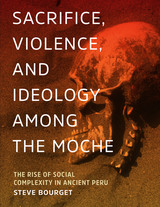 Sacrifice, Violence, and Ideology Among the Moche: The Rise of Social Complexity in Ancient Peru
By Steve Bourget
University of Texas Press, 2016 In a special precinct dedicated to ritual sacrifice at Huaca de la Luna on the north coast of Peru, about seventy-five men were killed and dismembered, their remains and body parts then carefully rearranged and left on the ground with numerous offerings. The discovery of this large sacrificial site—one of the most important sites of this type in the Americas—raises fundamental questions. Why was human sacrifice so central to Moche ideology and religion? And why is sacrifice so intimately related to the notions of warfare and capture? In this pioneering book, Steve Bourget marshals all the currently available information from the archaeology and visual culture of Huaca de la Luna as he seeks to understand the centrality of human sacrifice in Moche ideology and, more broadly, the role(s) of violence in the development of social complexity. He begins by providing a fully documented account of the archaeological contexts, demonstrating how closely interrelated these contexts are to the rest of Moche material culture, including its iconography, the regalia of its elite, and its monumental architecture. Bourget then probes the possible meanings of ritual violence and human sacrifice and their intimate connections with concepts of divinity, ancestry, and foreignness. He builds a convincing case that the iconography of ritual violence and the practice of human sacrifice at all the principal Moche ceremonial centers were the main devices used in the establishment and development of the Moche state.
 Sacrifice Your Love: Psychoanalysis, Historicism, Chaucer
L.O. Aranye Fradenburg
University of Minnesota Press, 2002 A long-awaited reevaluation of Chaucer through the lens of sacrifice by a major figure in medieval studies Historicism and its discontents have long been central to the work of Louise Fradenburg, one of the world’s most original and provocative literary medievalists. Sacrifice Your Love brings this interest to bear on Chaucer’s writing and his world, rethought in light of a theory of sacrifice and its part in cultural production. Fradenburg writes the "history of the signifier"—a way of reading change in the symbolic order—and its role in making sacrifice enjoyable. Sacrifice Your Love develops the idea that sacrifice is a mode of enjoyment—that our willingness to sacrifice our desire is actually a way of pursuing it. Fradenburg considers the implications of this idea for various problems important in medieval studies today—how to understand the religiosity of cultural forms, particularly chivalry, in the later Middle Ages and how to understand the ethics of Chaucer’s famously nondidactic poetry—as well as in other fields of inquiry. A major rethinking of Chaucer, Sacrifice Your Love works in depth as well as across a broad range of topics from medievalism to psychoanalysis, advancing both the theory and practice of a new kind of historicist approach.
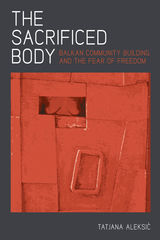 The Sacrificed Body: Balkan Community Building and the Fear of Freedom
Tatjana Aleksic
University of Pittsburgh Press, 2013 Living in one of the world’s most volatile regions, the people of the Balkans have witnessed unrelenting political, economic, and social upheaval. In response, many have looked to building communities, both psychologically and materially, as a means of survival in the wake of crumbling governments and states. The foundational structures of these communities often center on the concept of individual sacrifice for the good of the whole. Many communities, however, are hijacked by restrictive ideologies, turning them into a model of intolerance and exclusion.
In The Sacrificed Body, Tatjana Aleksic examines the widespread use of the sacrificial metaphor in cultural texts and its importance to sustaining communal ideologies in the Balkan region. Aleksic further relates the theme to the sanctioning of ethnic cleansing, rape, and murder in the name of homogeneity and collective identity. Aleksic begins her study with the theme of the immurement of a live female body in the foundation of an important architectural structure, a trope she finds in texts from all over the Balkans. The male builders performing the sacrificial act have been called by a higher power who will ensure the durability of the structure and hence the patriarchal community as a whole.
In numerous examples ranging from literature to film and performance art, Aleksic views the theme of sacrifice and its relation to exclusion based on gender, race, class, sexuality, religion, or politics for the sake of community building. According to Aleksic, the sacrifice narrative becomes most prevalent during times of crisis brought on by wars, weak governments, foreign threats, or even globalizing tendencies. Because crisis justifies the very existence of restrictive communities, communalist ideology thrives on its perpetuation. They exist in a symbiotic relationship. Aleksic also acknowledges the emancipatory potential of a genuine community, after it has shaken off its ideological character.
Aleksic employs cultural theory, sociological analysis, and human rights studies to expose a historical narrative that is predominant regionally, if not globally. As she determines, in an era of both Western and non-Western neoliberalism, elitist hegemony will continue to both threaten and bolster communities along with their segregationist tactics.
 Sad by Design: On Platform Nihilism
Geert Lovink
Pluto Press, 2019 Melancholy has always been with us. Nowadays, though, it’s a design problem—its highs and lows coded into the social media platforms on which we spend so much of our lives. We click, we scroll; we swipe, we like. And after it all, we wonder where the time went, and what, other than a flat and empty feeling, we got for it.
Sad by Design offers a critical analysis of our social media environment and what it’s doing to us. Geert Lovink analyzes the problems of toxic viral memes, online addiction, and the lure of fake news. He shows how attempts to design sites to solve these problems have, in their studied efforts to be apolitical, been unable to generate either a serious critique or legitimate alternatives. But there is an answer: Lovink calls for us to acknowledge the engineered intimacy of these sites—because boredom, he argues, is the first stage of overcoming “platform nihilism,” which can free us to organize to stop the data harvesting industries that run them.
 The Sad Citizen: How Politics Is Depressing and Why It Matters
Christopher Ojeda
University of Chicago Press, 2025 For many citizens, politics is depressing. How has this come to be the norm? And, how is it influencing democracy? From rising polarization to climate change, today’s politics are leaving many Western democracies in the throes of malaise. While anger, anxiety, and fear are loud emotions that powerfully activate voters, depression is quiet, demobilizing, and less visible as a result. Yet its pervasiveness is cause for concern: after all, democracy should empower citizens. In The Sad Citizen, Christopher Ojeda draws on wide-ranging data from the United States and beyond to explain how politics is depressing, why this matters, and what we can do about it. Integrating insights from political science, sociology, psychology, and other fields, The Sad Citizen exposes the unhappy underbelly of contemporary politics and offers fresh ideas to strengthen democracy and help citizens cope with the stress of politics.
 Sadat and After: Struggles for Egypt's Political Soul
Raymond William Baker
Harvard University Press, 1990 Most analyses of Egyptian politics present the limitations and failures of official political life as the complete story of politics in Egypt. Raymond Baker's direct observation of Egyptian politics has convinced him that alternative political groups have sustained themselves and carved out spaces for promising political action despite official efforts at containment.
In this compelling study, Baker recreates the public worlds of eight groups on the periphery of Egyptian politics. They range in their political stances from Communists to the Muslim Brothers and include shifting clusters of critical intellectuals who gather around influential journals or in research centers, as well as the quiescent aestheticists of the Wissa Wassef community. Taken together, the experiences of Egyptians in alternative groups reveal that Egyptians are more than the objects of diverse external pressures and more than the sufferers from multiple internal problems. They are also creative political actors who have stories to tell about the human potential to struggle for humane values and goals in the modern world.
In examining Egypt from the margins rather than from the center, Baker proposes a new direction for Third World political studies. He suggests a way out of the impasse in the current development literature, which is fixed on a scientific study of causes and determinants, by focusing on actual political struggles and alternative political visions.
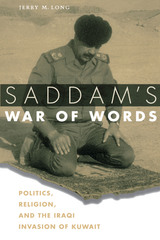 Saddam's War of Words: Politics, Religion, and the Iraqi Invasion of Kuwait
By Jerry M. Long
University of Texas Press, 2004 From a Western perspective, the Persian Gulf War of 1990-1991 largely fulfilled the first President Bush's objective: "In, out, do it, do it right, get gone. That's the message." But in the Arab world, the causes and consequences of Saddam Hussein's invasion of Kuwait and his subsequent defeat by a U.S.-led coalition were never so clear-cut. The potent blend of Islam and Arab nationalism that Saddam forged to justify the unjustifiable—his invasion of a Muslim state—gained remarkable support among both Muslims and Arabs and continued to resonate in the Middle East long after the fighting ended. Indeed, as this study argues in passing, it became a significant strand in the tangled web of ideologies and actions that led to the attacks of 9/11. This landmark book offers the first in-depth investigation of how Saddam Hussein used Islam and Arab nationalism to legitimate his invasion of Kuwait in the eyes of fellow Muslims and Arabs, while delegitimating the actions of the U.S.-led coalition and its Arab members. Jerry M. Long addresses three fundamental issues: how extensively and in what specific ways Iraq appealed to Islam during the Kuwait crisis; how elites, Islamists, and the elusive Arab "street," both in and out of the coalition, responded to that appeal and why they responded as they did; and the longer-term effects that resulted from Saddam's strategy.
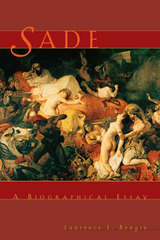 Sade: A Biographical Essay
Laurence L. Bongie
University of Chicago Press, 1998 The writings of the Marquis de Sade have recently attained notoriety in the canon of world literature. Now Sade himself is often celebrated as a heroic apostle of individual rights and a giant of philosophical thought. In this detailed investigative work, Laurence Bongie tests these claims and finds them unfounded and undeserved.
"A valuable correction to the perception of Sade as a profound thinker, a great writer, and a martyr to liberty. Drawing on original archival work, Bongie tries to illuminate Sade's childhood and his relationship with his parents. . . . Fluent and well-informed."—Library Journal
"Mr. Bongie . . . has written an investigation focusing on one aspect of Sade's character and development, his heretofore neglected relationship with his aristocratic mother. . . . A profitable selection."—Richard Bernstein, New York Times
"A welcome corrective. Bongie's book . . . aims to deflate the exalted claims made about the marquis by demonstrating that he was a monstrous character."—Scott Stossel, Boston Phoenix Literary Supplement
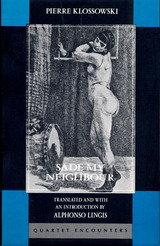 Sade My Neighbor
Pierre Klossowski
Northwestern University Press, 1991 Enlightenment ideals of a society rooted in liberationist reason and morality were trampled in the wake of the savagery of the Second World War. That era's union of cold technology and ancient hatreds gave rise to a dark, alternative reason—an ethic that was value-free and indifferent with regard to virtue and vice, freedom, and slavery. In a world where "the unthinkable" had become reality, it is small wonder that theorists would turn to the writings of a man whose eighteenth-century imagination preceded twentieth-century history in its unbridled exploration of viciousness, perversion, and monstrosity: the Marquis de Sade.
Klossowski was one of the first philosophers in postwar Europe to ask whether Sade's reason, although aberrant and perverted to evil passions, could be taken seriously. Klossowski's seminal work inspired virtually all subsequent study of Sadean thought, including that of de Beauvoir, Deleuze, Derrida, Bataille, Blanchot, Paulhan, and Lacan.
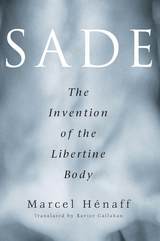 Sade: The Invention Of The Libertine Body
Marcel Henaff
University of Minnesota Press, 1999 A new model for examining Sade and his creations. A new model for examining Sade and his creations. Decried as a misogynist and pornographer, imprisoned for debauchery and for his writings, there is scarcely a cultural figure as flamboyant and controversial as the Marquis de Sade, the father of the new libertine body. But this is not, Hénaff maintains, the only way to see Sade. In this long-awaited English translation, Hénaff says that Sade should be discussed less for the sensual heat of his writing and more for the larger poetic and economic model his work represents.With unabashed candor, Sade describes bodies in terms not of flesh but of production, use, exchange, and waste. In his writing, this libertine self is unleashed from its constraints, no longer bound by old conceptions of desire and traditions of courtship. Hénaff’s argument that Sade is a sign of his times-exposing the courtly facade of a society unable to preserve itself-reveals dark, disquieting secrets about the direction of civilization. The libertine body, he says, is a child of this new order.ISBN 0-8166-2536-0 Cloth £34.50 $49.95xxISBN 0-8166-2537-9 Paper £14.00 $19.95x296 Pages 5 7/8 x 9 OctoberTranslation inquiries: University of Minnesota Press
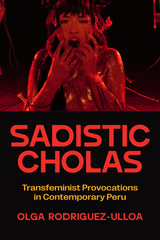 Sadistic Cholas: Transfeminist Provocations in Contemporary Peru
Olga Rodriguez-Ulloa
University of Texas Press, 2026 Analyzing how Peruvian feminist art and activism subverts and reclaims the chola stereotype to confront colonial and patriarchal institutions. Indigenous Andean women have long been derided in Peru, spurned by colonial and then national elites as depraved cholas. Olga Rodriguez-Ulloa shows how contemporary artists and activists not only reclaim this term of abuse but also mobilize the stereotype of the angry and perverted chola to confront the cruelties of patriarchy, capitalism, and white supremacy. Sadistic Cholas examines music, visual arts, literature, and grassroots organizing by self-identified cholas—in particular, Black women and trans and queer feminists. Under colonial domination, cholas were destined for sexual coercion, labor extraction, and reproductive exploitation. While exhuming historical traces of chola resistance, Rodriguez-Ulloa argues that this condition of oppression persisted through the internal war of the 1980s, when Marxist women at the forefront of the armed campaign were condemned as hypersexual deviants. Inspired by their leftist forebears, today’s artists experiment with an aesthetic of sadistic vengeance, configured as rightful self-defense. Yet, in spite of their violent imagery, activist cholas pursue nonviolent goals, promoting a commons of care incorporating people, animals, and the environment.
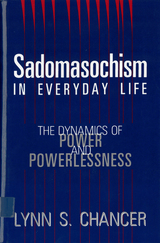 Sadomasochism in Everyday Life: The Dynamics of Power and Powerlessness
Chancer, Lynn S.
Rutgers University Press, 1992 Lynn Chancer advances the provocative thesis that sadomasochism is far more prevalent in contemporary societies like the United States than we realize. According to Chancer, sexual sadomasochism is only the best-known manifestation of what is actually a much more broadly based social phenomenon. Moving from personal relationships to school, the workplace, and other interactions, Chancer uses a variety of examples that are linked by a recurrent pattern of behavior. She goes beyond the predominantly individualistic and psychological explanations generally associated with sadomasochism (including those popularized in the "how to" literature of the recent Women Who Love Too Much genre) toward a more sociological interpretation. Chancer suggests that the structure of societies organized along male-dominated and capitalistic lines reflects and perpetuates a sadomasochistic social psychology, creating a culture steeped in everyday experiences of dominance and subordination.
In the first part of the book, Chancer discusses the prevalence of sadomasochistic cultural imagery in contemporary America and examines sadomasochism through several perspectives. She develops a set of definitional traits both through existential analysis of an instance of S/M sex and by incorporating a number of Hegelian and psychoanalytic concepts. In the second part of the book, she places sadomasochism in a broader context by exploring whether and how it appears in the workplace and how it relates to gender and race.
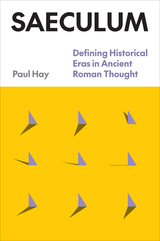 Saeculum: Defining Historical Eras in Ancient Roman Thought
Paul Hay
University of Texas Press, 2023 How the notion of unique eras influenced the Roman view of time and the narration of history from various perspectives.
The Victorian Era. The Age of Enlightenment. The post-9/11 years. We are accustomed to demarcating history, fencing off one period from the next. But societies have not always operated in this way. Paul Hay returns to Rome in the first century BCE to glimpse the beginnings of periodization as it is still commonly practiced, exploring how the ancient Romans developed a novel sense of time and used it to construct their views of the past and of the possibilities of the future. It was the Roman general Sulla who first sought to portray himself as the inaugurator of a new age of prosperity, and through him Romans adopted the Etruscan term saeculum to refer to a unique era of history. Romans went on to deepen their investment in periodization by linking notions of time to moments of catastrophe, allowing them to conceptualize their own epoch and its conclusion, as in the literature of Vergil and Horace. Periodization further introduced the idea of specific agents of change into Roman thought—agents that were foundational to narratives of progress and decline. An eye-opening account, Saeculum describes nothing less than an intellectual and cognitive revolution, that fundamentally reorganized the meanings of history and time.
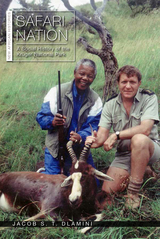 Safari Nation: A Social History of the Kruger National Park
Jacob S. T. Dlamini
Ohio University Press, 2020 Safari Nation opens new lines of inquiry in the study of national parks in Africa and the rest of the world. The Kruger National Park is South Africa’s most iconic nature reserve, renowned for its rich flora and fauna. According to author Jacob Dlamini, there is another side to the park, a social history neglected by scholars and popular writers alike in which blacks (meaning Africans, Coloureds, and Indians) occupy center stage. Safari Nation details the ways in which black people devoted energies to conservation and to the park over the course of the twentieth century—engagement that transcends the stock (black) figure of the laborer and the poacher. By exploring the complex and dynamic ways in which blacks of varying class, racial, religious, and social backgrounds related to the Kruger National Park, and with the help of previously unseen archival photographs, Dlamini’s narrative also sheds new light on how and why Africa’s national parks—often derided by scholars as colonial impositions—survived the end of white rule on the continent. Relying on oral histories, photographs, and archival research, Safari Nation engages both with African historiography and with ongoing debates about the “land question,” democracy, and citizenship in South Africa.
Safavid Iran and Her Neighbors
Michel M. Mazzaoui
University of Utah Press, 2013 The Safavid dynasty (1501–1786) had its origins in one of the many Turkish, possibly Kurdish, dervish orders begun shortly after the Mongol invasion. By the late fifteenth century it had taken on both Shi'a ideology and a military aspect. Its founder, Isma'il, took advantage of the chaotic political situation at the end of the century to establish control over the territory that comprises most of current-day Iran. Under Safavid rule, Persia moved from Sunni to Shi'i Islam and has remained so into the present.
Safavid Iran and Her Neighbors focuses primarily on Persian external relations during this period. The wide-ranging contributions to this volume cover dervish orders, the Central Asian hajj, developments in Shi'i legal theory, cultural relations between Persia and Mughal India, and diplomatic relations between Iran, Russia, and Ottoman Turkey.
 A Safe and Sustainable World: The Promise Of Ecological Design
Nancy Jack Todd
Island Press, 2005 In the late sixties, as the world was waking to a need for Earth Day, a pioneering group founded a small non-profit research and education organization they called the New Alchemy Institute. Their aim was to explore the ways a safer and more sustainable world could be created. In the ensuing years, along with scientists, agriculturists, and a host of enthusiastic amateurs and friends, they set out to discover new ways that basic human needs--in the form of food, shelter, and energy--could be met. A Safe and Sustainable World is the story of that journey, as it was and as it continues to be. The dynamics and the resilience of the living world were the Institute's model and the inspiration for their research. Central to their efforts then and now is, along with science, a spiritual quest for a more harmonious human role in our planet's future. The results of this work have now entered mainstream science through the emerging discipline of ecological design. Nancy Jack Todd not only relates a fascinating journey from lofty ideals through the hard realities encountered in learning how to actually grow food, harness the energy of the sun and wind, and design green architecture. She also introduces us to some of the heroes and mentors who played a vital role in those efforts as well, from Buckminster Fuller to Margaret Mead. The early work of the Institute culminated in the design and building of two bioshelters--large greenhouse-like independent structures called Arks, that provided the setting for much of the research to follow. Successfully proving through the Institute's designs and investigations that basic land sustainability is achievable, John Todd and the author founded a second non-profit research group, Ocean Arks International. Here they applied the New Alchemy's natural systems thinking to restoring polluted waters with the invention and implementation of biologically based living technologies called Ecomachines and Pond and Lake Restorers. A Safe and Sustainable World demonstrates what has and can be done--it also looks to what must be done to integrate human ingenuity and the four billion or so years of evolutionary intelligence of the natural world into healthy, decentralized, locally dreams hard won--and hope.
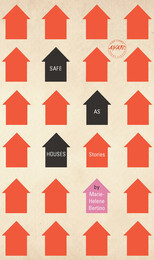 Safe as Houses
Marie-Helene Bertino
University of Iowa Press, 2012 Safe as Houses, the debut story collection of Marie-Helene Bertino, proves that not all homes are shelters. The titular story revolves around an aging English professor who, mourning the loss of his wife, robs other people's homes of their sentimental knick-knacks. In "Free Ham," a young dropout wins a ham after her house burns down and refuses to accept it. “Has my ham done anything wrong?” she asks when the grocery store manager demands that she claim it. In "Carry Me Home, Sisters of Saint Joseph," a failed commercial writer moves into the basement of a convent and inadvertently discovers the secrets of the Sisters of Saint Joseph. A girl, hoping to talk her brother out of enlisting in the army, brings Bob Dylan home for Thanksgiving dinner in the quiet, dreamy "North Of." In “The Idea of Marcel,” Emily, a conservative, elegant girl, has dinner with the idea of her ex-boyfriend, Marcel. In a night filled with baffling coincidences, including Marcel having dinner with his idea of Emily, she wonders why we tend to be more in love with ideas than with reality. In and out of the rooms of these gritty, whimsical stories roam troubled, funny people struggling to reconcile their circumstances to some kind of American Ideal and failing, over and over. The stories of Safe as Houses are magical and original and help answer such universal and existential questions as: How far will we go to stay loyal to our friends? Can we love a man even though he is inches shorter than our ideal? Why doesn’t Bob Dylan ever have his own smokes? And are there patron saints for everything, even lost socks and bad movies? All homes are not shelters. But then again, some are. Welcome to the home of Marie-Helene Bertino.
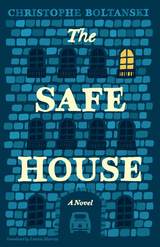 The Safe House: A Novel
Christophe Boltanski
University of Chicago Press, 2017 In Paris’s exclusive Saint-Germain neighborhood is a mansion. In that mansion lives a family. Deep in that mansion. The Bolts are that family, and they have secrets. The Safe House tells their story.
When the Nazis came, Étienne Boltanski divorced his wife and walked out the front door, never to be seen again during the war. So far as the outside world knew, the Jewish doctor had fled. The truth was that he had sneaked back to hide in a secret crawl space at the heart of the house. There he lived for the duration of the war. With the Liberation, Étienne finally emerged, but he and his family were changed forever—anxious, reclusive, yet proudly eccentric. Their lives were spent, amid Bohemian disarray and lingering wartime fears, in the mansion’s recesses or packed comically into the protective cocoon of a Fiat.
That house (and its vehicular appendage) is at the heart of Christophe Boltanski’s ingeniously structured, lightly fictionalized account of his grandparents and their extended family. The novel unfolds room by room—each chapter opening with a floorplan— introducing us to the characters who occupy each room, including the narrator’s grandmother--a woman of “savage appetites”--and his uncle Christian, whose haunted artworks would one day make him famous. “The house was a palace,” Boltanski writes, “and they lived like hobos.” Rejecting convention as they’d rejected the outside world, the family never celebrated birthdays or even marked the passage of time, living instead in permanent stasis, ever more closely bonded to the house itself.
The Safe House was a literary sensation when published in France in 2015 and won the Prix de Prix, France’s most prestigious book prize. A French-language film adaptation, La cache, was released in 2025. With hints of Oulipian playfulness and an atmosphere of dark humor, The Safe House is an unforgettable portrait of a self-imprisoned family.
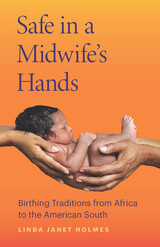 Safe in a Midwife's Hands: Birthing Traditions from Africa to the American South
Linda Janet Holmes
Ohio State University Press, 2023 A Ms. Magazine “Most Anticipated Feminist Book of 2023” After a less-than-positive experience giving birth as a Black woman in the 1970s, Linda Janet Holmes launched a lifetime of work as an activist dedicated to learning about and honoring alternative birth traditions and the Black women behind them. Safe in a Midwife’s Hands brings together what Holmes has gleaned from the countless midwives who have shared with her their experiences, at a time when their knowledge and holistic approaches are essential counterbalances to a medical system that routinely fails Black mothers and babies. Building on work she began in the 1980s, when she interviewed traditional Black midwives in Alabama and Virginia, Holmes traveled to Ghana, Ethiopia, and Kenya to visit midwives there. In detailing their work, from massage to the uses of medicinal plants to naming ceremonies, she links their voices to those of midwives and doulas in the US. She thus illuminates parallels between birthing traditions that have survived hundreds of years of colonialism, enslavement, Jim Crow, and ongoing medical racism to persist as vital cultural practices that promote healthy outcomes for mothers and babies during pregnancy, birth, and beyond.
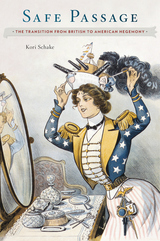 Safe Passage: The Transition from British to American Hegemony
Kori Schake
Harvard University Press, 2017 History records only one peaceful transition of hegemonic power: the passage from British to American dominance of the international order. What made that transition uniquely cooperative and nonviolent? Does it offer lessons to guide policy as the United States faces its own challengers to the order it has enforced since the 1940s? To answer these questions, Kori Schake explores nine points of crisis or tension between Britain and the United States, from the Monroe Doctrine in 1823 to the establishment of the unequal “special relationship” during World War II.
Over this period, Safe Passage shows, the United States gradually changed the rules that Britain had established at its imperial height. It was able to do so peacefully because, during the crucial years, Britain and the United States came to look alike to each other and different from other nations. Britain followed America’s lead in becoming more democratic, while the United States, because of its conquest of the American West, developed an imperial cast of mind. Until the end of World War II, both countries paid more attention to their cumulative power relative to other states in the order than to their individual power relative to each other.
The factors that made the Anglo-American transition peaceful, notably the convergence in their domestic ideologies, are unlikely to apply in future transitions, Schake concludes. We are much more likely to see high-stake standoffs among competing powers attempting to shape the international order to reflect the starkly different ideologies that prevail at home.
 Safe Passages: Highways, Wildlife, and Habitat Connectivity
Edited by Jon P. Beckmann, Anthony P. Clevenger, Marcel P. Huijser, Jodi A. Hilty
Island Press, 2010 Safe Passages brings together in a single volume the latest information on the emerging science of road ecology as it relates to mitigating interactions between roads and wildlife. This practical handbook of tools and examples is designed to assist individuals and organizations thinking about or working toward reducing road-wildlife impacts. The book provides: - an overview of the importance of habitat connectivity with regard to roads
- current planning approaches and technologies for mitigating the impacts of highways on both terrestrial and aquatic species
- different facets of public participation in highway-wildlife connectivity mitigation projects
- case studies from partnerships across North America that highlight successful on-the-ground implementation of ecological and engineering solutions
- recent innovative highway-wildlife mitigation developments
Detailed case studies span a range of scales, from site-specific wildlife crossing structures, to statewide planning for habitat connectivity, to national legislation. Contributors explore the cooperative efforts that are emerging as a result of diverse organizations—including transportation agencies, land and wildlife management agencies, and nongovernmental organizations—finding common ground to tackle important road ecology issues and problems. Safe Passages is an important new resource for local-, state-, and national-level managers and policymakers working on road-wildlife issues, and will appeal to a broad audience including scientists, agency personnel, planners, land managers, transportation consultants, students, conservation organizations, policymakers, and citizens engaged in road-wildlife mitigation projects.
A Safe Place: Laying the Groundwork of Psychotherapy
Leston Havens
Harvard University Press, 1987 Drawing on his rich experience within psychiatry, Leston Havens takes the reader on an extraordinary journey through the vast and changing landscape of psychotherapy and psychiatry today. Closely examining the dynamics of the doctor–patient exchange, he seeks to locate and describe the elusive therapeutic environment within which psychological healing most effectively takes place.
Safe Places: Stories
Kerry Dolan
University of Massachusetts Press, 2022 Exploring the vagaries of life, human connection, and desire, the twelve stories of Safe Places navigate the fault lines of existence. Shifting from New York and Chicago to the American West and the Australian outback, Kerry Dolan’s characters move through an uncertain and unpredictable world, confronting situations that are alternately menacing, tragic, and funny. An aspiring anthropologist falls under the sway of her fortuneteller. An American tourist catches opal fever in an Australian mining town and binds herself to a man she despises. Two hitchhiking teens take a ride with a mysterious stranger, while an unstable graduate student stalks the object of his affections across Berkeley. Assured and distinctive, the voice-driven stories of this debut collection capture the restless heart of characters in a state of flux, as they try—and frequently fail—to move beyond chance and circumstance.
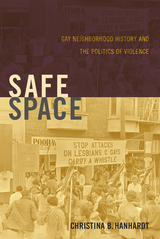 Safe Space: Gay Neighborhood History and the Politics of Violence
Christina B. Hanhardt
Duke University Press, 2013 Winner, 2014 Lambda Literary Award in LGBT Studies Since the 1970s, a key goal of lesbian and gay activists has been protection against street violence, especially in gay neighborhoods. During the same time, policymakers and private developers declared the containment of urban violence to be a top priority. In this important book, Christina B. Hanhardt examines how LGBT calls for "safe space" have been shaped by broader public safety initiatives that have sought solutions in policing and privatization and have had devastating effects along race and class lines. Drawing on extensive archival and ethnographic research in New York City and San Francisco, Hanhardt traces the entwined histories of LGBT activism, urban development, and U.S. policy in relation to poverty and crime over the past fifty years. She highlights the formation of a mainstream LGBT movement, as well as the very different trajectories followed by radical LGBT and queer grassroots organizations. Placing LGBT activism in the context of shifting liberal and neoliberal policies, Safe Space is a groundbreaking exploration of the contradictory legacies of the LGBT struggle for safety in the city.
 Safe Third Countries: Extending the EU Asylum and Immigration Policies to Central and Eastern Europe
Sandra Lavenex
Central European University Press, 1999 The refugee issue has always been controversial and Lavenex's analyses add fuel to an already heated debate. She analyses the various bi- and multilateral processes by which the countries of Central and Eastern Europe (CEECs) are being gradually incorporated into a restrictive refugee regime established among the EU member states, in which the CEECs serve as "gate-keepers" for refugees and immigrants heading towards Western Europe. At a time when many transition countries are trying to enter the EU, Lavenex highlights the CEECs consent to adapt to Western European policies aimed at fighting illegal immigration and reducing the numbers of asylum seekers as a political bargaining tool in exchange for future membership in the EU. She also argues that the regime undermines the values of international refugee protection and diffuses states' responsibilities by establishing a system of negative redistribution for the handling of asylum claims. Safe Third Countries is the first comprehensive study on the extension of the emergent European refugee regime and highlights, in an innovative manner, the complex entanglement of domestic policies, European integration and international relations.
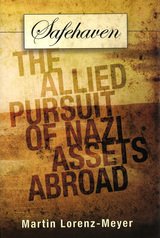 Safehaven: The Allied Pursuit of Nazi Assets Abroad
Martin Lorenz-Meyer
University of Missouri Press, 2007
As Germany faced inevitable defeat in World War II, the Allies became concerned that the Nazis would attempt to hide their assets in neutral countries—Switzerland, Sweden, Portugal, Spain, and Turkey—in order to revive their cause in later years. To address this danger, the United States, along with Britain and France as reluctant partners, started the “Safehaven” program to probe questions of secret foreign bank accounts, the German wartime gold trade, and the actions of German companies abroad toward the end of the Nazi regime. Initiated by the Federal Economic Administration, Safehaven was soon integrated with U.S. plans, advocated by Treasury Secretary Henry Morgenthau, to avert future German aggression. These proposals quickly fell out of favor, but the Morgenthau Plan’s suggestion to use all German assets as reparations remained attractive.
In this first detailed historical study of Safehaven in English, Martin Lorenz-Meyer focuses on policies of the Allies, revealing their disagreements about the program and addressing the historical roots of a problem that over decades the Cold War had successfully buried. Lorenz-Meyer shows how American administrative agencies were constantly at odds regarding Safehaven’s administration and how coordination of the program was further complicated by different assumptions held by the United States and Britain regarding its aims. Using Sweden as an example, he offers an investigation of the effects of Safehaven in the neutral countries, drawing comparisons with experiences of the program in Switzerland. His research discloses the sums involved and the neutral countries’ positions and also explores the complications posed by international law for any plan to expropriate German assets.
Over time, the neutral countries objected to uncompensated confiscations for a war in which they had not participated, and the United States gradually lost interest in infringing on German wealth because Germany was needed as a new ally. Lorenz-Meyer tells how Safehaven suffered from the discontinuation of wartime controls in a renewed climate of free trade. He also contends that the very problem that necessitated the program raised questions regarding the true neutrality of the countries involved.
Safehaven is a significant addition to the history of Third Reich and international relations, notably concerning American foreign policy. As America continues to face foreign-policy dilemmas regarding trade with enemies and issues of neutrality, Safehaven offers an illuminating case history that sheds new light on current affairs.
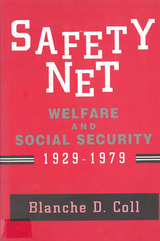 Safety Net: Welfare and Social Security, 1929-1979
Coll, Blanche D
Rutgers University Press, 1995 Beginning with the stock market crash of 1929, Blanche Coll documents the evolution of the federal and state government policymaking for welfare and Social Security, our "safety net." As Coll points out, the policies that determine who is "entitled" to aid, how standard dollar amounts are set, child support responsibilities, the equitable fiscal division between state, federal, and local governments, and the resulting impact on the poorÐÐparticularly women and children of all racesÐÐhave fluctuated throughout the history of welfare.
Coll shows how demographic patterns, the definition of a family, the relative health of the economy, and Presidents' political agendas all deeply affect the system of entitlements to Social Security and welfare, the kernal of the American welfare state.
Safety Net is the only comprehensive history of modern welfare in the United States. Clearly written and unpolemical, it is based on a wealth of primary sources, interviews with key policymakers, and the authoritative analysis of a trained historian who served as a research administrator in the federal government through Democractic and Republican administrations. Saftey Net will be indispensable reading for everyone concerned with contemporary debates about welfare and Social Security.
The Safety of Deeper Water: A Novel
Tim Poland
West Virginia University Press, 2009 When Sandy Holston is on dry land, she’s nothing special: a nurse who wears her hair in a ponytail and prefers a fishing lure as an earring. But once she dons waders, picks up a fly rod, and steps into a river, she becomes a remarkable, elegant fisherwoman who’s at peace with the world. After surviving her marriage to Vernon - her violent, incarcerated ex-husband - peace is just what Sandy needs. So she moves to Damascus, a small town on the Ripshin River, where she plans to enjoy the fishing and the solitude. Finally she is on the brink of a life she desires in a place she loves. But as the Ripshin’s trout mysteriously die off, and as Sandy grows closer to a reclusive neighbor who has a propensity for fishing naked, her plans are put in jeopardy. Will Sandy be able to find peace - in the river or out - once Vernon is released from prison and fulfills his promise to hunt her down?
 Safety Orange
Anna Watkins Fisher
University of Minnesota Press, 2021 How fluorescent orange symbolizes the uneven distribution of safety and risk in the neoliberal United States
Safety Orange first emerged in the 1950s as a bureaucratic color standard in technical manuals and federal regulations in the United States. Today it is most visible in the contexts of terror, pandemic, and environmental alarm systems; traffic control; work safety; and mass incarceration. In recent decades, the color has become ubiquitous in American public life—a marker of the extreme poles of state oversight and abandonment, of capitalist excess and dereliction. Its unprecedented saturation encodes the tracking of those bodies, neighborhoods, and infrastructures judged as worthy of care—and those deemed dangerous and expendable. Here, Anna Watkins Fisher uses Safety Orange as an interpretive key for theorizing the uneven distribution of safety and care in twenty-first-century U.S. public life and for pondering what the color tells us about neoliberalism’s intensifying impact often hiding in plain sight in ordinary and commonplace phenomena.
Forerunners: Ideas First is a thought-in-process series of breakthrough digital publications. Written between fresh ideas and finished books, Forerunners draws on scholarly work initiated in notable blogs, social media, conference plenaries, journal articles, and the synergy of academic exchange. This is gray literature publishing: where intense thinking, change, and speculation take place in scholarship.
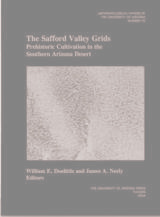 The Safford Valley Grids: Prehistoric Cultivation in the Southern Arizona Desert
William E. Doolittle
University of Arizona Press, 2004 Crisscrossing Pleistocene terrace tops and overlooking the Gila River in southeastern Arizona are acres and acres of rock alignments that have perplexed archaeologists for a century. Well known but poorly understood, these features have long been considered agricultural, but exactly what was cultivated, how, and why remained a mystery. Now we know. Drawing on the talents of a team of scholars representing various disciplines, including geology, soil science, remote sensing, geographical information sciences (GISc), hydrology, botany, palynology, and archaeology, the editors of this volume explain when and why the grids were built.
Between A.D. 750 and 1385, people gathered rocks from the tops of the terraces and rearranged them in grids of varying size and shape, averaging about 4 meters to 5 meters square. The grids captured rainfall and water accumulated under the rocks forming the grids. Agave was planted among the rocks, providing a dietary supplement to the maize and beans that were irrigated on the nearby bottom land, a survival crop when the staple crops failed, and possibly a trade commodity when yields were high. Stunning photographs by Adriel Heisey convey the vastness of the grids across the landscape.
Saga / Circus
Lyn Hejinian
Omnidawn, 2008 Saga / Circus, by the esteemed poet Lyn Hejinian, brings us two distinctly different long poems in which the tropes of narrative and lyric—their feints and demands—stake claims amongst the actual characters presented. In this playful yet penetrating pair of poems, it is the character of Lyn Hejinian's thought meeting our character of thought that is one of the most exciting and most constant dramatic events of the book—the richly sensational & subversive crescendos register as both melodic and discordant soundtrack.
The Saga of Coe Ridge: A Study in Oral History
William Lynwood Montell
University of Tennessee Press, 1981 Few black groups in the United States carry with them the romance, the gripping history, the pathos, the indestructible spirit of the Coe Ridge colony during the ninety years of its existence.
". . . a new and long needed departure in American historiography. . . . This is in every way an impressive book. It contains detailed accounts of the informants, tables of folklore motifs, genealogical charts, a prologue and epilogue explaining authoritatively the hypotheses of oral traditional history, and handsome photographs of the Coe Ridge area."
--Richard M. Dorson, Journal of American History.
"Lynwood Montell has written an invaluable book for all those interested in the use of oral tradition as a tool in the reconstruction of history. . . . This is a book worthy of being on any folklorist's shelf."
--Richaed A. Reuss, Journal of American Folklore.
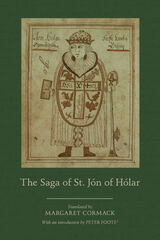 The Saga of St. Jón of Hólar
Translated by Margaret Cormack, With an Introduction byPeter Foote
Arizona Center for Medieval and Renaissance Studies, 2020 This volume contains a translation of the version of the Saga of St. Jón of Hólar that is probably closest to the first Latin vita. It is only the second saga of an Icelandic episcopal saint to appear in a modern translation in the present century. The volume consists of two parts, the first comprising a general introduction and a translation by Margaret Cormack. The second part provides a detailed scholarly analysis of the manuscripts, contents, style, and literary connections of the saga by the late Peter Foote, one of the foremost scholars of Old Norse and Icelandic literature. The Jóns saga was written in the early thirteenth century, nearly a century after the death of its protagonist, the first bishop of the diocese of Hólar in Northern Iceland. The author of the saga combined Latin learning with native folklore to produce a readable narrative that is contemporary with the earliest family and contemporary sagas. This text provides valuable insight into the religious life of ordinary Icelanders in the thirteenth century, and the introduction corrects common misconceptions about ecclesiastical history and the cult of saints in Iceland. It will be of value to scholars of medieval Icelandic literature, hagiography, and history.
The Saga of the Jomsvikings
Translated from the Old Icelandic by Lee M. Hollander
University of Texas Press, 1955 In A.D. 986, Earl Hákon, ruler of most of Norway, won a triumphant victory over an invading fleet of Danes in the great naval battle of Hjórunga Bay. Sailing under his banner were no fewer than five Icelandic skalds, the poet-historians of the Old Norse world. Two centuries later their accounts of the battle became the basis for one of the liveliest of the Icelandic sagas, with special emphasis on the doings of the Jómsvikings, the famed members of a warrior community that feared no one and dared all. In Lee M. Hollander's faithful translation, all of the unknown twelfth-century author's narrative genius and flair for dramatic situation and pungent characterization is preserved.
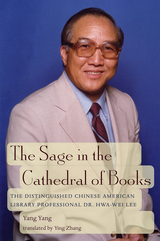 The Sage in the Cathedral of Books: The Distinguished Chinese American Library Professional Dr. Hwa-Wei Lee
Yang Yang
Ohio University Press, 2016 The biography of Dr. Hwa-Wei Lee, who was awarded the highly prestigious Melvil Dewey Medal by the American Library Association in 2015, will be welcomed by readers interested in knowing not only more about Lee’s personal achievements and contributions in librarianship but also about the rapid changes in the library profession in general. The biography, written by Ms. Yang Yang of China Central Television in Beijing, was first published in Chinese in China in 2011. It was republished in Taiwan with added information in 2014. This English edition, translated by Dr. Ying Zhang of the Universityof California in Irvine, was updated by Lee. Throughout his childhood and youth, Lee experienced tremendous hardship during the brutal Sino-Japanese War and then the Chinese civil war, described in the first three chapters. After arriving in the United States as a graduate student from Taiwan in 1957, he struggled to realize the American dream by studying hard and working diligently in the field of librarianship for nearly half a century. The biography explores Lee’s career at major academic libraries, beginning at the University of Pittsburgh to his retirement from Ohio University, including his seven years of library directorship at the Asian Institute of Technology in Bangkok, Thailand, under the sponsorship of the U.S. Agency for International Development. After his first retirement, Lee was invited by OCLC to become a Visiting Distinguished Scholar. From there he was appointed Chief of the Asian Division at the Library of Congress and retired for the second time in 2008. The biography also highlights Lee’s contributions in international librarianship, especially in the promotion of library cooperation between the United States and China.
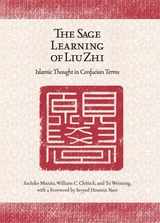 The Sage Learning of Liu Zhi: Islamic Thought in Confucian Terms
Sachiko Murata, William C. Chittick, and Tu Wei-mingForeword by Seyyed Hossein Nasr
Harvard University Press, 2009 Liu Zhi (ca. 1670–1724) was one of the most important scholars of Islam in traditional China. His Tianfang xingli (Nature and Principle in Islam), the Chinese-language text translated here, focuses on the roots or principles of Islam. It was heavily influenced by several classic texts in the Sufi tradition. Liu’s approach, however, is distinguished from that of other Muslim scholars in that he addressed the basic articles of Islamic thought with Neo-Confucian terminology and categories. Besides its innate metaphysical and philosophical value, the text is invaluable for understanding how the masters of Chinese Islam straddled religious and civilizational frontiers and created harmony between two different intellectual worlds.
The introductory chapters explore both the Chinese and the Islamic intellectual traditions behind Liu’s work and locate the arguments of Tianfang xingli within those systems of thought. The copious annotations to the translation explain Liu’s text and draw attention to parallels in Chinese-, Arabic-, and Persian-language works as well as differences.
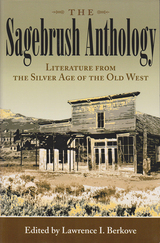 The Sagebrush Anthology: Literature from the Silver Age of the Old West
Edited by Lawrence I. Berkove
University of Missouri Press, 2006
Sagebrush School is a term applied to a group of writers who spent their creative years in Nevada from the 1860s to the early twentieth century—its most illustrious representative being Mark Twain. Yet most of their work was never republished from the periodicals in which it first appeared and today remains largely unknown to many scholars and aficionados of Western literature.
Lawrence I. Berkove, acknowledged as the leading authority on this body of literature, has assembled an exceptional collection that rescues the lively works of the Sagebrush School from the dusty archives in which they have languished. The Sagebrush Anthology enlarges Mark Twain’s circle to encompass the Sagebrush Bohemians through a compelling blend of humorous and serious fiction, memoir, nonfiction, letters, and poetry. These selections convey the experiences shaped by Nevada’s rough-and-tumble culture, abounding in wit and humor—with a fondness for literary hoaxes—that were the last major formative influence on Twain.
The anthology contains sixty-eight selections—seven by Twain—representing outstanding work by accomplished Sagebrushers Dan De Quille, Sam Davis, Joe Goodman, and Rollin Daggett, plus pieces by lesser-known writers such as Arthur McEwen, Alf Doten, and Fred Hart. Berkove’s introduction recounts the history of the school and identifies and analyzes its main thematic and stylistic characteristics. He shows that Sagebrush literature records and reflects the collision of the last generation of frontiersmen with the new culture of technology, industry, and big business—men of talent, imagination, and integrity driven to work out distinctive ways of coping with an unresponsive system of justice, an economy tilted toward the rich, and a society that impinged on individual liberties.
Although many critics have noted the influence that this period had on Twain when he lived in Virginia City, few have delineated the influence of specific writers on his style. The Sagebrush Anthology not only shows that some of the ideas and literary techniques credited to Twain can be seen as characteristics of the school that he assimilated and refined, but it also fosters an appreciation of these other writers in their own right, showing that their work encompassed topics and genres that Twain barely addressed. By casting new light on the movement, it invites students and general readers to appreciate a silver flowering of Western literature that remains entertaining and instructive for our own time.
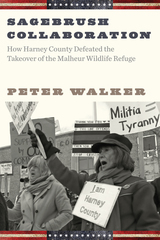 Sagebrush Collaboration: How Harney County Defeated the Takeover of the Malheur Wildlife Refuge
Peter Walker
Oregon State University Press, 2018 Every American is co-owner of the most magnificent estate in the world—federal public forests, grazing lands, monuments, national parks, wildlife refuges, and other public places. The writer Wallace Stegner famously referred to public lands as “America’s best idea,” but there have always been some who oppose the idea for ideological reasons, or because they have a vested economic interest. In the current decade, federal public lands have been under physical threat as never before, with armed standoffs and takeovers that the US government has proved stunningly unsuccessful at prosecuting in federal courts. One such incident was the takeover of the Malheur National Wildlife Refuge in Harney County, Oregon, in 2016. Armed militants seized the headquarters of the refuge for forty-one days and occupied the community for three months. Militants threatened and harassed local residents, pledging to “give back” the land to unnamed “rightful owners” in their effort to enact a fringe interpretation of the US Constitution. Drawing on more than two years of intensive fieldwork, Sagebrush Collaboration shows that the militants failed in their objectives because the sensible and hardworking citizens of Harney County had invested decades in collaboratively solving the very problems that the militia used to justify their anti–federal government revolution. In Sagebrush Collaboration, Peter Walker offers the first book-length study of why the 2016 takeover of the Malheur National Wildlife Refuge failed. His nuanced and deeply researched account provides the full context for the takeover, including the response from local and federal officials and the grassroots community resistance. It will be essential reading for years to come for anyone who wants to understand the ongoing battle over the future of America’s public lands.
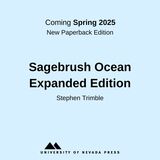 The Sagebrush Ocean: 35th Anniversary Edition
Stephen Trimble
University of Nevada Press, 2026 New paperback edition coming Spring 2025! Noted writer and photographer Stephen Trimble mixes eloquent accounts of personal experiences with clear explication of natural history. His photographs capture some of the most spectacular but least-known scenery in the western states. The Great Basin Desert sweeps from the Sierra to the Rockies, from the Snake River Plain to the Mojave Desert. "Biogeography" would be one way to sum up Trimble's focus on the land: what lives where, and why. He introduces concepts of desert ecology and discusses living communities of animals and plants that band Great Basin mountains—from the exhilarating emptiness of dry lake-beds to alpine regions at the summits of the 13,000-foot Basin ranges. This is the best general introduction to the ecology and spirit of the Great Basin, a place where "the desert almost seems to mirror the sky in size," where mountains hold "ravens, bristlecone pines, winter stillness—and unseen, but satisfying, the possibility of bighorn sheep." Trimble's photographs come from the backcountry of this rugged land, from months of exploring and hiking the Great Basin wilderness in all seasons; and his well-chosen words come from a rare intimacy with the West.
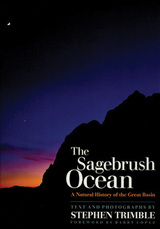 The Sagebrush Ocean, Tenth Anniversary Edition: A Natural History Of The Great Basin
Stephen Trimble
University of Nevada Press, 1999 Noted writer and photographer Stephen Trimble mixes eloquent accounts of personal experiences with clear explication of natural history. His photographs capture some of the most spectacular but least-known scenery in the western states. The Great Basin Desert sweeps from the Sierra to the Rockies, from the Snake River Plain to the Mojave Desert. "Biogeography" would be one way to sum up Trimble's focus on the land: what lives where, and why. He introduces concepts of desert ecology and discusses living communities of animals and plants that band Great Basin mountains—from the exhilarating emptiness of dry lake-beds to alpine regions at the summits of the 13,000-foot Basin ranges.
This is the best general introduction to the ecology and spirit of the Great Basin, a place where "the desert almost seems to mirror the sky in size," where mountains hold "ravens, bristlecone pines, winter stillness—and unseen, but satisfying, the possibility of bighorn sheep." Trimble's photographs come from the backcountry of this rugged land, from months of exploring and hiking the Great Basin wilderness in all seasons; and his well-chosen words come from a rare intimacy with the West.
The Sagebrush State, 3d Edition: Nevada's History, Government, and Politics
Michael W. Bowers
University of Nevada Press, 2006 Since its publication in 1996, The Sagebrush State has served as the text for the required course on Nevada’s history and constitution given at the state’s colleges and universities. The third edition of this work is updated through 2005 to include information on the elections of 2002 and 2004 and two very controversial sessions of the legislature. The full text of the state constitution is provided for reference in an appendix and includes extensive annotations that note and explain amendments and other changes made to the original 1864 document.
The Sagebrush State, 4th Ed: Nevada’s History, Government, and Politics
Michael W. Bowers
University of Nevada Press, 2013 Nevada’s politics have been formed in large measure by its turbulent history and harsh environment. Bowers’ concise volume explains the dynamics of this process, which is strikingly unique among the fifty states. This is a readable and insightful explanation of how Nevada’s history has formed its political culture, and how its government works today. The Sagebrush State includes the full text of the state constitution, with extensive annotations of all amendments to the original 1864 document. The Sagebrush State serves as a text for the study of Nevada’s history and constitution, which is a graduation requirement at the state’s colleges and universities. The fourth edition of this work is updated through 2012 to include information on the elections of 2010 and 2012 and recent controversial sessions of the Legislature.
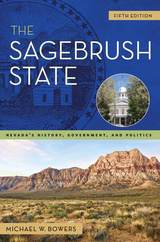 The Sagebrush State, 5th Edition: Nevada's History, Government, and Politics
Michael W. Bowers
University of Nevada Press, 2018 Nevada’s politics are in large measure the result of its turbulent history and harsh environment. Michael W. Bowers’ concise volume explains the dynamics of the political formation process, which is strikingly unique among the fifty states. Even today, Nevada is unlike the other states in its politics and culture: it’s economically right, yet libertarian, the home of widespread gaming and a 24/7 lifestyle, has a high percentage of federally-owned lands, and has one of the highest rates of urbanism in the U.S., yet is often governed by rural legislators.
This comprehensive and insightful explanation discusses how Nevada’s history has shaped its political culture, and how its government operates today. The Sagebrush State serves as a highly readable and accessible text for the study of Nevada’s political history and constitution, which is a graduation requirement at the state’s colleges and universities. The fifth edition is updated through 2017 and includes the full text of the state constitution with extensive annotations of all amendments to the original 1864 document.
The Sagebrush State, 6th Edition: Nevada's History, Government, and Politics
Michael W. Bowers
University of Nevada Press, 2021 Nevada’s politics are in large measure the result of its turbulent history and harsh environment. Michael W. Bowers’s concise volume explains the dynamics of the political formation process, which is strikingly unique among the fifty states. Even today, Nevada is unlike the other states in its politics and culture: economically right, yet libertarian and home to widespread gaming and a 24/7 lifestyle. It has a high percentage of federally owned lands and one of the highest rates of urbanism in the United States, yet is often dominated by rural legislators. The sixth edition is updated through 2020 and includes the full text of the state constitution with extensive annotations of all amendments to the original 1864 document.
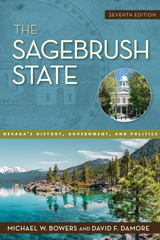 The Sagebrush State, 7th Edition: Nevada's History, Government, and Politics
Michael W. Bowers
University of Nevada Press, 2025 A dynamic study of Nevada’s government and politics from the state’s inception to the present day. Starting with Michael W. Bowers’s first edition published in 1996, this concise volume explains the unique dynamics of Nevada’s formation and its political and economic development. David F. Damore continues this legacy in the book’s seventh edition by describing how even today, Nevada is unlike the other states in its politics and culture: economically conservative and averse to strong state government, yet socially libertarian and home to widespread gaming anchored by a 24/7 industry. Nevada has the highest percentage of federally owned lands and one of the highest rates of urbanization in the United States, yet it has often been dominated by rural legislators.
This comprehensive and insightful volume examines how Nevada’s history and founding have shaped its political culture and how its government operates today. The Sagebrush State serves as a highly readable and accessible text for the study of Nevada’s political history and constitution. The seventh edition is updated through 2023 and includes the results of the 2022 elections, policies advanced during the 2023 legislative session, and Nevada’s continuing recovery from the impacts of the COVID-19 recession. The full text of the state constitution with extensive annotations of all amendments to the original 1864 document is provided as an appendix.
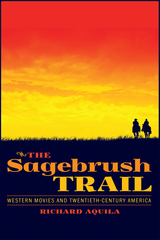 The Sagebrush Trail: Western Movies and Twentieth-Century America
Richard Aquila
University of Arizona Press, 2015 The Sagebrush Trail is a history of Western movies but also a history of twentieth-century America. Richard Aquila’s fast-paced narrative covers both the silent and sound eras, and includes classic westerns such as Stagecoach, A Fistful of Dollars, and Unforgiven, as well as B-Westerns that starred film cowboys like Tom Mix, Gene Autry, and Hopalong Cassidy.
The book is divided into three parts. Part 1 traces the birth and growth of Westerns from 1900 through the end of World War II. Part 2 focuses on a transitional period in Western movie history during the two decades following World War II. Finally, part 3 shows how Western movies reflected the rapid political, social, and cultural changes that transformed America in the 1960s and the last decades of the twentieth century.
The Sagebrush Trail explains how Westerns evolved throughout the twentieth century in response to changing times, and it provides new evidence and fresh interpretations about both Westerns and American history. These films offer perspectives on the past that historians might otherwise miss. They reveal how Americans reacted to political and social movements, war, and cultural change. The result is the definitive story of Western movies, which contributes to our understanding of not just movie history but also the mythic West and American history. Because of its subject matter and unique approach that blends movies and history, The Sagebrush Trail should appeal to anyone interested in Western movies, pop culture, the American West, and recent American history and culture.
The mythic West beckons but eludes. Yet glimpses of its utopian potential can always be found, even if just for a few hours in the realm of Western movies. There on the silver screen, the mythic West continues to ride tall in the saddle along a “sagebrush trail” that reveals valuable clues about American life and thought.
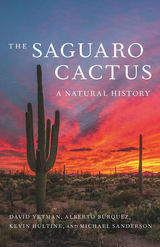 The Saguaro Cactus: A Natural History
David Yetman, Alberto Búrquez, Kevin Hultine, and Michael Sanderson, with Frank S. Crosswhite
University of Arizona Press, 2020 The saguaro, with its great size and characteristic shape—its arms stretching heavenward, its silhouette often resembling a human—has become the emblem of the Sonoran Desert of southwestern Arizona and northwestern Mexico. The largest and tallest cactus in the United States, it is both familiar and an object of fascination and curiosity.
This book offers a complete natural history of this enduring and iconic desert plant. Gathering everything from the saguaro’s role in Sonoran Desert ecology to its adaptations to the desert climate and its sacred place in Indigenous culture, this book shares precolonial through current scientific findings.
The saguaro is charismatic and readily accessible but also decidedly different from other desert flora. The essays in this book bear witness to our ongoing fascination with the great cactus and the plant’s unusual characteristics, covering the saguaro’s: history of discovery, place in the cactus family, ecology, anatomy and physiology, genetics, and ethnobotany. The Saguaro Cactus offers testimony to the cactus’s prominence as a symbol, the perceptions it inspires, its role in human society, and its importance in desert ecology.
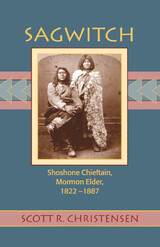 Sagwitch: Shoshone Chieftan, Mormon Elder 1822-1887
Scott Christensen
Utah State University Press, 1999 The Northwestern Shoshone knew as home the northern Great Salt Lake, Bear River, Cache, and Bear Lake valleys of northern Utah. Sagwitch was born at a time when his people traded with the mountain men. In the late 1850s, wagons brought Mormon farmers to settle in Cache Valley, the Northwestern Shoshone heartland. Emigrants and settlers reduced Shoshone access to traditional village sites and food resources. Relationships with the Mormons were mostly good but often strained, and the Shoshone treatment of migrants, who now traveled north and south as well as west and east through the area, was increasingly opportunistic. It only took a few violent incidents for a zealous army colonel to seek severe punishment of the Northwestern Shoshone on a winter morning in 1863. The Bear River Massacre was among the bloodiest engagements of America's Indian wars. Hundreds of Shoshone, including Sagwitch's wife and two sons, died; Sagwitch was wounded but escaped. The band was shattered, other chiefs dead. The following years were very hard for the survivors. The federal government negotiated a treaty with them but failed to get Sagwitch's signature when, en route to the sessions, he was arrested and then wounded by a white assassin. With the world around him changed, Sagwitch sought accommodation with the most immediate threat to his people's traditional way of survival—the Mormons occupying the Shoshone's valleys. This, then, is also the story of the conversion of Sagwitch and his band to the Mormon Church. Though not without problems, that conversion was long lasting and thorough. Sagwitch and other Shoshone would demonstrate in important ways their new religious devotion. With the assistance of Mormon leaders, they established the Washakie community in northern Utah. Though efforts to secure a land base had an uneven history, they partly succeeded, and the story of these Shoshone's attempts at rural farming diverged significantly from what happened on government reservations. When Sagwitch died, his death went almost unnoticed outside of Washakie, but his children and grandchildren continued to be important voices among a people who, after experiencing near annihilation, survived in the new world into which Sagwitch led them.
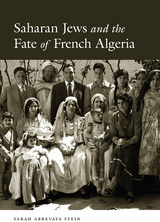 Saharan Jews and the Fate of French Algeria
Sarah Abrevaya Stein
University of Chicago Press, 2014 The history of Algerian Jews has thus far been viewed from the perspective of communities on the northern coast, who became, to some extent, beneficiaries of colonialism. But to the south, in the Sahara, Jews faced a harsher colonial treatment. In Saharan Jews and the Fate of French Algeria, Sarah Abrevaya Stein asks why the Jews of Algeria’s south were marginalized by French authorities, how they negotiated the sometimes brutal results, and what the reverberations have been in the postcolonial era.
Drawing on materials from thirty archives across six countries, Stein tells the story of colonial imposition on a desert community that had lived and traveled in the Sahara for centuries. She paints an intriguing historical picture—of an ancient community, trans-Saharan commerce, desert labor camps during World War II, anthropologist spies, battles over oil, and the struggle for Algerian sovereignty. Writing colonialism and decolonization into Jewish history and Jews into the French Saharan one, Saharan Jews and the Fate of French Algeria is a fascinating exploration not of Jewish exceptionalism but of colonial power and its religious and cultural differentiations, which have indelibly shaped the modern world.
 Saharan Winds: Energy Systems and Aeolian Imaginaries in Western Sahara
Joanna Allan
West Virginia University Press, 2024 Winner, ASLE-UKI Critical Book Prize, 2025
Finalist, Ecocritical Book Award, 2025, Association for the Study of Literature and Environment (ASLE)
Longlisted, Bread and Roses Award for Radical Publishing, 2025 As climate crisis ensues, a transition away from fossil fuels becomes urgent. However, some renewable energy developments are propagating injustices such as landgrabs, colonial dispossession, and environmentally destructive practices. Changing the way we imagine and understand wind will help us ensure a globally just wind energy future. Saharan Winds contributes to a fairer energy horizon by illuminating the role of imaginaries--how we understand energy sources such as wind and the meanings we attach to wind--in determining the wider politics, whether oppressive or just, associated with energy systems. This book turns to various cultures and communities across different time periods in one space, Western Sahara, to explore how wind imaginaries affect the development, management, and promotion of windfarms; the distribution of energy that windfarms produce; and, vitally, the type of politics mediated by all these elements combined. Highlighting the wind-fueled oppression of colonial energy systems, the book shows the potential offered by nomadic, Indigenous wind imaginaries for contributing to a fairer energy future.
Sahel Visions: Planned Settlement and River Blindness Control in Burkina Faso
Della E. McMillan
University of Arizona Press, 1994 When an international health initiative succeeded in wiping out river blindness in Burkina Faso, it allowed the settlement of the sparsely populated Volta Valley by the Mossi people--a development plan by which the Burkinabe government sought to relieve population pressure, establish communities, and increase cotton production. Anthropologist Della McMillan followed this visionary plan over twelve years as people relocated communities, founded farms, dealt with officials, entered the market, and in some instances moved on. Her study examines the question of how development occurs or fails to occur and offers unusual insight into how visions of progress--held by developers, settlers, and even researchers--originate and are revised.
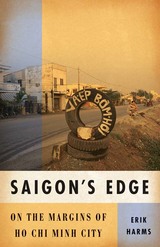 Saigon’s Edge: On the Margins of Ho Chi Minh City
Erik Harms
University of Minnesota Press, 2010 Much of the world’s population inhabits the urban fringe, an area that is neither fully rural nor urban. Hóc Môn, a district that lies along a key transport corridor on the outskirts of Ho Chi Minh City, epitomizes one of those places. In Saigon’s Edge, Erik Harms explores life in Hóc Môn, putting forth a revealing perspective on how rapid urbanization impacts the people who live at the intersection of rural and urban worlds.
Unlike the idealized Vietnamese model of urban space, Hóc Môn is between worlds, neither outside nor inside but always uncomfortably both. With particular attention to everyday social realities, Harms demonstrates how living on the margin can be both alienating and empowering, as forces that exclude its denizens from power and privilege in the inner city are used to thwart the status quo on the rural edges.
More than a local case study of urban change, Harms’s work also opens a window on Vietnam’s larger turn toward market socialism and the celebration of urbanization—transformations instructively linked to trends around the globe.
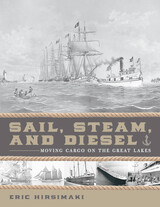 Sail, Steam, and Diesel: Moving Cargo on the Great Lakes
Eric Hirsimaki
Michigan State University Press, 2024 Water transportation has played a key role in the Great Lakes region’s settlement and economic growth, from providing entry into the new lake states to offering cheap transportation for the goods they produced. There are numerous tales surrounding the Great Lakes shipping trade, but few storytellers have addressed the factors that influenced the use, design, and evolution of the ships that sailed the inland seas. Sail, Steam, and Diesel: Moving Cargo on the Great Lakes provides a comprehensive overview of the evolution of Great Lakes ships over the centuries, from small birch-bark canoes originally used in the region to the massive thousand-footers of today. The author also looks at the economics of vessel operation in the context of the expanding scope of the shipping industry, which was crucial in catapulting America into becoming an industrial juggernaut. The captains of industry and the sailors whose labor propelled the trade populate this account, which also offers solemn acknowledgment of the high cost paid in both lost ships and lives. Although they might not realize it, millions of Americans have owed their livelihoods to the Great Lakes boats, and this volume is an excellent way to recognize the importance of this regional industry.
A Sail to Great Island
Alan Feldman
University of Wisconsin Press, 2004 The first full-length collection in many years by an award-winning poet whose work has appeared in The Atlantic, The New Yorker, The Nation, Poetry, The Kenyon Review, The Threepenny Review, and a host of other journals.
Sailing Against the Wind: A Novel
Jaan Kross
Northwestern University Press, 2012 Jaan Kross's historical novel Sailing Against the Wind fictionalizes the life of Bernhard Schmidt (1879–1935), an Estonian-born inventor. Schmidt lost an arm in his youth while experimenting with a homemade rocket, resulting in psychological trauma that would plague him for the rest of his life. Largely self-taught, Schmidt was driven to seek recognition of his talents.
He moved to Germany in the 1930s, where, after perfecting techniques for polishing lenses, he began developing ideas for improving astronomical telescopes. He was arrested for selling one to the Russians, and although he got off with only a warning, he later suffered a breakdown and was sent to a mental hospital, where he soon died. Sailing Against the Wind becomes a meditation on national identity, the relationship between history and the individual life, and the mechanisms of the historical novel as a genre.
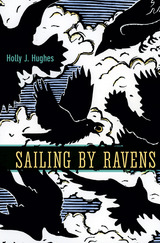 Sailing by Ravens
Holly J. Hughes
University of Alaska Press, 2014 Gillnetter, mariner, and naturalist Holly Hughes has experienced first-hand the practical and philosophical consequences of navigating difficult waters. In Sailing by Ravens, she gathers wisdom gained from thirty seasons working off Alaska’s shores, weaving personal experience and her love of the sea with the history and science of navigation. In this exquisite collection of poems, Hughes deftly navigates “the wavering, certain path” of a woman’s heart, finding that sometimes the best directions to follow are those that come from the natural forces in our lives. These meditations offer waypoints for readers on their own journeys.
“These poems of the sea begin with a school girl’s fascination for ‘the blue sea holding captive all the land’ and end as the seasoned sailor learns that ‘even the old charts/ can’t navigate the wild shoals of your heart.’ Along the way we are shipmates through days of fishing, sailing, loving, and losing as Hughes navigates the lure, lore, and loneliness of a sea that is both natural force and metaphor. I love Sailing by Ravens with its salt of the sea, salt of our deepest lives.”
—Gary Thompson, author of One Thing After Another
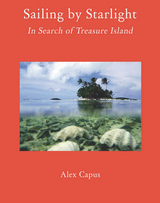 Sailing by Starlight: In Search of Treasure Island
Alex Capus
Haus Publishing, 2011 Capus takes us on an exploratory journey via the loss of a Spanish vessel laden with gold and jewels in the South Seas, the burial of treasure, an ancient map, and a long and dangerous voyage across the Pacific, to prove that Robert Louis Stevenson's "treasure island" actually exists; and that it exists in a place quite different from where hordes of treasure-hunters have been seeking it for generations. In fact, he posits, it was for this reason alone that Stevenson spent the last five years of his life in Samoa. On a long trip round the Pacific islands with the idea of writing articles for American periodicals, Stevenson, travelling with his beloved wife, Fanny, and stepson Lloyd Osbourne, had no notion of stopping at Samoa when their ship made landfall in December 1889. Yet, only six weeks later, at the age of 39, he would invest all his available assets in a patch of impenetrable jungle and spend the rest of his life there. This book traces what led Stevenson to Samoa and the origins of his famous story. For facing him from this unlikely spot was another island – a conical isle, Tafahi, where legends abound, and it was, Capus suggests, this isle that would cause him to change the course of his life.
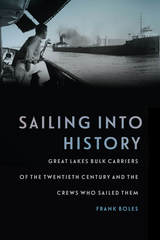 Sailing into History: Great Lakes Bulk Carriers of the Twentieth Century and the Crews Who Sailed Them
Frank Boles
Michigan State University Press, 2017 The Great Lakes create a vast transportation network that supports a massive shipping industry. In this volume, seamanship, cargo, competition, cooperation, technology, engineering, business, unions, government decisions, and international agreements all come together to create a story of unrivaled interest about the Great Lakes ships and the crews that sailed them in the twentieth century. This complex and multifaceted tale begins in iron and coal mines, with the movement of the raw ingredients of industrial America across docks into ever larger ships using increasingly complicated tools and technology. The shipping industry was an expensive challenge, as it required huge investments of capital, caused bitter labor disputes, and needed direct government intervention to literally remake the lakes to accommodate the ships. It also demanded one of the most integrated international systems of regulation and navigation in the world to sail a ship from Duluth to upstate New York. Sailing into History describes the fascinating history of a century of achievements and setbacks, unimagined change mixed with surprising stability.
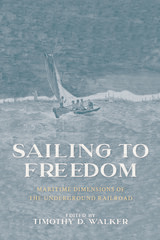 Sailing to Freedom: Maritime Dimensions of the Underground Railroad
Edited by Timothy D. Walker
University of Massachusetts Press, 2021 In 1858, Mary Millburn successfully made her escape from Norfolk, Virginia, to Philadelphia aboard an express steamship. Millburn's maritime route to freedom was far from uncommon. By the mid-nineteenth century, an increasing number of enslaved people had fled northward along the Atlantic seaboard. While scholarship on the Underground Railroad has focused almost exclusively on overland escape routes from the antebellum South, this groundbreaking volume expands our understanding of how freedom was achieved by sea and what the journey looked like for many African Americans.
With innovative scholarship and thorough research, Sailing to Freedom highlights little-known stories and describes the less-understood maritime side of the Underground Railroad, including the impact of African Americans' paid and unpaid waterfront labor. These ten essays reconsider and contextualize how escapes were managed along the East Coast, moving from the Carolinas, Virginia, and Maryland to safe harbor in northern cities such as Philadelphia, New York, New Bedford, and Boston.
In addition to the volume editor, contributors include David S. Cecelski, Elysa Engelman, Kathryn Grover, Megan Jeffreys, Cheryl Janifer LaRoche, Mirelle Luecke, Cassandra Newby-Alexander, Michael D. Thompson, and Len Travers.
Sailing to the Far Horizon: The Restless Journey and Tragic Sinking of a Tall Ship
Pamela Sisman Bitterman
University of Wisconsin Press, 2004 The tall ship Sofia sank off New Zealand’s North Island in February 1982, stranding its crew on disabled life rafts for five days. They struggled to survive as any realistic hope of rescue dwindled. Just a few years earlier, Pamela Sisman Bitterman was a naïve swabbie looking for adventure, signing on with a sailing co-operative taking this sixty-year-old, 123-foot, three-masted gaff-topsail schooner around the globe. The aged Baltic trader had been rescued from a wooden boat graveyard in Sweden and reincarnated as a floating commune in the 1960s. By the time Sofia went down, Bitterman had become an able seaman, promoted first to bos’un and then acting first mate, immersing herself in this life of a tall ship sailor, world traveler, and survivor.
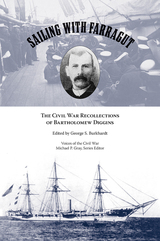 Sailing with Farragut: The Civil War Recollections of Bartholomew Diggins
George S. Burkhardt
University of Tennessee Press, 2016 Sailing with Farragut, the latest book in the Voices of the Civil War series, shows readers the war through the recollections of Bartholomew Diggins, a young sailor who fought under U.S. Admiral David G. Farragut in the battles for control of the Mississippi River. A recent Irish immigrant, Diggins joined the crew of the USS Hartford, Admiral Farragut’s flagship, at age seventeen and served for three years. Diggins’s memoir, one of a very few writtenby a sailor on either side, allows readers to experience a Northern seamen’s daily existence and the perilous battles he endured during the Civil War. Wounded during the first foiled approach to Vicksburg, Diggins, his side paralyzed by a guerrilla’s bullet from shore, richly describes the dangers and damage possible to a ship on the Mississippi. He recalls how action could suddenly shift from the mundane, like washing the decks, to a life-or-death skirmish with a hidden enemy as his ship passed rebel towns.
Additionally, Diggins describes how surreal war can be, writing of dark nights of smoke and fire using only the flash of the enemy’s guns to steer clear of the treacherous banks, of desperate crowds of slaves clambering for safe passage, and of a fire raft 150 feet long, filled with burning pine knots, set on a course of destruction among the Union’s ships. Each chapter features an introduction by editor George S. Burkhardt, who adds careful research and useful background information to the tales that follow. For historians of the Civil War, this book will deepen their understanding of brown-water warfare and put a face to the stories of victory and loss. From the bloody skirmishes around Vicksburg to Farragut’s disaster at Port Hudson and on to his victory at Mobile Bay, Sailing with Farragut gives readers a vivid view of life on the Mississippi during the Civil War and keen insight into the leader, officer, and man that was Admiral David Farragut.
GEORGE S. BURKHARDT is a retired newspaper editor and former owner-publisher of California’s smallest daily newspaper, the Corning Daily Observer. He is the author of Confederate Rage, Yankee Wrath: No Quarter in the Civil War and editor of Double Duty in the Civil War: The Letters of Sailor and Soldier Edward W. Bacon.
 Sailing with Noah: Stories from the World of Zoos
Jeffrey P. Bonner
University of Missouri Press, 2013 Written by the president of the nation’s number-one zoo, Sailing with Noah is an intensely personal, behind-the-scenes look at modern zoos. Jeffrey P. Bonner, who was trained as an anthropologist and came to the zoo world quite by accident, shares some of the most compelling stories ever told about contemporary zoos. The stories jump between zoos in different cities and between countries on different continents. Some are fun and funny. Others are sad, even tragic. Pete Hoskins, the director of the Philadelphia Zoo, is in bed, sound asleep, when his phone rings. . . . “There’s been a fire in the World of Primates,” he is told. “You’ve got to get over here.” Whatever he has been dreaming, it is nothing like the nightmare he will find now that he is awake. . . . “They’re all gone. They’re all gone.” All of the animals in the building—the gorillas, the lemurs, the orangutans, and the gibbons—all twenty-three of them are dead. Written in a lively, accessible style, Sailing with Noah explores the role of zoos in today’s society and their future as institutions of education, conservation, and research. Along the way, Bonner relates a variety of true stories about animals and those who care for them (or abuse them), offering his perspective on heavily publicized incidents and describing less-well-known events with compassion and humor in turn. By bringing the stories of the animals’ lives before us, Bonner gives them a voice. He strongly believes that zoos must act for living things, and he argues that conservation is a shared responsibility of all mankind. This book helps us to understand why biodiversity is important and what it means to be a steward of life on earth. From the day-to-day aspects of caring for some of the world’s most exotic creatures to the role of zoos as field conservation organizations, saving wild things in wild places, this book takes the reader on an incredible journey—a journey that begins within the zoo and continues around the globe. Everyone—from zoo visitors to animal lovers to professional conservationists, the young and old alike—will be fascinated by this extraordinary book.
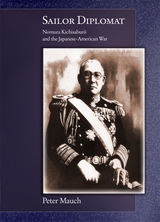 Sailor Diplomat: Nomura Kichisaburō and the Japanese-American War
Peter Mauch
Harvard University Press, 2011 The definitive biography of Hideki Tojo, the controversial general who redefined military leadership in Shōwa-era Japan before his downfall during World War II.
As Japan’s pre–Pearl Harbor ambassador to the United States, Admiral Nomura Kichisaburō (1877–1964) played a significant role in a tense and turbulent period in Japanese–U.S. relations. Scholars tend to view his actions and missteps as ambassador as representing the failure of diplomacy to avert the outbreak of hostilities between the two paramount Pacific powers.
This extensively researched biography casts new light on the life and career of this important figure. Connecting his experiences as a naval officer to his service as foreign minister and ambassador, and later as “father” of Japan’s Maritime Self Defense Forces and proponent of the U.S.–Japanese alliance, this study reassesses Nomura’s contributions as a hard-nosed realist whose grasp of the underlying realities of Japanese–U.S. relations went largely unappreciated by the Japanese political and military establishment.
In highlighting the complexities and conundrums of Nomura’s position, as well as the role of the Imperial Navy in the formulation of Japan’s foreign policy, Peter Mauch draws upon rarely accessed materials from naval and diplomatic archives in Japan as well as various collections of personal papers, including Nomura’s, which Mauch discovered in 2005 and which are now housed in the National Diet Library.
 Sailor Of The Air: The 1917-1919 Letters and Diary of USN CMM/A Irving Edward Sheely
Lawrence D. Sheely
University of Alabama Press, 1993 In the winter of 1917, with most of the world at war, twenty-three-year-old Irving Edward Sheely of Albany, New York, enlisted in Naval Aviation and began his training at Pensacola Naval Air Station. When Congress declared ware on Germany on April 6, 1917, the combined strength of aviation within the Navy and Marine Corps was 48 officers, 239 enlisted men, 54 airplanes, one airship, and one air station. Lieutenant Kenneth Whiting immediately recruited seven volunteer officers and 122 volunteer enlisted men with orders to go directly to France as the First Aeronautical Detachment. By June, the first organized contingent of American forces arrived in the combat zone at St. Nazaire, France—woefully unprepared to take on the mighty submarine force of Imperial Germany. Among this small detachment was Landsman Machinist Mate Second Class Irving E. Sheely. Trained by American and foreign officers, using both American and foreign aircraft, Sheely learned aviation and aviation combat at the heart of the action. He served as Observer/Gunlayer with Navy Lieutenant Kenneth MacLeish as pilot, and the two participated in some of the first antisubmarine air patrols in history, including a sea landing to rescue a downed crew. While at Clermont-Ferrand, Sheely developed an improved bombsight, for which he was praised by MacLeish. Following the Armistice, Sheely participated in the closing of the Navy base at Eastleigh, England, and returned to the United States in November 1918. Utilizing Sheely’s correspondence and meticulous diary spanning 19 months of training and service—mostly on foreign soil and in foreign aircraft—this book presents an unusual first person account of the wartime experience of naval aviation in World War I. Sheely’s letters and diary describe the many deprivations and inadequacies of the aviation program and show clearly the sacrifices made by the officers and enlisted men. He supplied for himself items, such as helmet and goggles, that later servicemen would expect the military to issue. In addition to wartime description, the letters reveal the young man’s concern for his family and his interest in home, so a very human story emerges.
Sails of the Herring Fleet: Essays on Beckett
Herbert Blau
University of Michigan Press, 2003 Sails of the Herring Fleet traces esteemed director and theorist Herbert Blau's encounters with the work of Samuel Beckett. Blau directed Beckett's plays when they were still virtually unknown, and for more than four decades has remained one of the leading interpreters of his work. In addition to now-classic essays, the collection includes early program notes and two remarkable interviews -- one from Blau's experience directing Waiting for Godot at San Quentin prison, and one from his last visit with Beckett, just before the playwright's death. Herbert Blau is Byron W. and Alice L. Lockwood Professor of the Humanities, University of Washington.
 The Saint and the Atheist: Thomas Aquinas and Jean-Paul Sartre
Joseph S. Catalano
University of Chicago Press, 2021 It is hard to think of two philosophers less alike than St. Thomas Aquinas and Jean-Paul Sartre. Aquinas, a thirteenth-century Dominican friar, and Sartre, a twentieth-century philosopher and atheist, are separated by both time and religious beliefs. Yet, for philosopher Joseph S. Catalano, the two are worth bringing together for their shared concern with a fundamental issue: the uniqueness of each individual person and how this uniqueness relates to our mutual dependence on each other. When viewed in the context of one another, Sartre broadens and deepens Aquinas’s outlook, updating it for our present planetary and social needs. Both thinkers, as Catalano shows, bring us closer to the reality that surrounds us, and both are centrally concerned with the place of the human within a temporal realm and what stance we should take on our own freedom to act and live within that realm. Catalano shows how freedom, for Sartre, is embodied, and that this freedom further illuminates Aquinas’s notion of consciousness.
Compact and open to readers of varying backgrounds, this book represents Catalano’s efforts to bring a lifetime of work on Sartre into an accessible consideration of philosophical questions by placing him in conversation with Aquinas, and it serves as a primer on key ideas of both philosophers. By bringing together these two figures, Catalano offers a fruitful space for thinking through some of the central questions about faith, conscience, freedom, and the meaning of life.
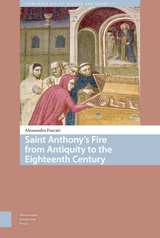 Saint Anthony's Fire from Antiquity to the Eighteenth Century
Alessandra Foscati
Amsterdam University Press, 2020 After the discovery of the ergotism epidemics (poisoning caused by ingesting the fungal toxin of rye) and its etiology, eighteenth-century physicians interpreted medieval chronicles in their medical texts in order to recognize the occurrences of ergotic diseases through retrospective diagnosis. They assumed that St. Anthony's fire and ignis sacer ("sacred fire") recorded in medieval texts represented the same disease, ergotism. This interpretative method, lacking a textual basis in the sources, has been incorrectly followed by historians till now. This book examines this historical prejudice through textual analysis, comparing diverse medieval and early modern sources. A striking semantic complexity emerges that changes the concept of St. Anthony's fire and modifies our understanding of diseases in general. This research illuminates aspects of the history of medicine, society, and hospitals.
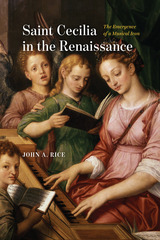 Saint Cecilia in the Renaissance: The Emergence of a Musical Icon
John A. Rice
University of Chicago Press, 2022 This study uncovers how Saint Cecilia came to be closely associated with music and musicians.
Until the fifteenth century, Saint Cecilia was not connected with music. She was perceived as one of many virgin martyrs, with no obvious musical skills or interests. During the next two centuries, however, she inspired many musical works written in her honor and a vast number of paintings that depicted her singing or playing an instrument.
In this book, John A. Rice argues that Cecilia’s association with music came about in several stages, involving Christian liturgy, visual arts, and music. It was fostered by interactions between artists, musicians, and their patrons and the transfer of visual and musical traditions from northern Europe to Italy. Saint Cecilia in the Renaissance explores the cult of the saint in Medieval times and through the sixteenth century when musicians’ guilds in the Low Countries and France first chose Cecilia as their patron. The book then turns to music and the explosion of polyphonic vocal works written in Cecilia’s honor by some of the most celebrated composers in Europe. Finally, the book examines the wealth of visual representations of Cecilia especially during the Italian Renaissance, among which Raphael’s 1515 painting, The Ecstasy of Saint Cecilia, is but the most famous example. Thoroughly researched and beautifully illustrated in color, Saint Cecilia in the Renaissance is the definitive portrait of Saint Cecilia as a figure of musical and artistic inspiration.
Saint Christopher: A Novella
José Maria De Eça De Queirós
Tagus Press, 2015 Set in the Middle Ages but written in the early twentieth century, Eça de Queirós's novella, Saint Christopher, is a powerful indictment of those who profess the value of morality but who do not practice it. The narrative is just as relevant today—when issues of religion, hypocrisy, and social justice are more urgent than ever—as it was when it first appeared in 1912. Written as though it were the product of a dialogue between Jesus and Proudhon (whose theories animate much of the narrative), Saint Christopher challenges today's ethically motivated reader to do what the narrative's protagonist does, that is, take up the cause of the wretched and abused of this earth.
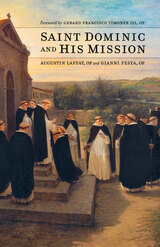 Saint Dominic and His Mission
Augustin Laffay
Catholic University of America Press, 2025 Saint Dominic had dedicated himself to a life of prayer and study as a canon regular at the Cathedral of Osma, Spain in 1197. When on a diplomatic mission through southern France, Dominic and his bishop, Diego, encountered the Cathar heresy. The Spaniards were filled with compassion and sought to counter this heresy by preaching and the example of their holy life. In the ensuing years, and with ecclesiastical approval, Dominic would gather around him a group of men, living a common life in evangelical poverty and dedicated to preaching for the salvation of souls, these were the first members of the Order of Preachers, commonly known as Dominicans.
In Saint Dominic and His Mission, two of Saint Dominic’s spiritual sons present a portrait of this Preacher of Grace using extensive research from the archives of the Order to present Dominic and his brethren in their historical context. The first section comprises two parts: a biographical sketch and an evaluation of hagiographic and historical accounts of the life of St. Dominic. It is said that St. Dominic’s gift to the Church is not extensive writings, but a way of life. The second section describes aspects of this distinctly evangelical form life including study and preaching, fraternal life, choral office and the rosary, democratic government, and living in the heart of the Church. In the third section, the authors enlist the help of art historians who present multiple pieces of artwork, ancient and modern, to better know and understand this Doctor of Truth. The final section is a chronology of the life of St. Dominic based on the work of the renowned English Dominic Simon Tugwell, OP. Readers will find that Saint Dominic, whose life and preaching was centered on the Word Incarnate, is a perfect friend and guide to us today as we experience a revival in reverence for the Eucharist and the Sacred Heart of Jesus.
Saint Genet: Actor and Martyr
Jean-Paul Sartre
University of Minnesota Press, 2012
Saint Genet is Jean-Paul Sartre’s classic biography of Jean Genet—thief, convict, and great artist—a character of almost legendary proportions whose influence grows stronger with time. Bringing together two of the century’s greatest minds and artists, Saint Genet is at once a compelling psychological portrait, masterpiece of literary criticism, and one of Sartre’s most personal and inspired philosophical creations.
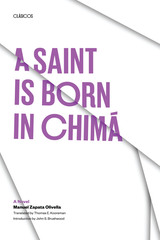 A Saint Is Born in Chima: A Novel
By Manuel Zapata Olivella
University of Texas Press, 1991 When the paralyzed cripple Domingo Vidal is rescued unsinged from a burning house, the people of Chima believe they have witnessed a miracle. Domingo becomes their patron "saint," and tales of his miracles multiply. Domingo makes the rains come, cures the blind and lame, and swells barren wombs with new life. But is Domingo really a saint, or is he a pagan idol? Padre Berrocal calls the people heretics, but they are afraid not to worship Domingo. To what excesses will superstition and ignorance drive the frightened people of Chima? This novel, published in 1963 as En Chimá nace un santo, makes important connections between the frustrations of poverty and the excesses of religious fanaticism. Zapata Olivella indicts the dogmatic attitudes of religious and civil institutions as a major cause of the creation of local cults like the one that grows up around "Saint" Domingo. In Zapata Olivella's compelling narrative, the struggle over Domingo points up both the inflexibility of established institutions and the potential power for change that lies within the hands of a determined populace.
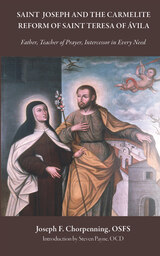 Saint Joseph and the Carmelite Reform of Saint Teresa of Avila: Father, Teacher of Prayer, Intercessor in Every Need
Joseph F. Chorpenning, OSFS
Catholic University of America Press, 2024 It is a commonplace in devotional literature, historical scholarship, and papal writings that Saint Teresa of Ávila played a key role in the development of veneration of Saint Joseph. Saint Joseph and the Carmelite Reform of Saint Teresa of Ávila unpacks this commonplace by recovering the often-overlooked back story to Teresa’s story, namely, the extraordinarily rich liturgical cult of Saint Joseph in the Ancient Order of Carmel which fully flowered in the Teresian Carmel and beyond, to the universal Church.
This volume charts a narrative arc from the liturgical cult of Saint Joseph in the Carmelite Order of Ancient Observance; to Saint Joseph’s vital formative presence in Saint Teresa’s life and reformed Carmel as father, teacher of prayer, and intercessor in every need; to the Carmelite family as a whole giving liturgical expression to its privileged relationship with Saint Joseph by the establishment of the Feast of the Patronage of Saint Joseph; to this feast becoming widespread outside Carmel and ultimately extended to the Universal Church (1847); and, finally, to Saint Joseph’s proclamation as Patron of the Universal Church (1870).
An epilogue considers the absence of Joseph’s title “Patron of the Universal Church” in the post-Vatican II liturgical calendar and books, while the papal magisterium has consistently insisted that this patronage is ever necessary for the Church as not only a protection against all dangers, but also an impetus for its mission of evangelization and re-evangelization. An appendix reprints the letter, “Saint Joseph, Patron of Carmel,” jointly issued by the Prior General of the Order of Carmelites of the Ancient Observance and the Superior General of the Order of Discalced Carmelites, to mark the 150th anniversary of the proclamation of Saint Joseph as Patron of the Universal Church.
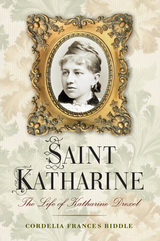 Saint Katharine: The Life of Katharine Drexel
Cordelia Frances Biddle
Westholme Publishing, 2015 A Gilded-Age Woman Who Devoted Her Life and Fortune to the American Dispossessed, Established Her Own Religious Order, and Was Ultimately Canonized
When Katharine Drexel was born in 1858, her grandfather, financier Francis Martin Drexel, had a fortune so vast he was able to provide a loan of sixty million dollars to the Union’s cause during the Civil War. Her uncle and mentor, Anthony, established Drexel University to provide instruction to the working class regardless of race, religion, or gender. Her stepmother was Emma Bouvier whose brother, John, became the great-grandfather of Jacqueline Bouvier Kennedy Onassis. Katharine Drexel’s family were American royalty. As a Philadelphia socialite, “Kitty,” as she was often called, adored formal balls and teas, rowing regattas, and sailing races. She was beautiful, intelligent, and high-spirited. But when her stepmother died in 1883, and her father two years later, a sense of desolation nearly overwhelmed her. She was twenty-seven and in possession of a staggering inheritance. Approached for aid by the Catholic Indian Missions, she surprised her family by giving generously of money and time. It was during this period of acute self-examination that she journeyed to Rome for a private audience with Pope Leo XIII. With characteristic energy and fervor, she detailed the plight of the Native Americans, and begged for additional missionaries to serve them. His reply astonished her. “Why not, my child, yourself become a missionary?”
In Saint Katharine: The Life of Katharine Drexel, Cordelia Frances Biddle recounts the extraordinary story of a Gilded Age luminary who became a selfless worker for the welfare and rights of America’s poorest persons. After years of supporting efforts on behalf of African Americans and American Indians, Katharine finally decided to follow her inner voice and profess vows. The act made headlines. Like her father and grandfather, she was a shrewd businessperson; she retained her financial autonomy and established her own order, the Sisters of the Blessed Sacrament. Until her death in 1955, she devoted herself and her inheritance to building much-needed schools in the South and Southwest, despite threats from the Ku Klux Klan and others. Pragmatic, sometimes willful, ardent, and a charismatic leader, Katharine Drexel was an indefatigable champion of justice and parity. When illness incapacitated her in later years, divine radiance was said to emanate from her, a radiance that led to her canonization on October 1, 2000.
 Saint Louis
Jacques Le Goff
University of Notre Dame Press, 2009
“Life of a king, life of a saint, life of a man. In this work, Jacques LeGoff, one of the truly great medieval historians of our times, magisterially plumbs the depths of the fundamental contradiction of Saint Louis: is it possible to be both a king and a saint? St. Louis lies at the intersection of reasons of state and divine reason; he is an individual around whom LeGoff turns like a detective searching for an ever-elusive truth, that of a life and a legend inextricably intertwined. A fine, eminently readable translation. “ —Robert J. Morrissey, University of Chicago
Canonized in 1297 as Saint Louis, King Louis IX of France (1214–1270) was the central figure of Christendom in the thirteenth century. He ruled when France was at the height of power; he commanded the largest army in Europe and controlled the wealthiest kingdom. Renowned for his patronage of the arts, Louis was equally famous for his decision to imitate the suffering Christ as a humbly attired, bearded penitent.
Armed with the considerable resources of the nouvel historien, Jacques Le Goff mines existing materials about Saint Louis to forge a new historical biography of the king. Part of his ambitious project is to reconstruct the mental universe of the thirteenth century: Le Goff describes the scholastic and intellectual background of Louis’ reign and, most importantly, he discusses methodology and the interpretation of written sources—their composition, provenance, and reliability.
Le Goff divides his unconventional biography into three parts. In the first, he gives us the contours of Louis’ life from birth to death in the usual context of family dynamics and genealogy, courtly and regional politics, and shifts in economic, social, and cultural life. In sifting through the historical accounts of the king’s life, Le Goff determines that it is Louis IX’s profound sense of moral and religious purpose—his desire to become the ideal Christian ruler—that colors his every action from boyhood on; it is also, for Le Goff, what renders contemporary accounts problematic and what necessitates further scrutiny.
That dissection of sources occupies the second part. Le Goff’s intention is to pare away the layers of homily and anecdote produced by the king’s early biographers to discover the true Saint Louis. Questioning whether Saint Louis was merely the invention of his eulogists, Le Goff penetrates beyond the literary and hagiographical evidence to the human behind the legend. He brilliantly analyzes Louis’ progress toward his unique self-creation and its subsequent mythologizing. In the third part, Le Goff highlights the contradictions within Louis and his historical image that previous chroniclers have elided or overlooked. In the end, he leaves us with the saint, rather than the king, with all the paradoxes embedded in that role.
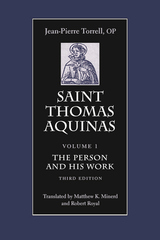 Saint Thomas Aquinas: The Person and His Work
Jean-Pierre Torrell, OP
Catholic University of America Press, 2022 The presentation of the life and work of any great thinker is a formidable task, even for a renowned scholar. This is all the more the case when such a historical figure is a saint and mystic, such as Friar Thomas Aquinas. In this volume, Fr. Jean-Pierre Torrell, OP, masterfully takes up the strenuous task of presenting such a biography, providing readers with a detailed, scholarly, and profound account of the thirteenth-century theologian whose works have not ceased to draw the attention of both friend and foe! In this volume, Fr. Torrell, an internationally renowned expert on St. Thomas, speaks to neophytes and experts alike: for those new to Thomas’s works, he paints an engaging human portrait of Friar Thomas in his historical context; for specialists, he provides a rigorous scholarly account of contemporary research concerning Thomas’s life and work. This new edition of Fr. Torrell’s widely-lauded text involved significant revision, expansion, and bibliographical updates in light of the latest scholarship. The Catholic University of America Press is pleased to present such an eminent specialist’s mature synthesis concerning Friar Thomas Aquinas.
Saint Thomas Aquinas, Volume 2: Spiritual Master
Jean-Pierre Torrell
Catholic University of America Press, 1996 Following his highly acclaimed study of the life and works of Saint Thomas Aquinas, Jean-Pierre Torrell, O.P., continues his masterful work on the great Dominican theologian and brings an immense learning to bear on a subject that most readers have not considered very carefully: Thomas's spirituality
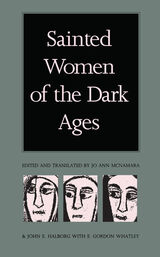 Sainted Women of the Dark Ages
Jo Ann McNamara, John E. Halborg, and Gordon Whatley, eds.
Duke University Press, 1992 Sainted Women of the Dark Ages makes available the lives of eighteen Frankish women of the sixth and seventh centuries, all of whom became saints. Written in Latin by contemporaries or near contemporaries, and most translated here for the first time, these biographies cover the period from the fall of the Roman Empire and the conversion of the invading Franks to the rise of Charlemagne's family.
Three of these holy women were queens who turned to religion only after a period of intense worldly activity. Others were members of the Carolingian family, deeply implicated in the political ambitions of their male relatives. Some were partners in the great Irish missions to the pagan countryside and others worked for the physical salvation of the poor. From the peril and suffering of their lives they shaped themselves as paragons of power and achievement. Beloved by their sisters and communities for their spiritual gifts, they ultimately brought forth a new model of sanctity.
These biographies are unusually authentic. At least two were written by women who knew their subjects, while others reflect the direct testimony of sisters within the cloister walls. Each biography is accompanied by an introduction and notes that clarify its historical context. This volume will be an excellent source for students and scholars of women's studies and early medieval social, religious, and political history.
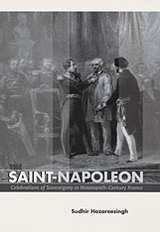 The Saint-Napoleon: Celebrations of Sovereignty in Nineteenth-Century France
Sudhir Hazareesingh
Harvard University Press, 2004 In 1852, President Louis Napoleon of France declared that August 15--Napoleon Bonaparte's birthday--would be celebrated as France's national day. Leading up to the creation of the Second Empire, this was the first in a series of attempts to "Bonapartize" his regime and strengthen its popular legitimacy. Across France, public institutions sought to draw local citizens together to celebrate civic ideals of unity, order, and patriotism. But the new sense of French togetherness was fraught with tensions.
Drawing on a wealth of archival evidence, Sudhir Hazareesingh vividly reconstructs the symbolic richness and political complexity of the Saint-Napoleon festivities in a work that opens up broader questions about the nature of the French state, unity and lines of fracture in society, changing boundaries between public and private spheres, and the role of myth and memory in constructing nationhood. The state's Bonapartist identity was at times vigorously contested by local social, political, and religious groups. In various regions, people used the national day to celebrate their own communities and to honor their hometown veterans; but elsewhere, the revival of republican sentiment clashed sharply with imperial attitudes.
Sophisticated and gracefully written, this book offers rich insights into modern French history and culture.
 Saints and Feasts of the Liturgical Year
Joseph N. Tylenda, SJ
Georgetown University Press, 2003 Revised and updated edition of the perennial Georgetown University Press classic, Saints of the Liturgical Year, this beautiful and comfortably sized guide is compact, but brimming with information. This edition includes over 260 brief biographies, including 33 new entries, as well as a glossary of terms to help explain the theology of the Roman Catholic Church. Based on the General Roman Calendar, presently in use in the Roman Catholic Church, it also includes the feasts, Saints, and Blesseds from the Liturgical Calendar of the Society of Jesus—known as the Jesuits—as officially observed within the Society of Jesus. Offering inspiration and encouragement, Saints and Feasts of the Liturgical Year functions as an aid in introducing the faithful to the day's feast or to the saint whose memorial is being celebrated. As a gift, for personal or group study, and helpful for introducing parishioners to the history of the church, this book can also be used as a source of ideas for all pastors.
Saints and Postmodernism: Revisioning Moral Philosophy
Edith Wyschogrod
University of Chicago Press, 1990 "In this exciting and important work, Wyschogrod attempts to read contemporary ethical theory against the vast unwieldy tapestry that is postmodernism. . . . [A] provocative and timely study."—Michael Gareffa, Theological Studies
"A 'must' for readers interested in the borderlands between philosophy, hagiography, and ethics."—Mark I. Wallace, Religious Studies Review
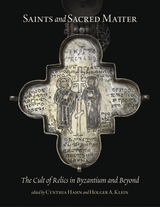 Saints and Sacred Matter: The Cult of Relics in Byzantium and Beyond
Cynthia Hahn
Harvard University Press Enshrined in sumptuous metal, ivory, or stone containers, relics formed an important physical and spiritual bond between heaven and earth, linking humankind to their saintly advocates in heaven. As they were carried in liturgical processions, used in imperial ceremonies, and called upon in legal disputes and crises, relics—and, by extension, their precious containers and built shrines—provided a visible link between the living and the venerated dead. Saints and Sacred Matter explores the embodied aspects of the divine—physical remains of holy men and women and objects associated with them. Contributors explore how those remains, or relics, linked the past and present with an imagined future. Many of the chapters focus on the Christian context, both East and West, where relics testified to Christ’s presence and ministry on earth and established a powerful connection between God and humans after his resurrection. Other religious traditions from the ancient world such as Judaism and Islam are frequently thought to have had no relics, but contributions to this volume show that Muslims and Jews too had a veneration for the corporeal that is comparable to that of their Christian counterparts.
Saints and Society: The Two Worlds of Western Christendom, 1000-1700
Donald Weinstein and Rudolph M. Bell
University of Chicago Press, 1986 In Saints and Society, Donald Weinstein and Rudolph M. Bell examine the lives of 864 saints who lived between 1000 and 1700 and the perceptions of sanctity prevalent in late medieval and early modern Europe. They also provide a substantial body of information on the people among whom the saints lived and by whom they came to be venerated. In the first part, the authors give close consideration to what the saints' lives reveal about childhood, adolescence, and adulthood; the impact of religious inspiration upon family bonds; and family influences upon religious behavior. The second part provides a composite picture of piety and its changing configuration in Latin Christendom. With the assistance of statistical analysis, the authors answer questions involving the popular perception of holiness, social class, and gender.
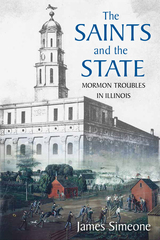 The Saints and the State: The Mormon Troubles in Illinois
James Simeone
Ohio University Press, 2021 A compelling history of the 1846 Mormon expulsion from Illinois that exemplifies the limits of American democracy and religious tolerance. When members of the Church of Jesus Christ of Latter-day Saints (known as Mormons) settled in Illinois in 1839, they had been persecuted for their beliefs from Ohio to Missouri. Illinoisans viewed themselves as religiously tolerant egalitarians and initially welcomed the Mormons to their state. However, non-Mormon locals who valued competitive individualism perceived the saints‘ western Illinois settlement, Nauvoo, as a theocracy with too much political power. Amid escalating tensions in 1844, anti-Mormon vigilantes assassinated church founder Joseph Smith and his brother Hyrum. Two years later, the state expelled the saints. Illinois rejected the Mormons not for their religion, but rather for their effort to create a self-governing state in Nauvoo. Mormons put the essential aspirations of American liberal democracy to the test in Illinois. The saints’ inward group focus and their decision to live together in Nauvoo highlight the challenges strong group consciousness and attachment pose to democratic governance. The Saints and the State narrates this tragic story as an epic failure of governance and shows how the conflicting demands of fairness to the Mormons and accountability to Illinois’s majority became incompatible.
 Saints As They Really Are: Voices of Holiness in Our Time
Michael Plekon
University of Notre Dame Press, 2012
In his new book, Saints As They Really Are, priest and scholar Michael Plekon traces the spiritual journeys of several American Christians, using their memoirs and other writings. These “saints-in-the-making” show all their doubts and imperfections as they reflect on their search for God and their efforts to lead holy lives. They are gifted yet ordinary women and men trying to follow Christ within their flawed and broken humanity—“saints as they really are,” as Dorothy Day put it.
Saints As They Really Are is the third book in Plekon’s critically acclaimed series on saints and holiness in our time. He draws on the autobiographical work of Dorothy Day, Peter Berger, Thomas Merton, Kathleen Norris, and Barbara Brown Taylor, among others, as well as from his own experiences as a Carmelite seminarian and brother. Plekon shares the power of these individuals’ stories as they unfold. The book offers a strong argument that our failings and weaknesses are not disqualifications to holiness. Plekon further confronts the institutional church and its relationship to individuals seeking God, focusing on some of the challenges to this search—the destructive potential of religion and religious institutions, as well as our personal tendencies to extremism, overwork, pious obsessions, and legalism. But he also underscores the healing qualities of faith and the spiritual life. Plekon's insights will help readers better understand their own spiritual pilgrimages as they learn how others have dealt with the trials and joys of their path to everyday holiness.
“This is the third in a progression of books by Michael Plekon that have served to expand our understanding of saints and holiness. In this new book, he has taken yet a further step in relating holiness to ordinary or everyday life by showing the contours of grace, or the harmonics of holiness, revealed in the Christian journey of a number of contemporary Christian memoirists. He shows how the gospel story of death-resurrection is written in the journey of ordinary Christians.” —Robert Ellsberg, author of All Saints
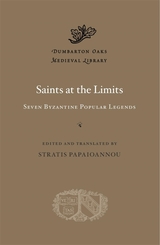 Saints at the Limits: Seven Byzantine Popular Legends
Stratis Papaioannou
Harvard University Press, 2023 A collection of medieval tales of Byzantine saints, including some rejected by the Church, translated into English for the first time.
The legends collected in Saints at the Limits, despite sometimes being viewed with suspicion by the Church, fascinated Christians during the Middle Ages—as related cults, multiple retellings, and contemporary translations attest. Their protagonists span the entire spectrum of Byzantine society, including foreigners, soldiers, ascetics, lustful women, beggars, and the sons and daughters of rulers. They travel to exotic lands, perform outlandish miracles, suffer extraordinary violence, reject family ties, save cities, destroy absolute rulers, and discover the divine. Some saints, like Markos the Athenian, are forgotten nowadays; others, like Saint George the Great Martyr, still command a wide appeal. Each, however, negotiates the limits of Byzantine imagination: the borders that separate the powerful from the outcasts, the real from the imaginary, the human from the beyond human. These stories, edited in Greek and translated into English here for the first time, continue to resonate with readers seeking to understand universal human fears and desires in their Byzantine guise.
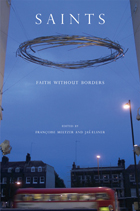 Saints: Faith without Borders
Edited by Françoise Meltzer and Jas Elsner
University of Chicago Press, 2011 While the modern world has largely dismissed the figure of the saint as a throwback, we remain fascinated by excess, marginality, transgression, and porous subjectivity—categories that define the saint. In this collection, Françoise Meltzer and Jas Elsner bring together top scholars from across the humanities to reconsider our denial of saintliness and examine how modernity returns to the lure of saintly grace, energy, and charisma. Addressing such problems as how saints are made, the use of saints by political and secular orders, and how holiness is personified, Saints takes us on a photo tour of Graceland and the cult of Elvis and explores the changing political takes on Joan of Arc in France. It shows us the self-fashioning of culture through the reevaluation of saints in late-antique Judaism and Counter-Reformation Rome, and it questions the political intent of underlying claims to spiritual attainment of a Muslim sheikh in Morocco and of Sephardism in Israel. Populated with the likes of Francis of Assisi, Teresa of Avila, and Padre Pio, this book is a fascinating inquiry into the status of saints in the modern world.
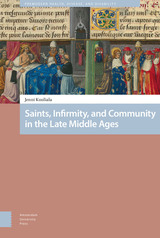 Saints, Infirmity, and Community in the Late Middle Ages
Jenni Kuuliala
Amsterdam University Press, 2020 Bodily suffering and patient, Christlike attitudes towards that suffering were among the key characteristics of sainthood throughout the medieval period. Saints, Infirmity, and Community in the Late Middle Ages analyses the meanings given to putative saints’ bodily infirmities in late medieval canonization hearings. How was an individual saint’s bodily ailment investigated in the inquests, and how did the witnesses (re)construct the saintly candidates’ ailments? What meanings were given to infirmity when providing proofs for holiness? This study depicts holy infirmity as an aspect of sanctity that is largely defined within the community, in continual dialogue with devotees, people suffering from doubt, the holy person, and the cultural patterns ascribed to saintly life. Furthermore, it analyses how the meanings given to saints’ infirmities influenced and reflected society’s attitudes towards bodily ailments — or dis/ability — in general.
 Saints' Lives
Henry of Avranches
Harvard University Press, 2014 The artistry, wit, and erudition of medieval Latin narrative poetry continued to thrive well into the middle of the thirteenth century. No better evidence of this survives than in the long and brilliantly successful career of Henry of Avranches (d. 1262). Professional versifier to abbots, bishops, kings, and at least one pope, Henry displays a pyrotechnical verbal skill and playfulness that rivals that of the Carmina Burana and similar collections of rhymed secular verse. Yet he also stands as self-conscious heir to the great classicizing tradition of the twelfth-century epic poets, above all of Walter of Châtillon. Henry entwines these two strands of his literary inheritance in what might surprise modern readers as an improbable genre. The bulk of Henry’s known output is a series of versified saints’ lives, including those of Francis of Assisi, King Edmund, and Thomas Becket, nearly all of which are based on identified prose models. These two volumes present most of his work in the genre, as witnessed in the English manuscript that remains the linchpin of our knowledge of this remarkable poet’s career.
 Saints' Lives
Henry of Avranches
Harvard University Press, 2014 The artistry, wit, and erudition of medieval Latin narrative poetry continued to thrive well into the middle of the thirteenth century. No better evidence of this survives than in the long and brilliantly successful career of Henry of Avranches (d. 1262). Professional versifier to abbots, bishops, kings, and at least one pope, Henry displays a pyrotechnical verbal skill and playfulness that rivals that of the Carmina Burana and similar collections of rhymed secular verse. Yet he also stands as self-conscious heir to the great classicizing tradition of the twelfth-century epic poets, above all of Walter of Châtillon. Henry entwines these two strands of his literary inheritance in what might surprise modern readers as an improbable genre. The bulk of Henry’s known output is a series of versified saints’ lives, including those of Francis of Assisi, King Edmund, and Thomas Becket, nearly all of which are based on identified prose models. These two volumes present most of his work in the genre, as witnessed in the English manuscript that remains the linchpin of our knowledge of this remarkable poet’s career.
Saints' Lives and Bible Stories for the Stage: A Bilingual Edition
Antonia Pulci
Iter Press, 2010 This fresh translation of five plays securely authored by Antonia Pulci—one of the first published women writers in Renaissance Florence—reveals this gifted dramatist at her finest. Intended primarily for a convent audience, Pulci’s plays give us a fascinating glimpse into how theatrical expressions of female religiosity were animated by both exemplary female saints’ lives and contemporary debates over marriage and virginity. There is much to recommend in this new bilingual presentation. The translations sparkle; and Weaver’s elegant, erudite introduction and her publication of new archival materials not only enrich the historical record concerning Pulci’s life and works but also set it straight.
—Sharon Strocchia
Professor of History, Emory University
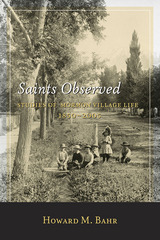 Saints Observed: Studies of Mormon Village Life, 1850-2005
Howard M. Bahr
University of Utah Press, 2014 The most complete overview and assessment of Mormon village studies available, this volume extends the canon twofold. First, it presents a rich composite view of nineteenth-century Mormon life in the West as seen by qualified observers who did not just pass through but stopped and studied. Second, it connects that early protoethnography to scholarly Mormon village studies in the twentieth century, showing their proper context in the thriving field of community studies. Based mostly on nine famous travelers’ accounts of life among the Mormons, including Richard Burton, Elizabeth Kane, Howard Stansbury, John Gunnison, and Julius Benchley—Bahr’s volume introduces these talented observers, summarizes and analyzes their observation, and constructs a holistic overview of Mormon village life. He concludes by tracing the rise and continuity of Mormon village studies in the twentieth century, beginning with Lowry Nelson’s 1923 research in Escalante, Utah. Over the following three decades, the genre expanded beyond Nelson and his students, becoming more sophisticated and interdisciplinary; by the mid-1950s it was a subfield within the respected arena of community studies. Researchers continued to study Mormon communities in the following decades and into the twenty-first century.
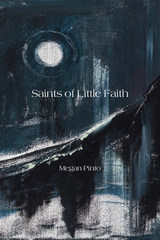 Saints of Little Faith
Megan Pinto
Four Way Books, 2024 The energies animating Saints of Little Faith, Megan Pinto’s electrifying debut in poetry, are a forceful quiet, a loud stillness, the caesura between a lightning strike and the sound of thunder. Everywhere, the speaker sees the numinous power of language, the incipience of things to come, even a kind of catastrophic grace in desolation and destruction — as if within the terrain of her own obsession, she recognizes the familiar, ever-changing seasons. Fierce and intimate, this poet’s meditative transformations engage with South Asian experiences of addiction, domestic violence, and mental illness, refusing to ignore narratives treated as unspeakable and overlooked by the English canon. Mapping the collision of abuse, psychosis, and rage, Pinto sees beyond them, buoyed by an inscrutable but abiding faith in the holiness of life itself, in a cold God nevertheless capable of gentleness. Once, “desire was an arrow, but now desire / is the field.” Pinto presides over this expanse, deciding, “I have three choices: to drift through life / anesthetized, to soften. . .” In that unspoken “or,” the merciful lacuna of that ellipsis, reside the lyrical mystery and medicine that feed this astonishing collection and strengthen resolve, both ours and the speaker’s: “The lake looks frozen, but it is not.”
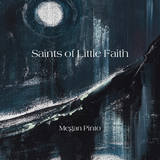 Saints of Little Faith
Megan Pinto
Four Way Books, 2024 The energies animating Saints of Little Faith, Megan Pinto’s electrifying debut in poetry, are a forceful quiet, a loud stillness, the caesura between a lightning strike and the sound of thunder. Everywhere, the speaker sees the numinous power of language, the incipience of things to come, even a kind of catastrophic grace in desolation and destruction — as if within the terrain of her own obsession, she recognizes the familiar, ever-changing seasons. Fierce and intimate, this poet’s meditative transformations engage with South Asian experiences of addiction, domestic violence, and mental illness, refusing to ignore narratives treated as unspeakable and overlooked by the English canon. Mapping the collision of abuse, psychosis, and rage, Pinto sees beyond them, buoyed by an inscrutable but abiding faith in the holiness of life itself, in a cold God nevertheless capable of gentleness. Once, “desire was an arrow, but now desire / is the field.” Pinto presides over this expanse, deciding, “I have three choices: to drift through life / anesthetized, to soften. . .” In that unspoken “or,” the merciful lacuna of that ellipsis, reside the lyrical mystery and medicine that feed this astonishing collection and strengthen resolve, both ours and the speaker’s: “The lake looks frozen, but it is not.”
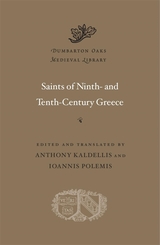 Saints of Ninth- and Tenth-Century Greece
Anthony Kaldellis
Harvard University Press, 2019 Saints of Ninth- and Tenth-Century Greece collects funeral orations, encomia, and narrative hagiography. Together, these works illuminate one of the most obscure periods of Greek history—when holy men played central roles as the Byzantine administration reimposed control on southern and central Greece in the wake of Avar, Slavic, and Arab attacks and the collapse of the late Roman Empire. The bishops of the region provided much-needed leadership and institutional stability, while ascetics established hermitages and faced invaders. The Lives gathered here include accounts of Peter of Argos, which offers insight into episcopal authority in medieval Greece, and Theodore of Kythera, an important source for the history of piracy in the Aegean Sea.
This volume, which illustrates the literary variety of saints’ Lives, presents Byzantine Greek texts written by locals in the provinces and translated here into English for the first time.
|
|
